2025/03/21Number of reading(23595)Number of comments(0)
一、Target Audience
Operators, Ad Specialists
二、Feature Introduction
SellerSpace's "Advertising Campaigns" feature elevates Amazon campaign management. Going beyond the standard Amazon Ads platform, it empowers sellers with in-depth campaign performance analysis, including historical trends, 24-hour traffic patterns, and associated product purchases. Plus, it streamlines campaign creation with bulk actions, automates campaign optimization, and ensures real-time data synchronization with Amazon Seller Central.
Through SellerSpace's advertising system, sellers can completely bypass Seller Central and perform all analysis and maintenance operations related to advertising campaigns directly within the system. By leveraging various value-added features, sellers can achieve refined advertising and improve advertising ROI.
三、Synchronization Mechanism
1. After successful authorization, it takes approximately 2-3 hours to automatically synchronize advertising data from Amazon for the last 60 days via the official Amazon API, and data is updated approximately every 30-60 minutes.
2. After the data synchronization for the last 60 days is completed, advertising data for the last 2 days will be updated approximately every 30-60 minutes. Advertising data for the last 3-60 days will be updated once a day, referencing Amazon's advertising attribution window.
3. Unlike Amazon, which only retains advertising data for the last 2 months, SellerSpace retains all synchronized advertising data for seller analysis and reference.
Data synchronization through the API has a time lag, especially when new advertising is created or adjusted in Seller Central. It is not synchronized to SellerSpace in real-time. At this time, we can manually synchronize data for real-time updates.
How to manually synchronize? Click to view
四、Use Cases
- Create Sponsored Products (SP), Sponsored Brands (SB), and Sponsored Display (SD) campaigns, supporting copy creation and bulk creation
- Create campaign portfolios and set category tags for campaigns for categorized management
- Analyze all advertising data, supporting filtering by performance, with added dimensions: historical performance, 24-hour hourly trends, associated purchases, etc.
- Adjust all campaign settings, such as: campaign information, budget, budget cap, portfolio, Enable/Pause status, placement bids, etc.
- Link with Keyword Rank Tracker, Keyword Position Targeting, Scheduled Strategy, and Automation Strategy features to achieve refined operations
五、Operation Guide
SellerSpace Tips: This article is lengthy. It is recommended to first look at the table of contents on the left to directly locate the section you want to view.
1. Create a New Campaign
The SellerSpace system can automatically synchronize advertising campaigns from Seller Central. In addition, we can also directly create new campaigns, including three types: Sponsored Products (SP), Sponsored Brands (SB), and Sponsored Display (SD). The new creation operation is generally the same as the new creation operation in Seller Central, and some operation processes have been optimized to make it easier for us to understand and operate, such as: associating with your own keyword library and product library to quickly deploy advertising.
Moreover, we have further optimized efficiency for campaign creation, supporting direct creation by copying existing campaigns and bulk creation of campaigns and Ad groups through the "Campaign Generator."
First, let's look at creating a campaign individually.
Click 【Add Campaign】 to enter and select the type to create: Sponsored Products, Sponsored Brands, or Sponsored Display.
 +
+
1.1 Sponsored Products Campaigns (SP)
Sponsored Products is a pay-per-click advertising solution that can promote products for sale through advertising, and this type of advertising may appear in very prominent ad placements on Amazon.
Sponsored Products ads are divided into 2 types: 【Automatic Targeting】 and 【Manual Targeting】. The settings are different depending on their different targeting methods.
Automatic targeting directly targets promoted products through 4 automatic matching methods: close match and broad match (keywords), and product substitutes and complements (ASINs).
Manual targeting targets promoted products through set keywords or products and corresponding match types.
 +
+
(Click to enlarge)
1) Creating 【Automatic Targeting】 Campaigns
Take "creating a new product: ASIN, automatic campaign, daily budget of \$30, promotion for 2 weeks" as an example.
Select 【Sponsored Products】 and click 【Continue】 to enter the creation page;
 +
+
Enter the "Add Campaign (Sponsored Products)" page.
We need to set 2 pieces of information: campaign basic information + Ad group information.
First, fill in the basic campaign information.
The information here is basically the same as in Seller Central. Fill it in according to your actual situation.
 +
+
According to our example needs, the advertising purpose is to promote new products, and the expected promotion period is 2 weeks, so fill in as follows.
Campaign Name (required): New Product: ASIN - 2 Weeks Automatic
Campaign Portfolio (optional): Leave blank
Campaign Start and End Time (required): Current - 2 weeks later
Daily Budget (required): \$30
Targeting Strategy (required, choose one of two): Automatic Targeting
Campaign Bidding Strategy (required, choose one of three): Dynamic bids - up and down
Adjust bids by placement (optional): Top of search results (first page), bid adjustment +10%, the rest are 0
 +
+
Secondly, fill in the Ad group information.
The Ad group information for "Automatic Targeting" is divided into 5 parts: Settings (name), Promoted Products, Automatic Targeting (bidding), Negative Keywords (optional), and Negative Products (optional).
 +
+
Step 1: Fill in the Ad group name
Fill in an easily distinguishable name, which can be the same as the campaign name.
 +
+
Step 2: Add promoted products
Select the FBA products for sale that you want to advertise.
Add promoted products by searching or bulk entering product ASINs.
Search to add advertised products:
 +
+
Bulk enter ASINs to add advertised products:
(Tip: Enter manually, one ASIN per line, and supports entering parent ASINs to directly add all child ASINs under the parent.)
 +
+
According to the example requirements, find the product: ASIN, and add it to the Ad group.
 +
+
Step 3: Set bids for automatic targeting
The bid settings for automatic targeting are the same as in Seller Central, divided into 2 situations: setting a default bid or setting bids by targeting group.
Set default bid: 4 automatic matching methods for automatic targeting are targeted at the same bid
Set bids by targeting group: 4 automatic matching methods for automatic targeting are set with different bids for targeting
The 4 matching methods for automatic targeting are: close match, broad match, product substitutes, and complements. Among them,
【Close Match】 and 【Broad Match】 are targeted keywords, and the words come from our Listing keywords;
【Product substitutes】 and 【Complements】 are targeted products, which are placed on the detail pages of related products identified by Amazon.
 +
+
In order to make automatic targeting ads more focused and budget spending more reasonable, we generally choose to 【Set bids by targeting group】 and set bids separately.
Tip: If you don't know how much to set the bid in the early stage, you can first set it according to the suggested bid, and then continuously observe the ad performance to adjust it.
According to the example requirements, fill in as follows.
 +
+
Step 4: Set negative keywords (optional)
This step is optional. If we want to exclude some automatically matched keywords, we can directly negate them in advance here. If not, leave it blank and add them later if necessary.
We can directly manually enter negative keywords, or we can directly add keywords from our Seller Sprite keyword library.
 +
+
Adding method: Direct input
 +
+
Adding method: Seller Sprite Keyword Library
If you are using the Seller Sprite keyword library, you can directly add keywords from the library.
Special note: Before using, we need to create our own keyword library and product library in Seller Sprite. After binding the two accounts, we can directly use the keyword library and product library data in SellerSpace advertising.
How to bind a Seller Sprite account? Click to view
How to use Seller Sprite to create a keyword library? Click to view
How to use Seller Sprite to create a product library? Click to view
 +
+
Step 5: Set negative products (optional)
Like negative keywords, negative products are also optional, supporting adding negative products in advance when creating.
The adding method is basically the same as for negative keywords.
 +
+
According to the example requirements, we do not set 【Negative Keywords】 and 【Negative Products】.
 +
+
Step 6: Launch the campaign
Finally, after confirming that all information is correct, click 【Launch Campaign】 to complete the creation of the new product: ASIN, automatic campaign.
 +
+
2) Creating 【Manual Targeting】 Campaigns
Manual targeting is to target promoted products through set "keywords" or "products" and corresponding match types.
It includes two targeting strategies: Keyword Targeting + Product Targeting (Category Targeting / ASIN Targeting)
The settings for manual targeting are also to set basic campaign information and Ad group information.
The first 3 steps of settings are basically the same as automatic targeting, except that when selecting the targeting strategy, select 【Manual Targeting】.
 +
+
Step 4: Select the targeting strategy and set the corresponding targeting
Manual targeting has two targeting strategies: Keyword Targeting + Product Targeting (Category Targeting / ASIN Targeting)
Depending on the targeting strategy, the subsequent settings are slightly different.
Targeting Strategy - Keyword Targeting
Keyword targeting refers to placing advertising products in the ad placements on the search results page for that keyword.
 +
+
Step 5: Set keyword targeting
Setting steps: Set default bid -> Add keywords -> Confirm keywords and set bids -> Add negative keywords (optional)
① Set default bid
Before adding keyword targeting, we need to set a default bid first.
The system defaults to directly applying the suggested bid, and we can also customize the default bid amount.
The priority of the default bid is lower than the individual bid for a single targeting, that is, the final targeting is based on the bid corresponding to the single targeting.
 +
+
② Add keywords
There are 4 sources for adding keywords: Suggestions, Enter Keywords, Suggested Top 200, and Seller Sprite Keyword Library.
"Suggestions" are related keywords recommended by Amazon based on Listing keywords. Same as Seller Central.
Tip: Through the "Exists" function, you can check in advance whether the word has been targeted and in which ads it is targeted to avoid self-competition.
 +
+
Enter keywords: Manually enter keywords for targeting, one word per line.
 +
+
Suggested Top 200 (official definition): Amazon will match the top 200 keywords with comprehensive performance based on the products you choose to advertise. These keywords are of great reference value for your targeting. You can choose to target these keywords to increase your advertising revenue.
Tips:
- Through the "Exists" function, you can check in advance whether the word has been targeted and in which ads it is targeted to avoid self-competition.
- Suggested Top 200 words support exporting. Click the 【Export】 button on the right side of "Sorting Method" to export with one click.
 +
+
My Seller Sprite Keyword Library: If you are using the Seller Sprite keyword library, you can directly add keywords from the library.
Special note: Before using, we need to create your own keyword library in Seller Sprite. After binding the two accounts, you can directly use the keyword library in SellerSpace advertising. The same applies to selecting "Product Library" data for product targeting.
How to bind a Seller Sprite account? Click to view
How to use Seller Sprite to create a keyword library? Click to view
How to use Seller Sprite to create a product library? Click to view
 +
+
③ Confirm keywords and set bids
After adding keywords, the next step is to confirm the keywords and set individual bids for them.
First, we need to confirm whether all the added keywords are targeted in the ad.
If you find keywords of matching types that do not need to be targeted, click the 【Delete】 button on the right to remove them with one click.
Or click 【Delete All】 above to delete all currently added keywords.
 +
+
After confirming the keywords, set bids for them.
There are 3 ways to set bids: default bid, set bid individually, or bulk set bids for added keywords.
Default bid: All added keywords directly apply the set bid.
The system defaults to directly applying the suggested bid corresponding to the keyword, or you can set a custom bid.
Note:
- If you want to use the default custom bid, you need to set the default bid in advance before adding keywords.
- When a keyword has no suggested bid, you need to manually set it individually or use 【Bulk Set Bids】 to set it uniformly.
 +
+
Set bid individually: Set the corresponding bid for each keyword.
This is the most used method by sellers. The performance of each keyword is different. Therefore, setting a bid suitable for it can maximize the input-output of the budget.
 +
+
Bulk set bids for added keywords: 【Bulk Set Bids】 can uniformly set the bids of added keywords to a certain value, or uniformly increase/decrease a certain percentage according to the suggested bid, reducing our time for adjusting one by one.
 +
+
At the same time, this function can also be linked with setting 【Default Suggested Bid】.
When we choose to apply the suggested bid, there may be cases where some keywords do not have suggested bids. At this time, we need to manually add bids, and we can use 【Bulk Set Bids】 to uniformly set bids for 【Unset Bids】.
 +
+
④ Add negative keywords (optional)
Same as creating 【Automatic Targeting】, negative keywords are optional. If you have prepared negative words in advance, you can also negate them in advance here. If not, leave it blank.
 +
+
Step 6: Launch the campaign
After completing all targeting settings for keywords or categories and ASINs, confirm that the information is correct and click 【Launch Campaign】 to complete the creation.
 +
+
Targeting Strategy - Product Targeting
Product targeting refers to placing our products on the detail page of a certain product ASIN, category, brand, or category containing other product characteristics.
 +
+
Step 5: Set product targeting
Product targeting is divided into 2 types of targeting forms: Category Targeting (Category) + Product Targeting (ASIN)
Setting steps: Set default bid -> Select category or ASIN -> Confirm category or ASIN and set bids -> Add negative products (optional)
① Set default bid
Consistent with keyword targeting, before adding product targeting, we also need to set a default bid first.
Product targeting currently does not have suggested bids, so its default bid does not support directly applying suggested bids, but requires customizing a default bid amount.
The priority of the default bid is lower than the individual bid for a single targeting, that is, the final targeting is based on the bid corresponding to the single targeting.
 +
+
② Select category or ASIN
Targeting Form 1: Category Targeting
Category targeting refers to placing our ads in product categories. There are two targeting methods: entire category + refined category.
Refinement refers to limiting the characteristics of the category, such as: brand, product price, review star rating, fulfillment method, etc.
Add entire category:
 +
+
Add refined category:
Find the target category and click 【Refine】 to enter the refinement setting page.
 +
+
Enter the "Refine Product Category: ***" page.
According to your needs, select the corresponding category product range, and then click 【Confirm】 to directly add the category targeting.
 +
+
Targeting Form 2: Product Targeting
Product targeting refers to placing ads on the detail page of the target product.
There are 2 sources for adding product targeting: Amazon Suggestions + Manual Input.
Add suggested products:
This is the competitor ASIN that Amazon matches based on our advertising products and can be used for advertising targeting.
 +
+
Manually enter products:
Consistent with other manual ASIN input methods, one ASIN per line.
 +
+
③ Confirm category or ASIN and set bids
Like keywords, after adding, we need to confirm whether the added categories and products are what we need to target. If not, click the delete button on the right to remove them with one click.
 +
+
After confirming, set bids for all categories and products.
The setting method is basically the same as the bid setting method for keyword targeting.
 +
+
④ Add negative products (optional)
Like keyword targeting, we can also set negative products for product targeting Ad groups in advance when creating. The setting method is consistent with setting negative products when creating automatic targeting.
 +
+
Step 6: Launch the campaign
After completing all targeting settings for keywords or categories and ASINs, confirm that the information is correct and click 【Launch Campaign】 to complete the creation.
 +
+
1.2 Sponsored Brands Campaigns (SB)
The creation of Sponsored Brands ads is similar to the creation in Seller Central, and is divided into 4 steps: setting basic campaign information -> selecting campaign objectives -> setting brand Ad groups -> launching the campaign
Among them, the settings of brand Ad groups will be slightly different depending on the selected ad format. The specific process is as follows:
 +
+
(Click to enlarge)
Next, let's see how to create it specifically.
Click 【Add Campaign】 to enter the campaign type selection page.
Select Sponsored Brands and click 【Continue】 to enter the creation page.
 +
+
1) Set basic campaign information
First, set the basic information of the brand ad.
Campaign Name: Required
Campaign Portfolio: Optional
Campaign Start and End Time: Required
Budget: Required. "Daily Budget" and "Lifetime Budget", choose one of the two. Among them, "Lifetime Budget" refers to the total budget within a certain time range.
Automatic Bidding: Required. If you choose not to enable automatic bidding, you need to set "Custom Bid Adjustment".
Special note: If automatic bidding is enabled, it means allowing Amazon to optimize our bids for ad placements below the top of the search results.
The keyword bids we provide apply to the top of search results and are used as the maximum bid starting value for other placements. Then, based on the conversion rate observed for other placements, Amazon may reduce the bids for these placements.
 +
+
2) Select campaign objectives
Brand ads have 2 promotion objectives: Increase page visits + Increase brand impression share.
Increase page visits: Direct traffic to landing pages and product detail pages. That is, mainly get clicks and charge by click.
Increase brand impression share: Show the ad to customers who search for the brand or the category to which the brand belongs in the ad placement at the top of the first page of search results. That is, mainly get impressions and charge per thousand viewable impressions.
We can choose according to our own promotion objectives.
 +
+
3) Set brand Ad groups
After setting the campaign information and objectives, you can start creating brand Ad groups.
First, set the name of the Ad group.
 +
+
Then, select the ad format, choose one of three.
Depending on the ad format, the subsequent ad settings will be slightly different.
 +
+
Ad Format 1: Product collection
If we want to display the brand logo and selected products, choose to use this format. It mainly uses pictures to direct traffic to product detail pages to promote multiple products.
After clicking on the product image, customers will enter the product detail page.
After clicking on the brand logo or title, customers will enter the landing page we specify. The specified landing page is generally a product collection.
 +
+
After selecting the "Product collection" format, further select the landing page: Store on Amazon (including subpages) / New landing page.
Store on Amazon (including subpages): mainly refers to the brand storefront
New landing page: Advertising product detail page
 +
+
① Landing page: Store on Amazon (including subpages)
Select "Store on Amazon (including subpages)" as the landing page, we need to further select our set brand storefront and page.
 +
+
After selecting, enter the next step of settings: Select targeting strategy and set bids.
The "Targeting Strategy" of brand ads has 2 types: Keyword Targeting + Product Targeting. Their "Targeting Strategy" settings are basically the same as SP manual targeting ads.
 +
+
Targeting Strategy - Keyword Targeting
First add the keywords to be targeted, and then set bids for them.
 +
+
Targeting Strategy - Product Targeting
Similar to keyword targeting, first add the competitor ASINs or categories to be targeted, and then set bids for them.
 +
+
After setting the targeting strategy, enter the next step: Add negative keywords (optional).
Adding negative targeting when creating ads is optional.
If we have prepared negative keywords or products and brands in advance, add them at this time.
If keyword targeting is selected, add negative keywords. If product targeting is selected, add negative product ASINs or brands.
Both can be added from the Seller Sprite keyword library and product library.
 +
+
After setting negative targeting, enter the last step of settings: Ad Settings (Creative).
When we choose the landing page: Store on Amazon (including subpages), we can further set the display information through the 【Creative Design】 function.
Creative design needs to set a total of 6 parts: Ad Name, Logo (brand logo), Brand Name, Headline, Custom Image, and Products.
 +
+
Ad Name: The ad name here is mainly for ad creatives. Fill in an easily distinguishable name.
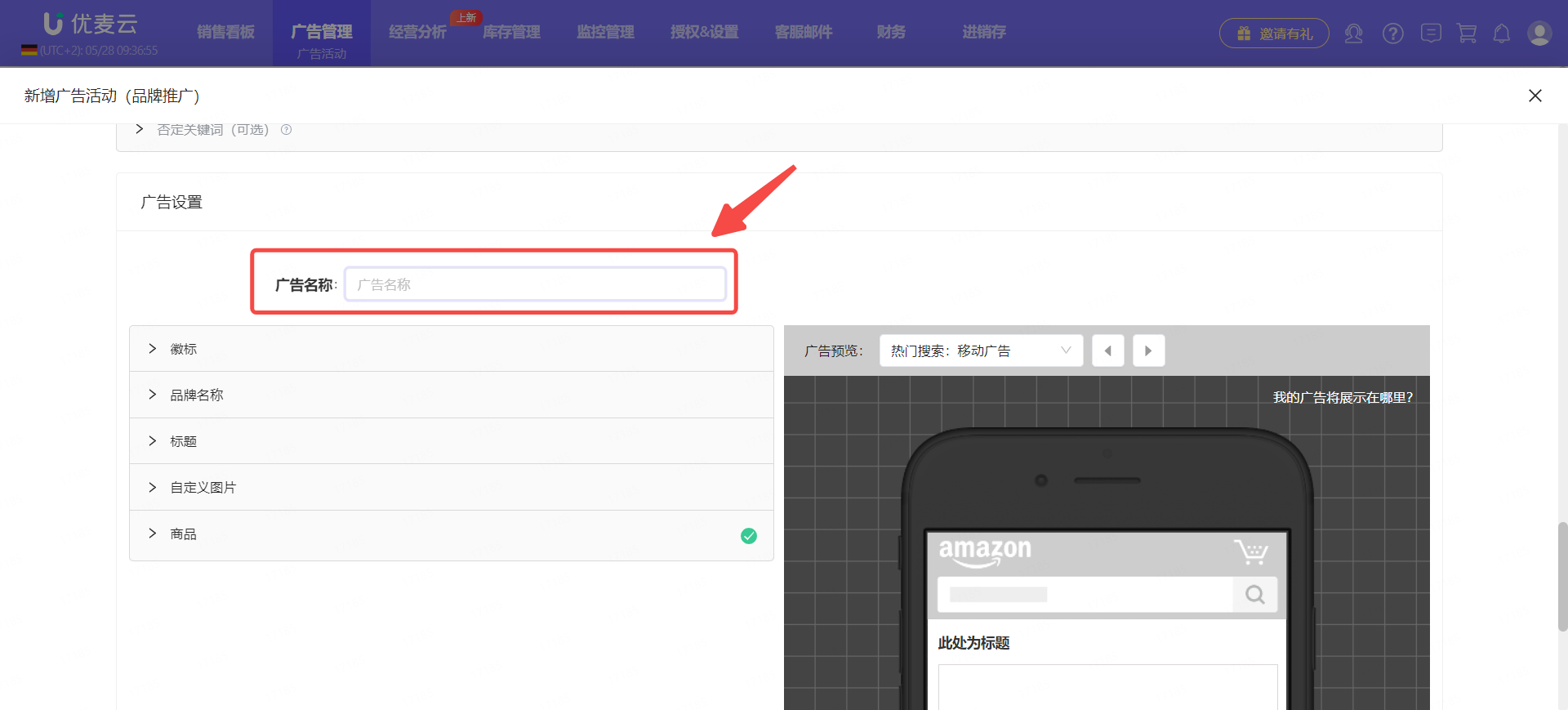 +
+
Logo: This is actually our brand logo. The logo upload requirements are the same as in Seller Central.
Logo upload requirements:
- Image size 400x400 pixels or larger
- File size 1MB or smaller
- File format PNG or JPG
- Content Logo must fill the image or be placed on a white or transparent background
Click the 【Click to Upload】 button to directly upload our brand logo.
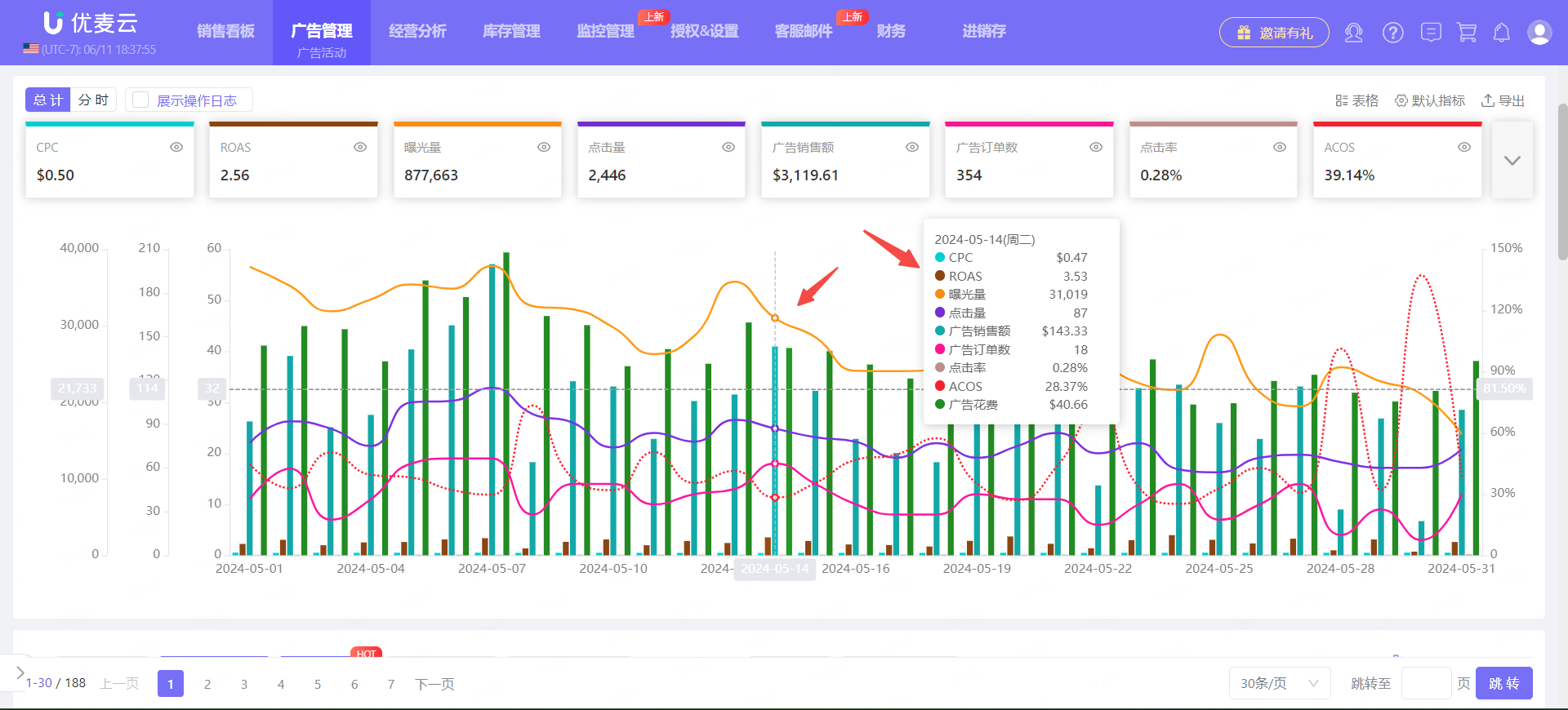 +
+
When viewing the trend chart, you can also click the small eye icon in front of the indicator name to hide the trend line of a certain indicator and only view the trend chart of that indicator.
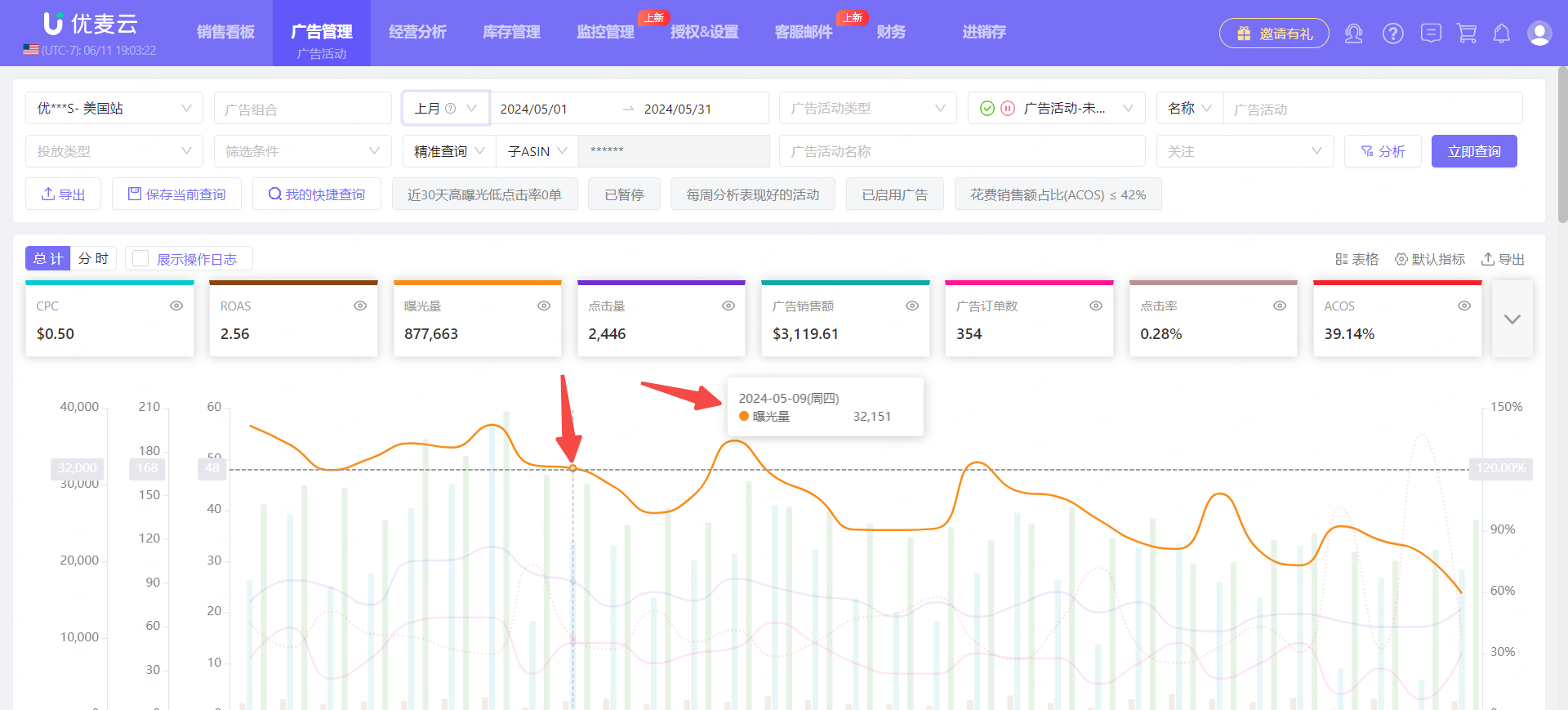 +
+
The system defaults to displaying 【Total】 data, and we can also view 【Hourly】 data. "Hourly" here refers to displaying the corresponding indicator data by single day.
Click the 【Hourly】 button in the upper left corner to switch with one click.
 +
+
When we view the core data performance trends, we can also combine 【Operation Logs】 to facilitate us to check which adjustment operations have been made when we see data anomalies, and analyze whether our operations have caused them.
Check 【Show Operation Logs】 to view the latest 100 operation logs in SellerSpace.
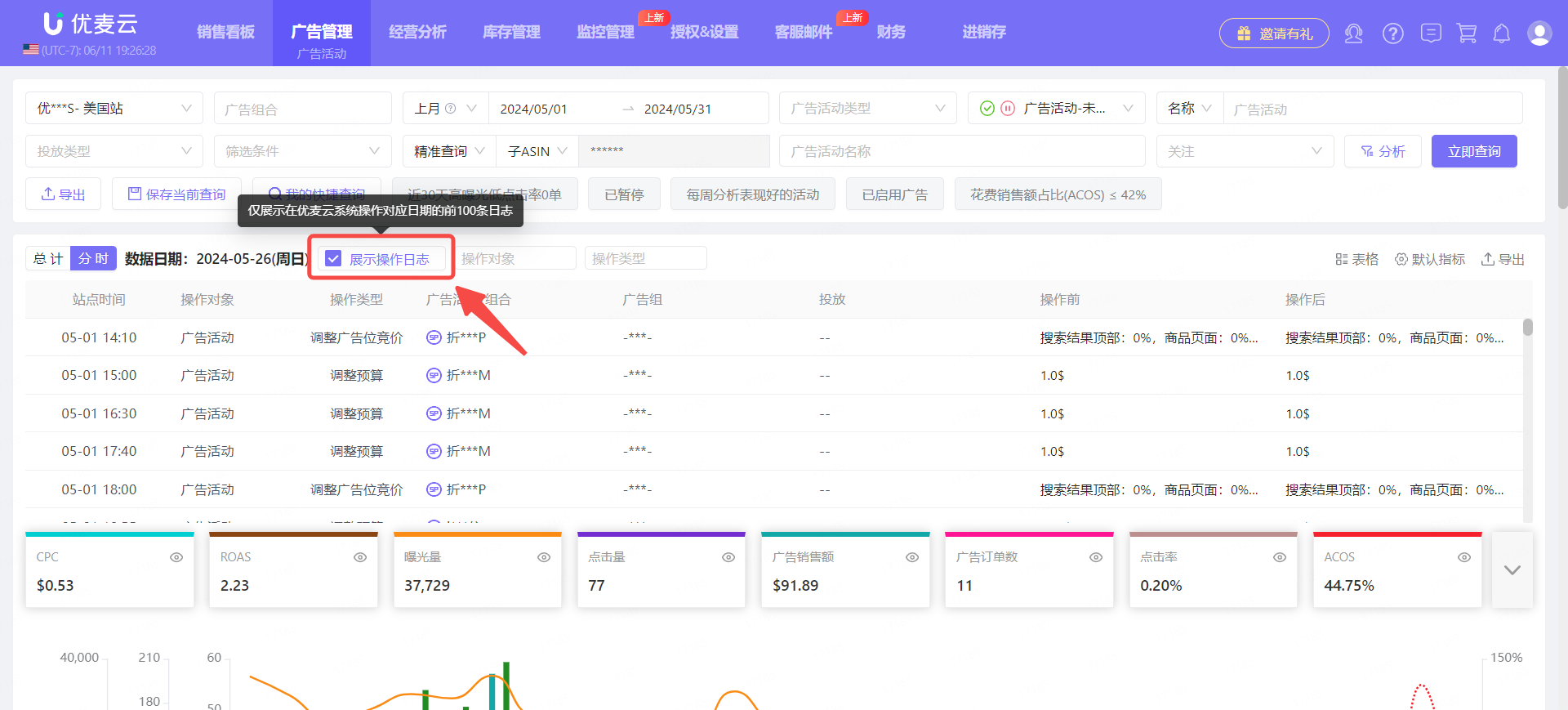 +
+
When viewing operation logs, simple filtering is also supported.
You can directly select the corresponding "Operation Object" and "Operation Type".
 +
+
In addition to the "Chart" mode, the viewing of total charts also supports viewing in the form of a "Table".
Click 【Table】 in the upper right corner to switch with one click.
 +
+
Table mode:
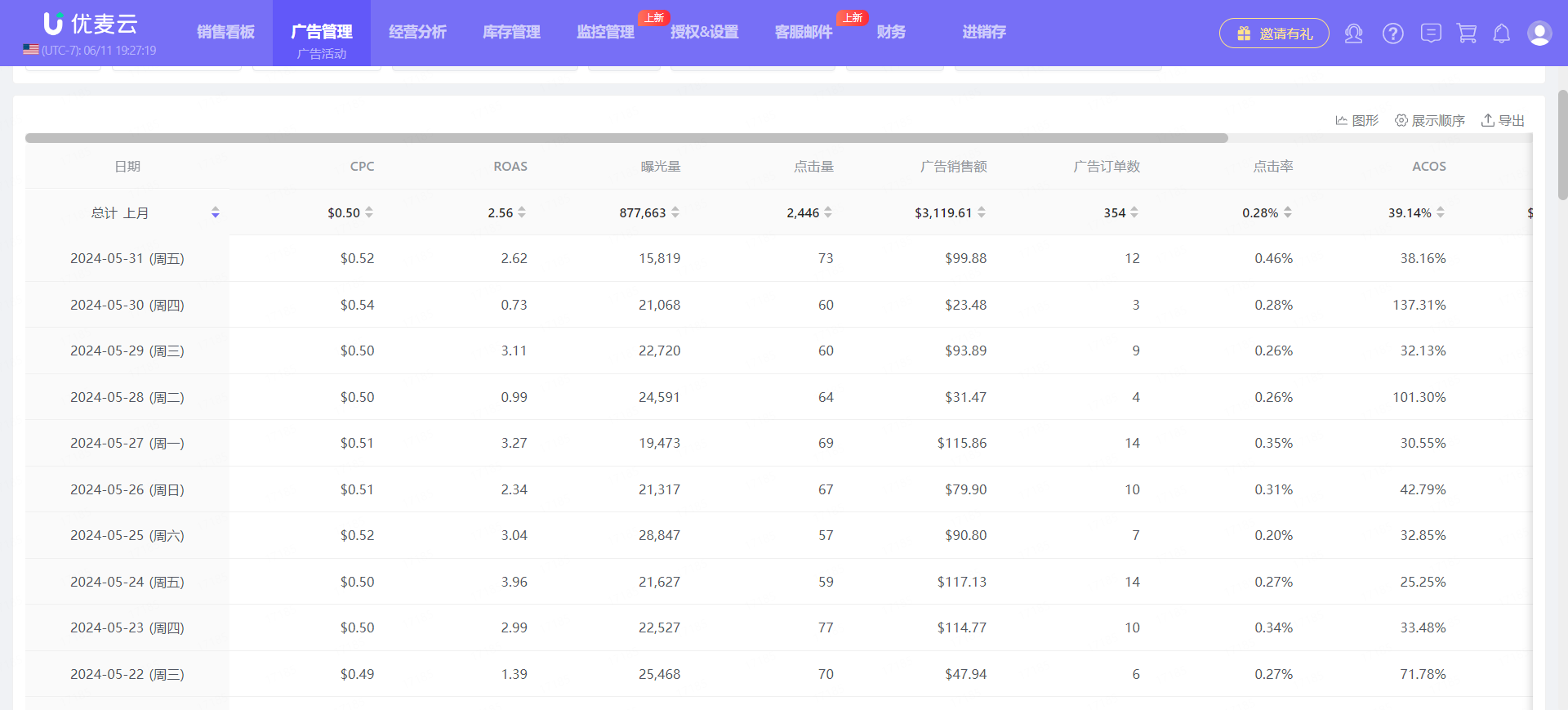 +
+
In the table format display, indicators also support custom sorting.
Click 【Display Order】 in the upper right corner to enter the settings page and drag the indicators to sort according to your habits.
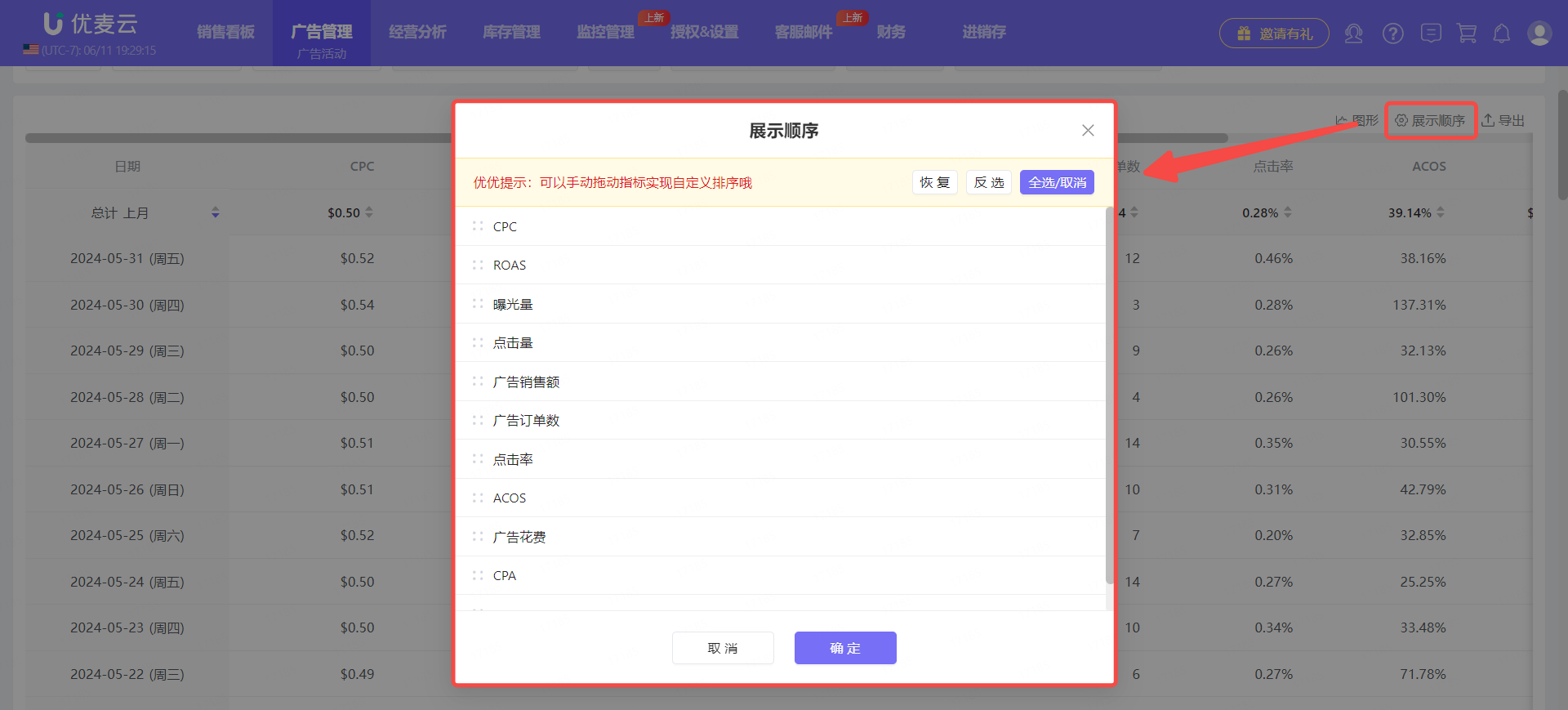 +
+
Finally, the data of the total chart supports exporting, and the export format is Excel spreadsheet, which is convenient for our offline analysis.
Click the 【Export】 button in the upper right corner to export with one click.
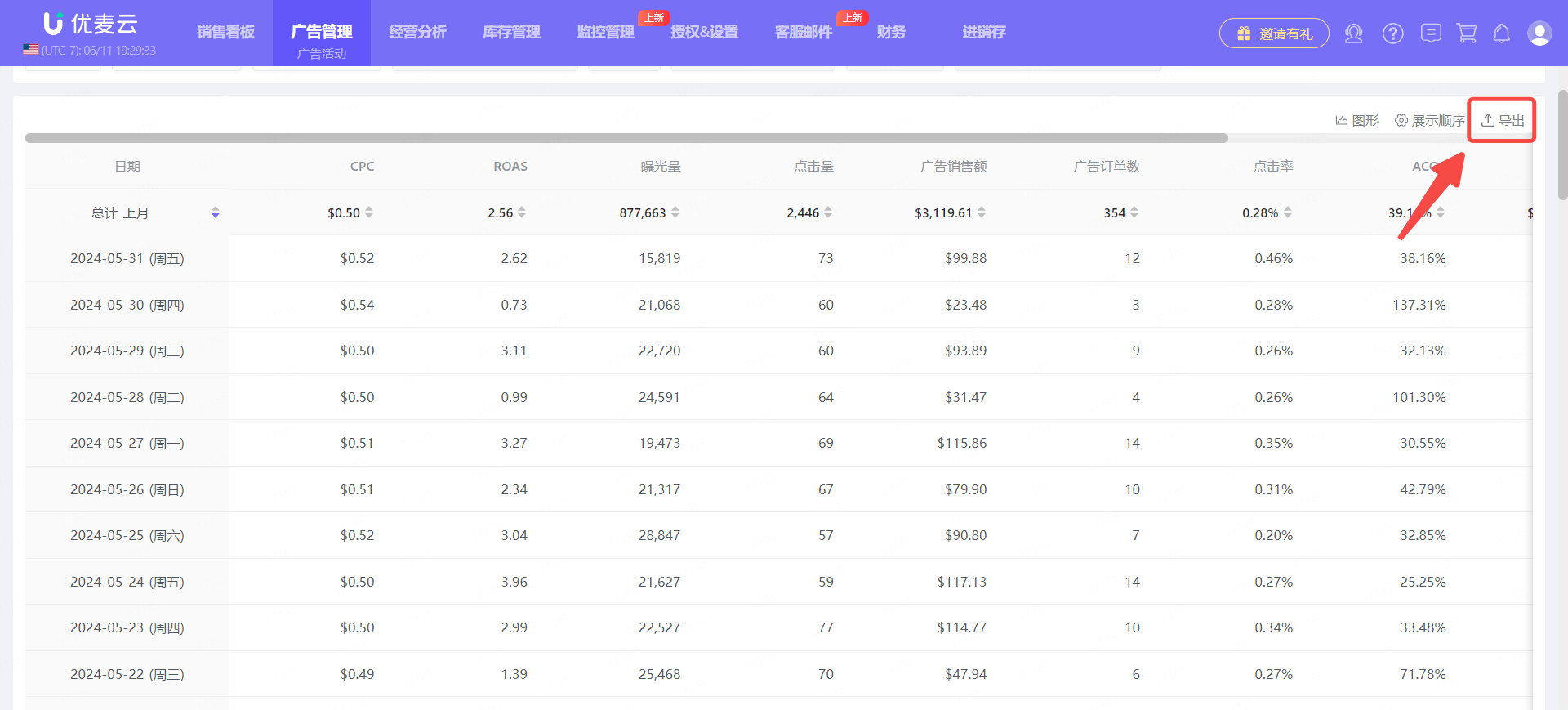 +
+
2.9 Historical Performance
Different from Amazon Advertising, which only retains advertising data for the last 60 days for seller analysis, SellerSpace will retain all advertising data synchronized since the seller authorized the store to help sellers more comprehensively grasp their advertising history and analyze whether their targeting strategies are correct, whether they need to be adjusted, how to optimize, etc.
The viewing and analysis of sellers' historical advertising data can be achieved through the 【Historical Performance】 function, which can not only view the historical performance of a single campaign, but also support viewing and analyzing comparative data for the same period and hourly trend data, etc.
How to view and analyze campaign performance?
Find the campaign we want to view and click the 【Historical Performance】 button to enter the data analysis page.
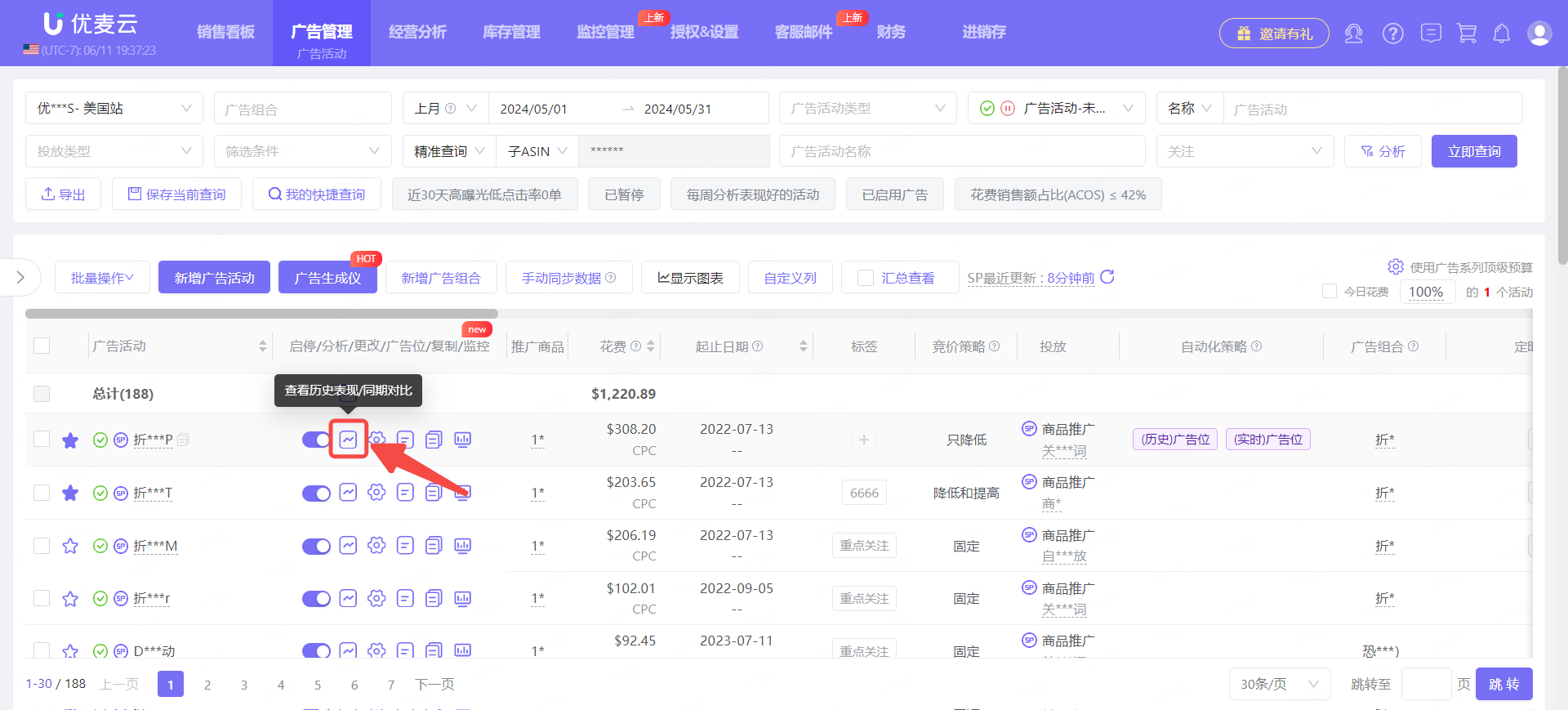 +
+
Enter the "Campaign Performance" pop-up page.
Campaign performance can be analyzed from 4 dimensions: Historical Performance, Period Comparison, Hourly Trend, and 24-Hour Trend.
Historical Performance
Historical performance shows all historical data of the synchronized campaign.
Its viewing and usage method is basically similar to 【Total Chart】, such as: setting default display indicators, setting single indicators, hovering over the chart to view separately, graphic/table display forms, total and hourly display, showing operation logs, exporting, etc.
Total Chart - Tutorial with Images and Text: Click to view
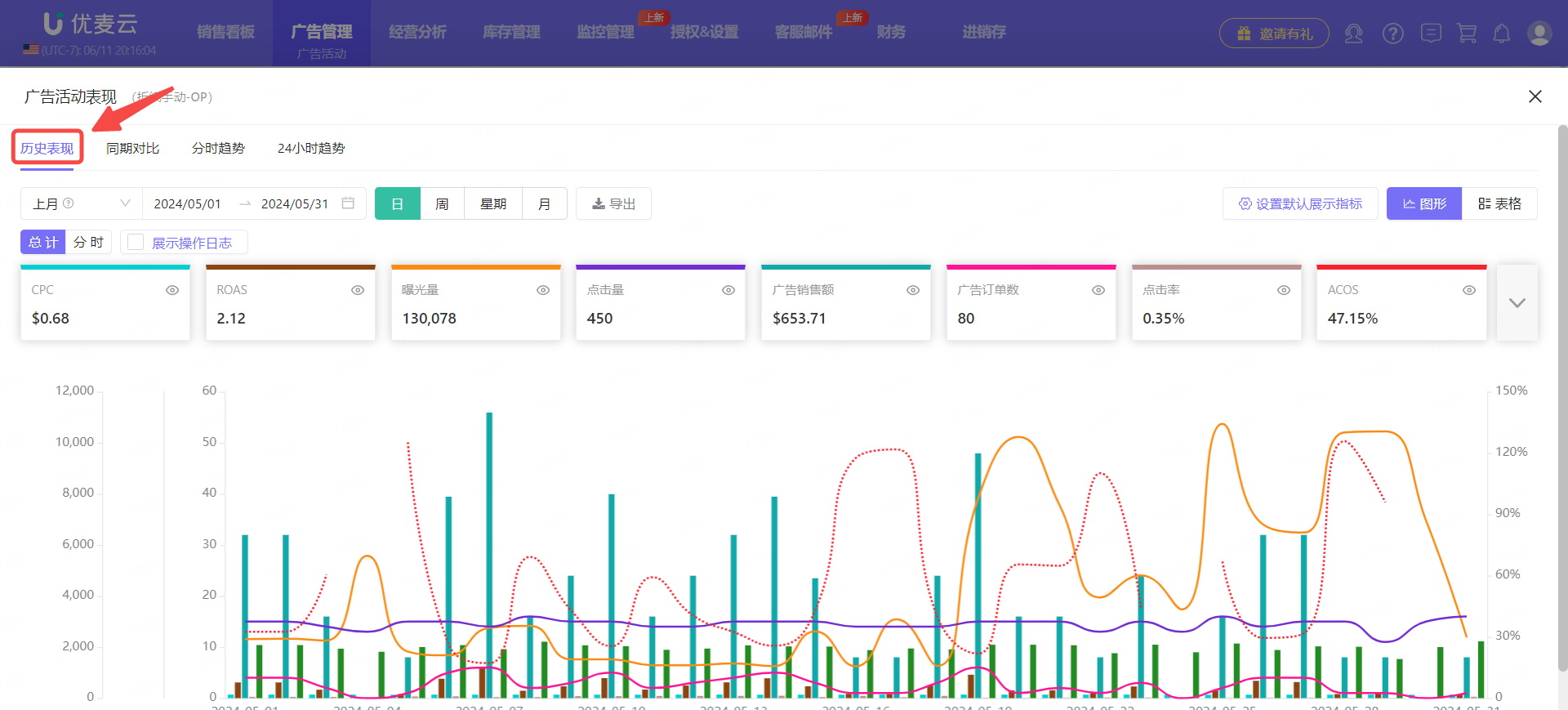 +
+
There are 2 differences from 【Total Chart】: supporting custom time ranges and displaying data by different time dimensions.
① Support custom time ranges
The data time range of the historical performance of the campaign defaults to be consistent with the settings in the query bar. However, we can also set other time ranges we want to view separately without setting them in the query bar before entering to view.
Click the time setting bar in the upper left corner to set it directly. The setting method is consistent with the query bar.
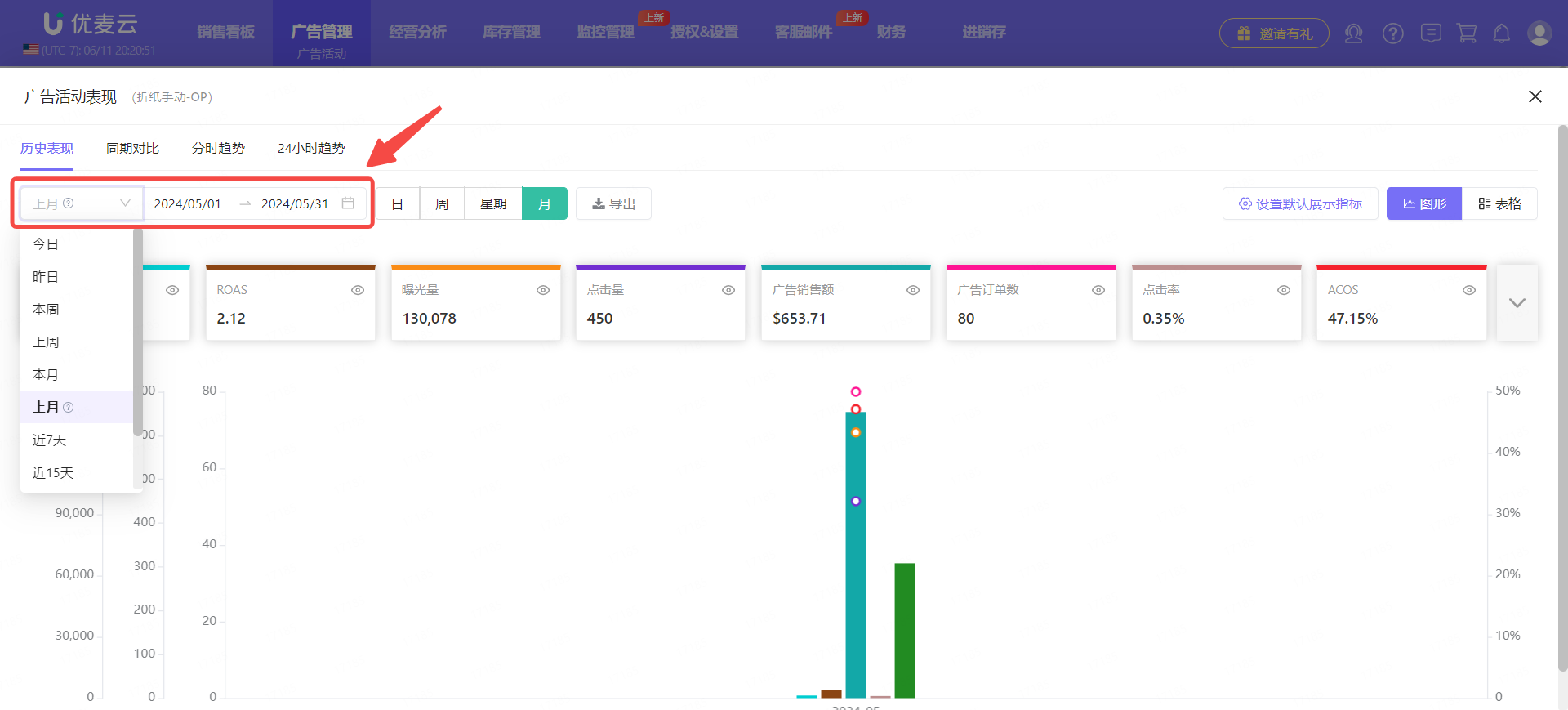 +
+
② Display data in different time dimensions
After setting the time range, you can choose to view and analyze by four dimensions: "Day, Week, Weekday, Month" according to the time range.
Click the button on the right side of the time range to switch with one click.
 +
+
Period Comparison
Period comparison data refers to the same indicator performance in the previous same period of the current query time, such as: data comparison between the 7th of this month and the 7th of last month, data comparison between Monday this week and Monday last week, etc.
 +
+
There are 11 indicators for period comparison, which are core advertising indicators, namely: Impressions, Clicks, CTR, Ad Spend, CPC, Ad Orders, CVR, CPA, Advertising Sales, ACOS, and ROAS.
Click the indicator name on the right to switch to view the period comparison data of different indicators.
 +
+
The time range for period comparison is set to be consistent with the query bar.
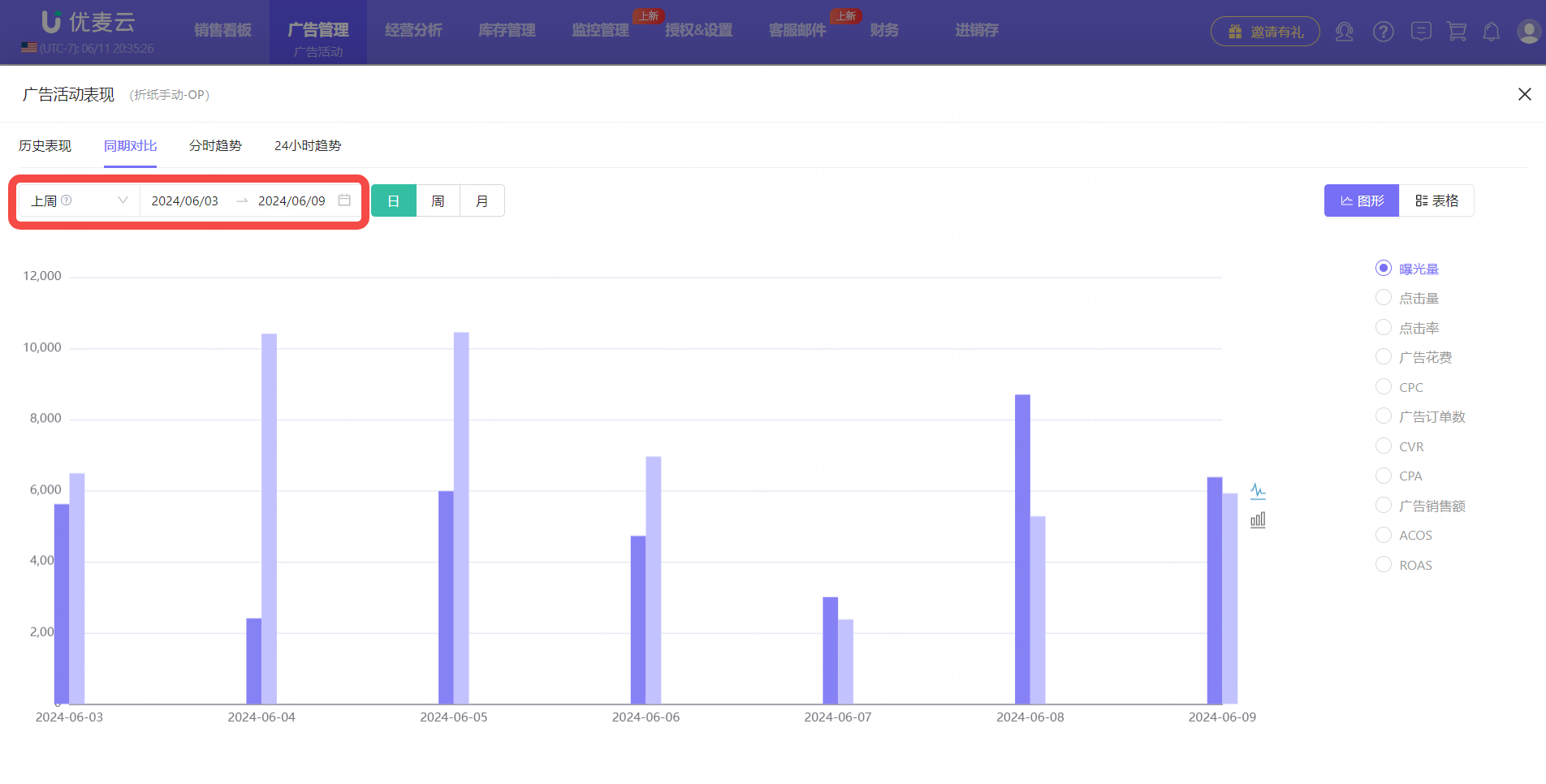 +
+
At the same time, it also supports displaying comparison data by "Day, Week, Month".
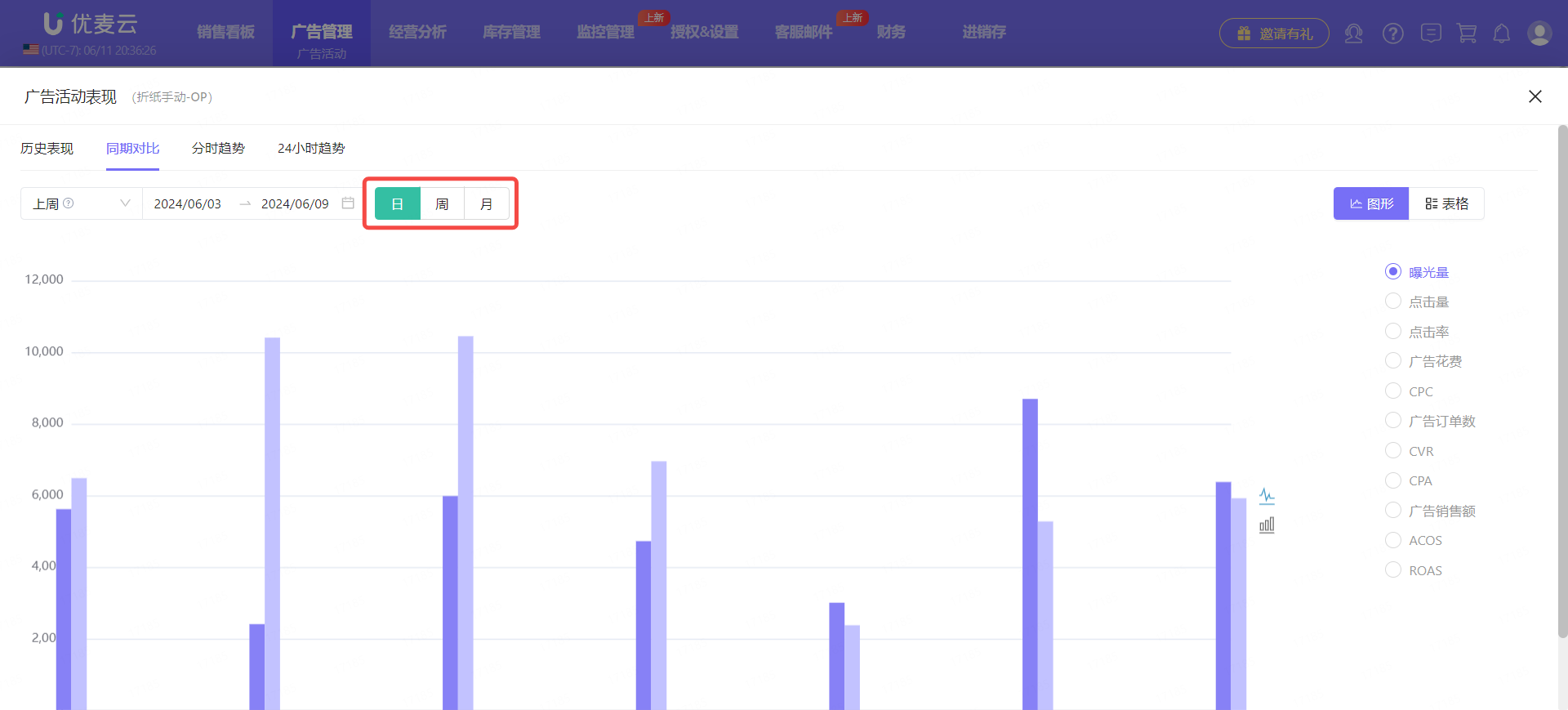 +
+
In addition to bar charts, we can also switch to line charts to view, whichever you prefer.
Click the icon button on the right to switch with one click.
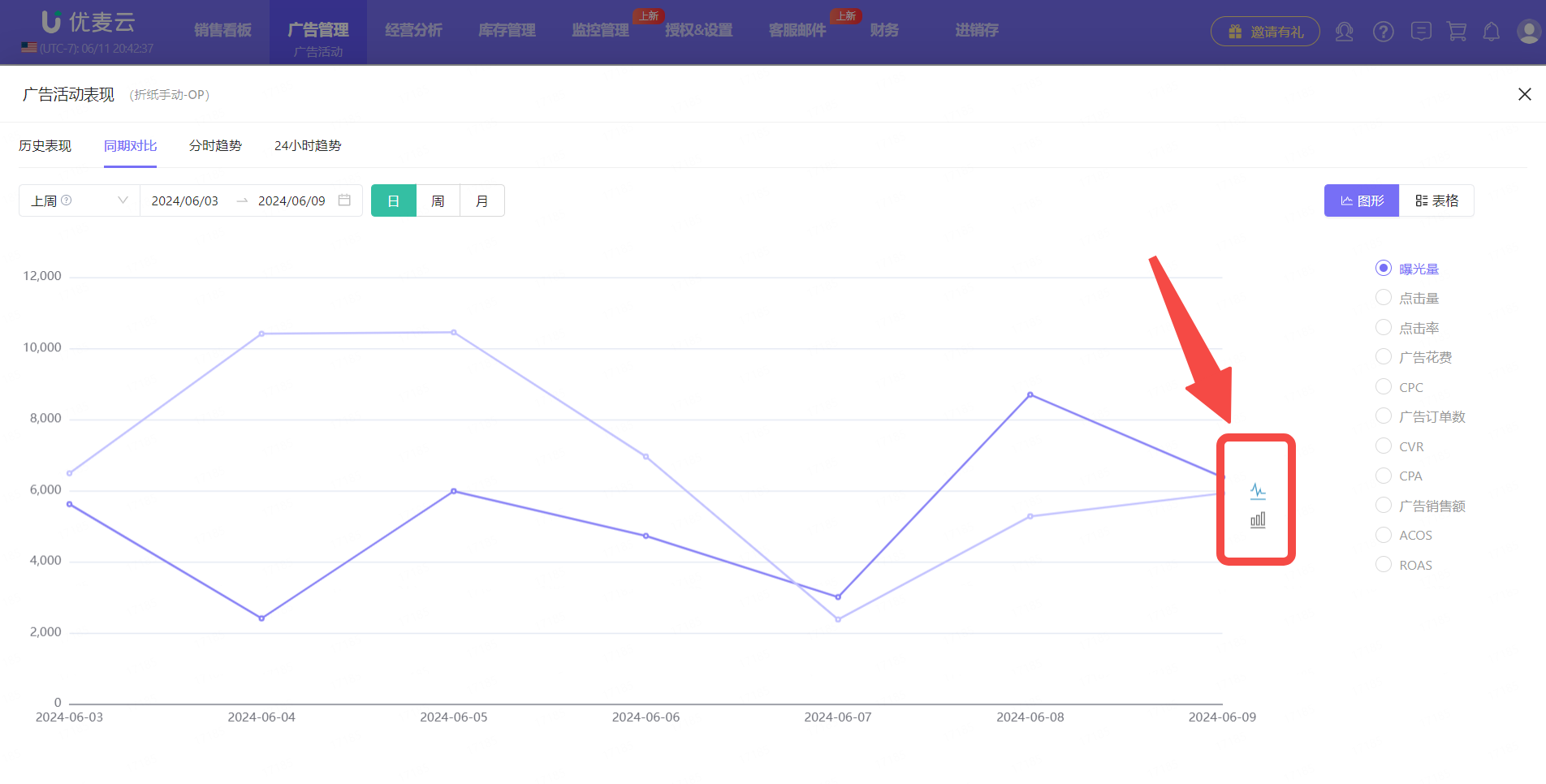 +
+
Finally, in addition to the "Chart" mode, period comparison data can also be viewed in "Table" format.
Click 【Table】 in the upper right corner to switch with one click.
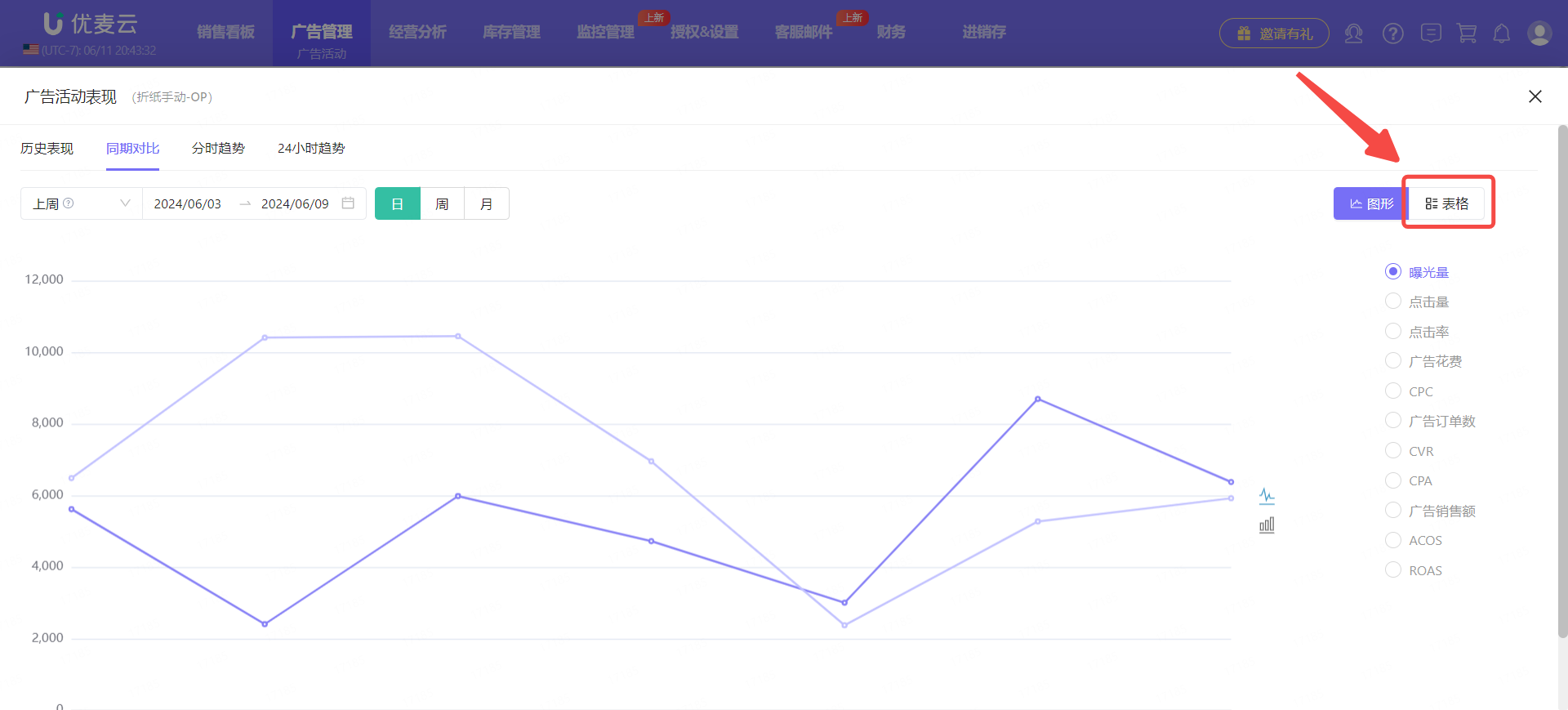 +
+
Hourly Trend
Each type of campaign supports viewing its hourly targeting data for the last 15 days to help us understand the hourly trends of advertising sales, ad orders, ad spend, ACOS, budget, impressions, clicks, CPC, and CVR, as well as their increment and per-minute increment data. By analyzing their trends, it helps us better optimize ad targeting.
Hourly trend data comes from Amazon API data and is not statistically based on hourly time, but based on the time point obtained.
Its usage method is basically the same as 【Total Chart】.
 +
+
Take "viewing the hourly trend of yesterday's ad impressions and clicks and their increments in the form of a solid line chart" as an example.
Click 【Set Default Display Indicators】 in the upper right corner to enter and select to only display: Impressions, Clicks, Ad Impression Increment, Click Increment, and set it as a solid line chart.
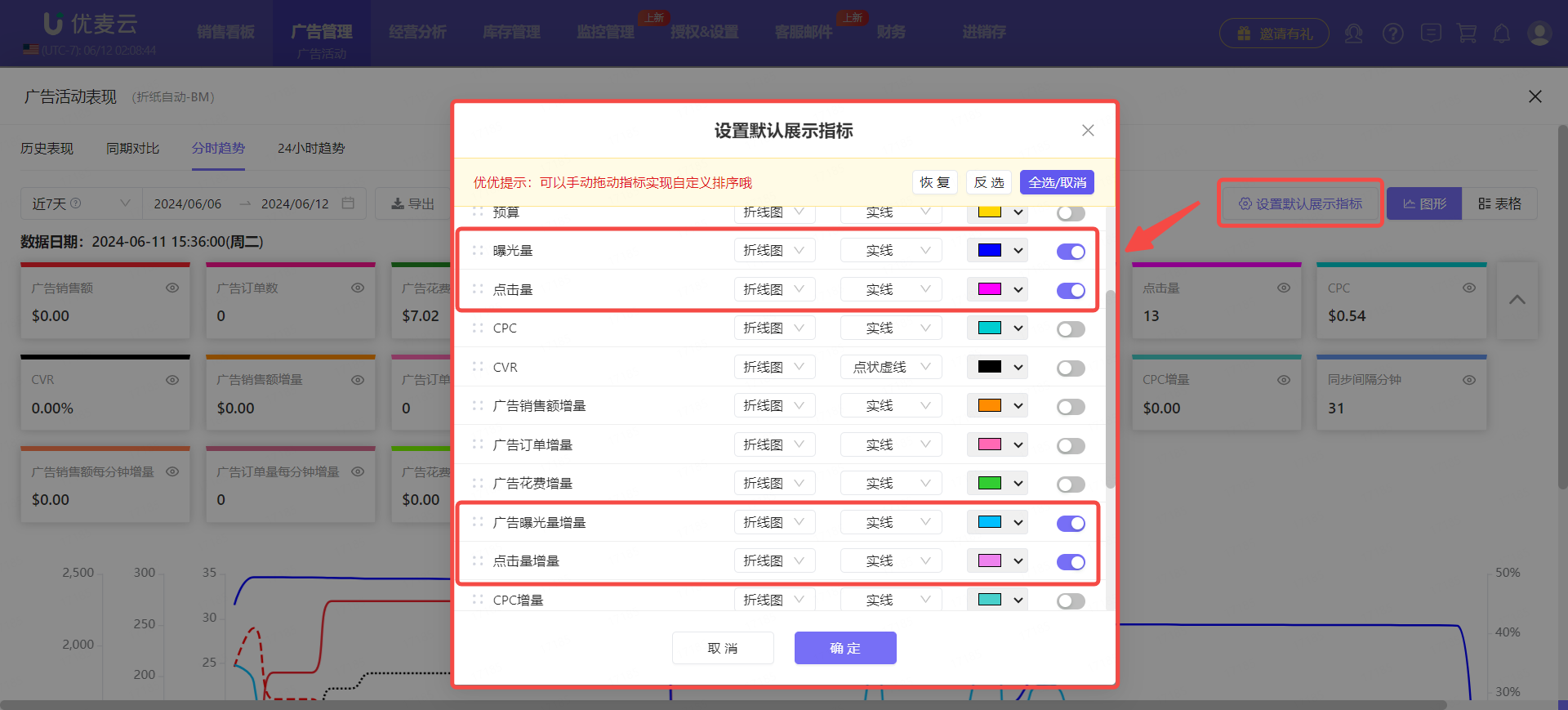 +
+
After setting, select the data time range.
The system defaults to displaying hourly trend data for the last 7 days. Click the time setting box in the upper left corner and select 【Yesterday】.
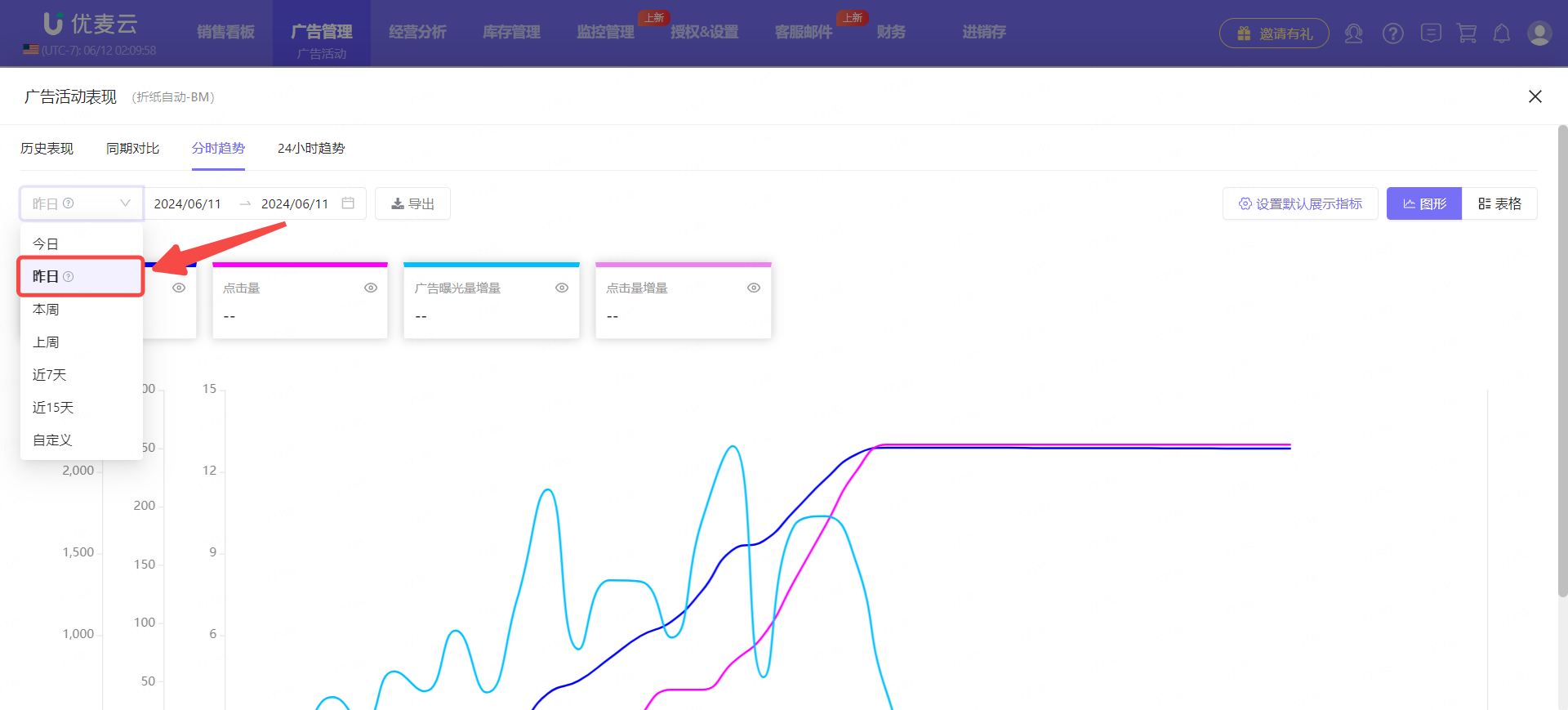 +
+
After selecting, you can view yesterday's ad impression click and increment trend data.
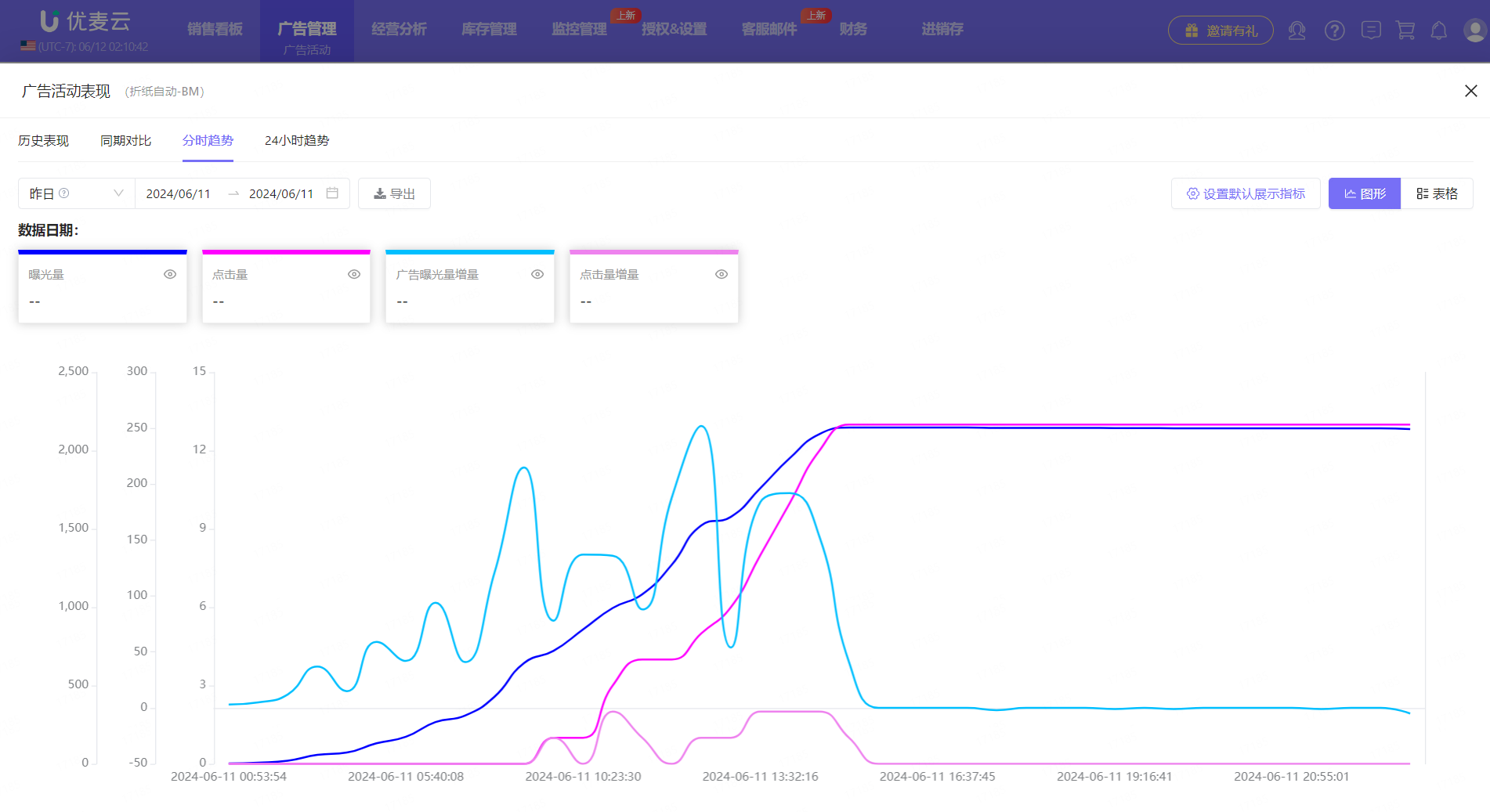 +
+
In addition to the above settings, we can also set the displayed indicators separately.
- Click the small eye icon to view the indicator separately. Click again to restore to the original state.
- Click the 【Settings】 button to set the style of the indicator separately, including color and display method.
- Click the 【Delete】 button to cancel the default display of the indicator.
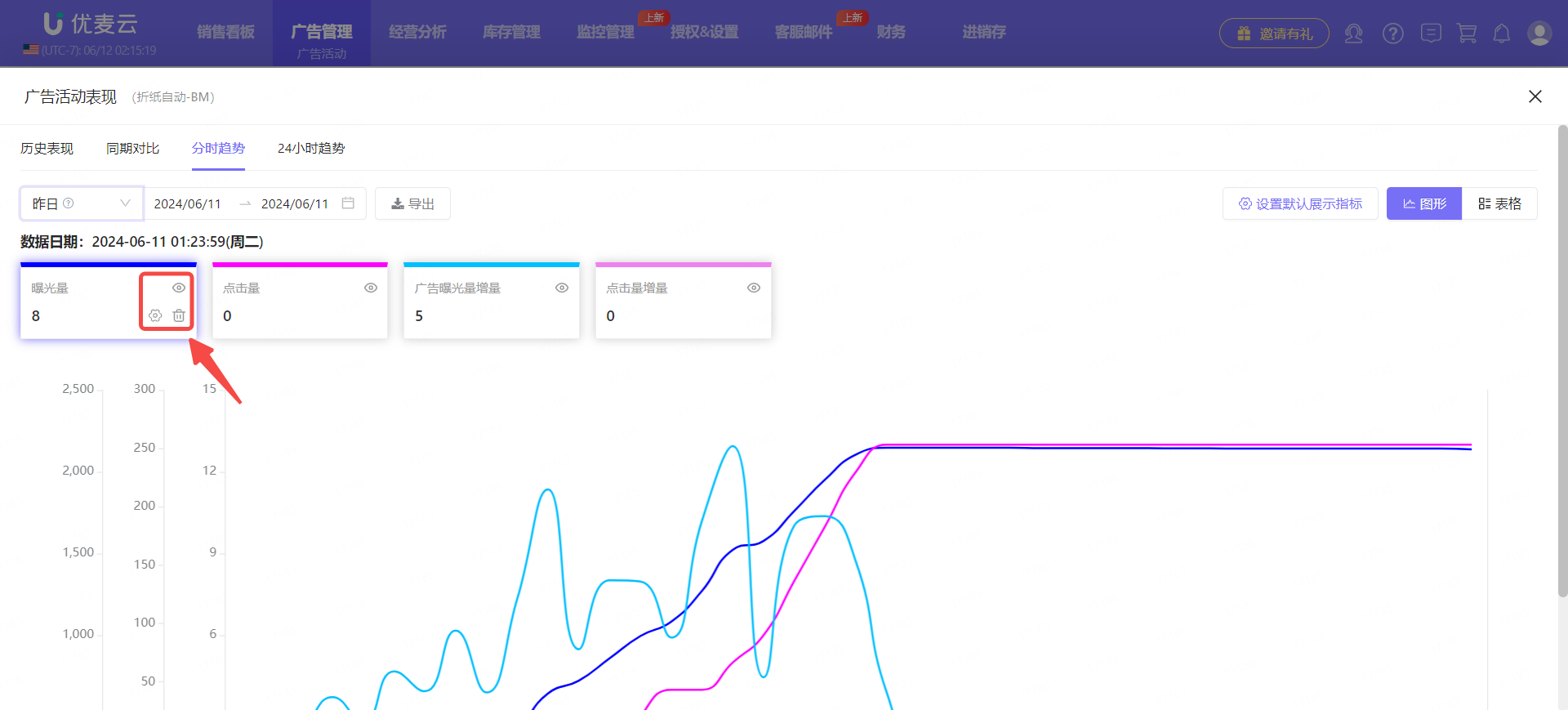 +
+
Support viewing hourly trend data in 【Table】 format.
Click 【Table】 in the upper right corner to switch with one click. And support setting the indicator display order.
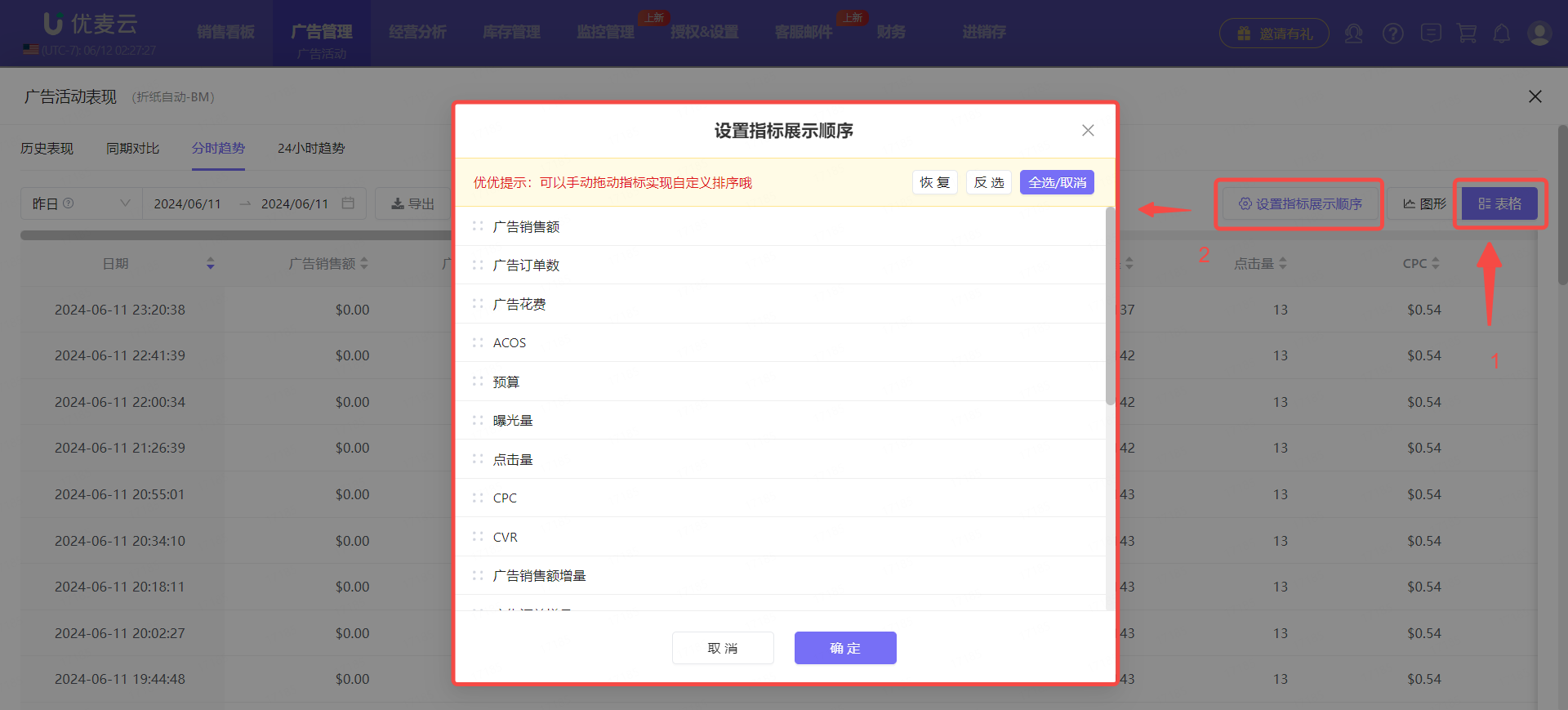 +
+
The current hourly trend data supports exporting, and the export format is Excel spreadsheet.
Click 【Export】 to export with one click.
 +
+
24-Hour Trend
24-hour trend data is similar to the usage of 【Hourly Trend】, with only 2 differences, as follows:
- Hourly Trend: Non-hourly time data; 24-Hour Trend: 24-hour hourly ad trend data for each hour.
- Hourly Trend: Only data for the last 15 days can be viewed; 24-Hour Trend: Data for all synchronized time periods can be viewed
Here, further note: 24-hour trend can only view 24-hour hourly data for paid time periods. SB/SD ads have data after March 7.
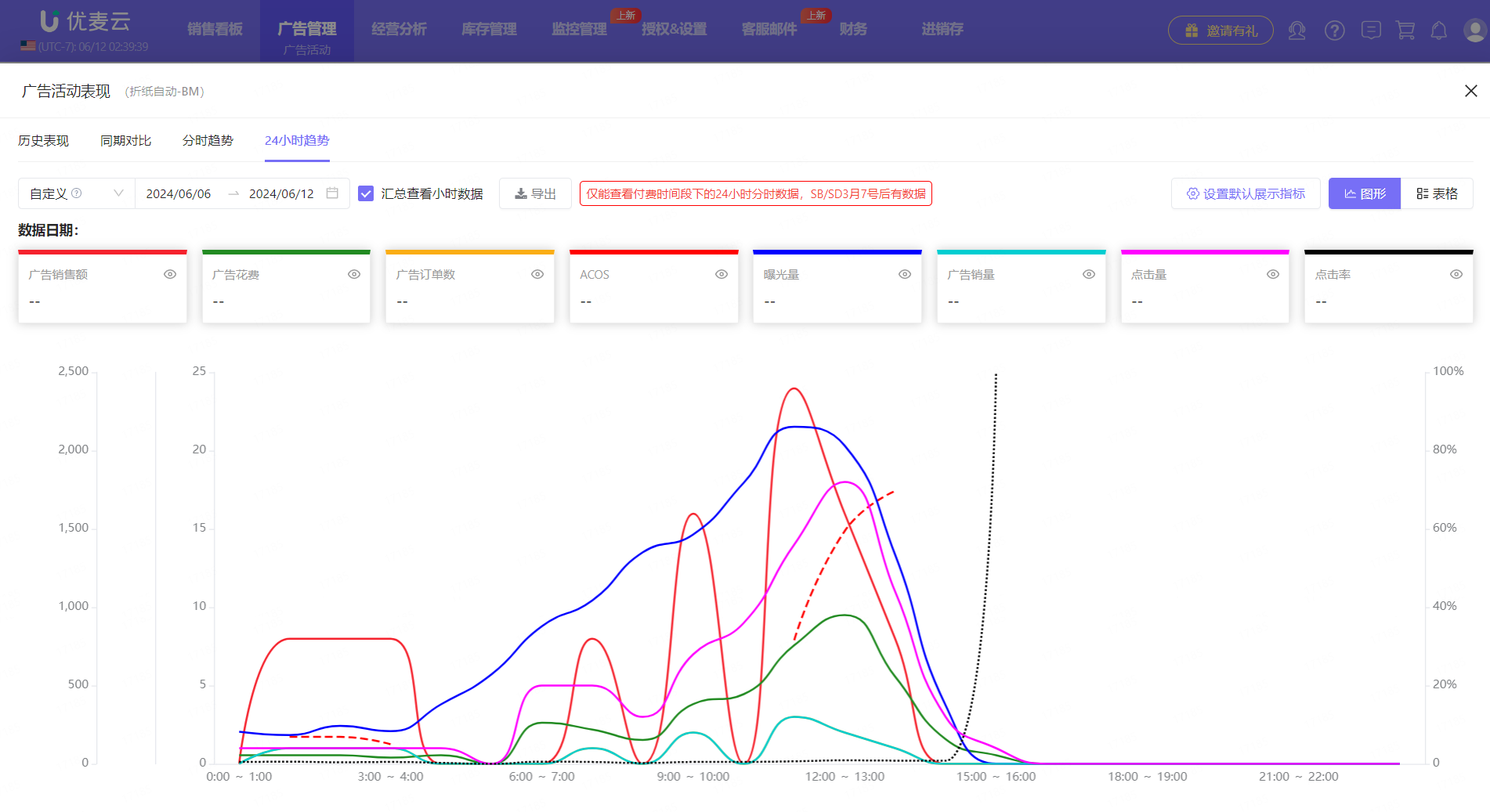 +
+
2.10 Placements
Sponsored Products (SP) and Sponsored Brands (SB) ads can view placement data. We can analyze the ad placements they are targeting. SP ads can also adjust bids based on placements to maintain favorable ad placements for targeting and get more clicks and orders.
Placements include: Top of search results (page), Product pages, Rest of search results, Amazon Offsite.
Select the SP or SB ad to view and click the placement button to enter to analyze and adjust placement bids.
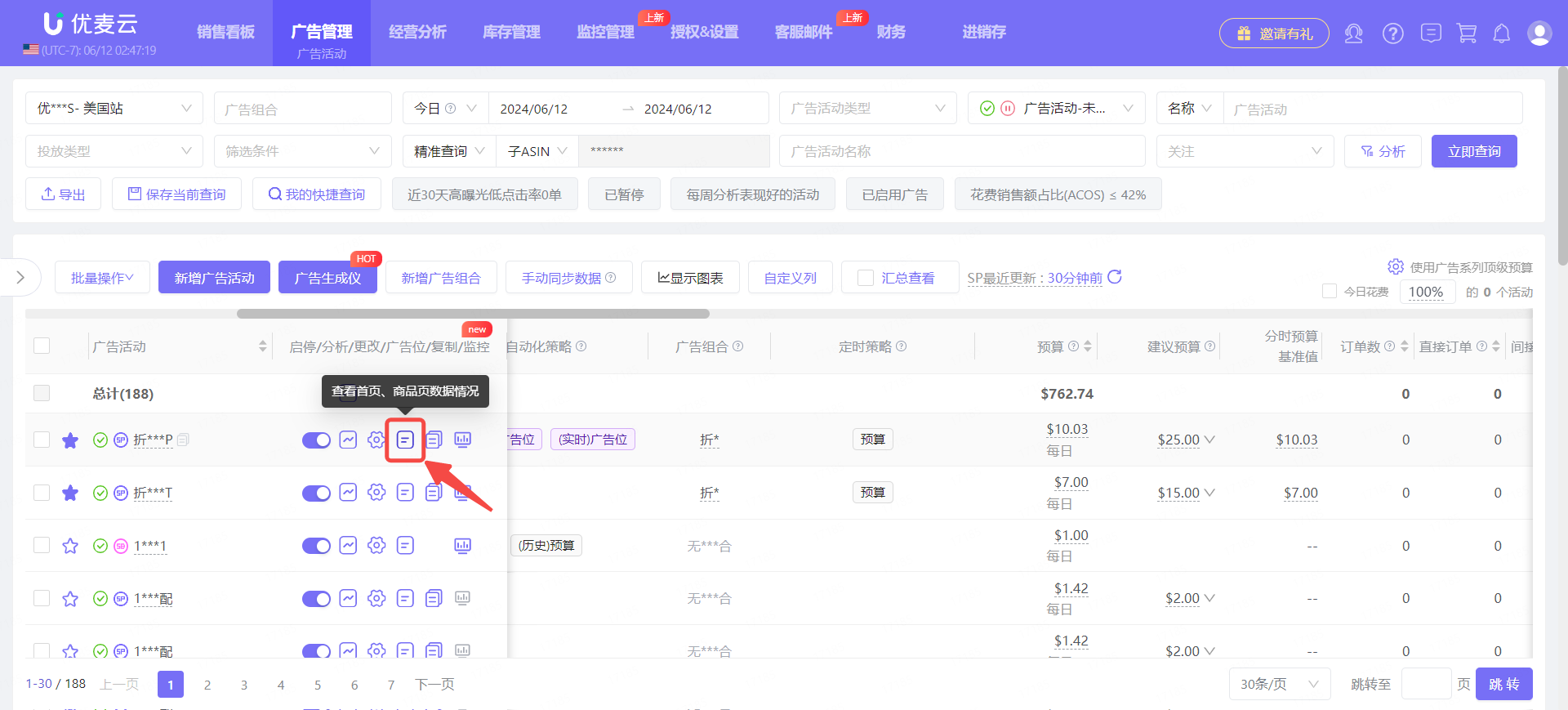 +
+
Placement data defaults to displaying data for the current day.
You can also select other times to view the corresponding placement situation.
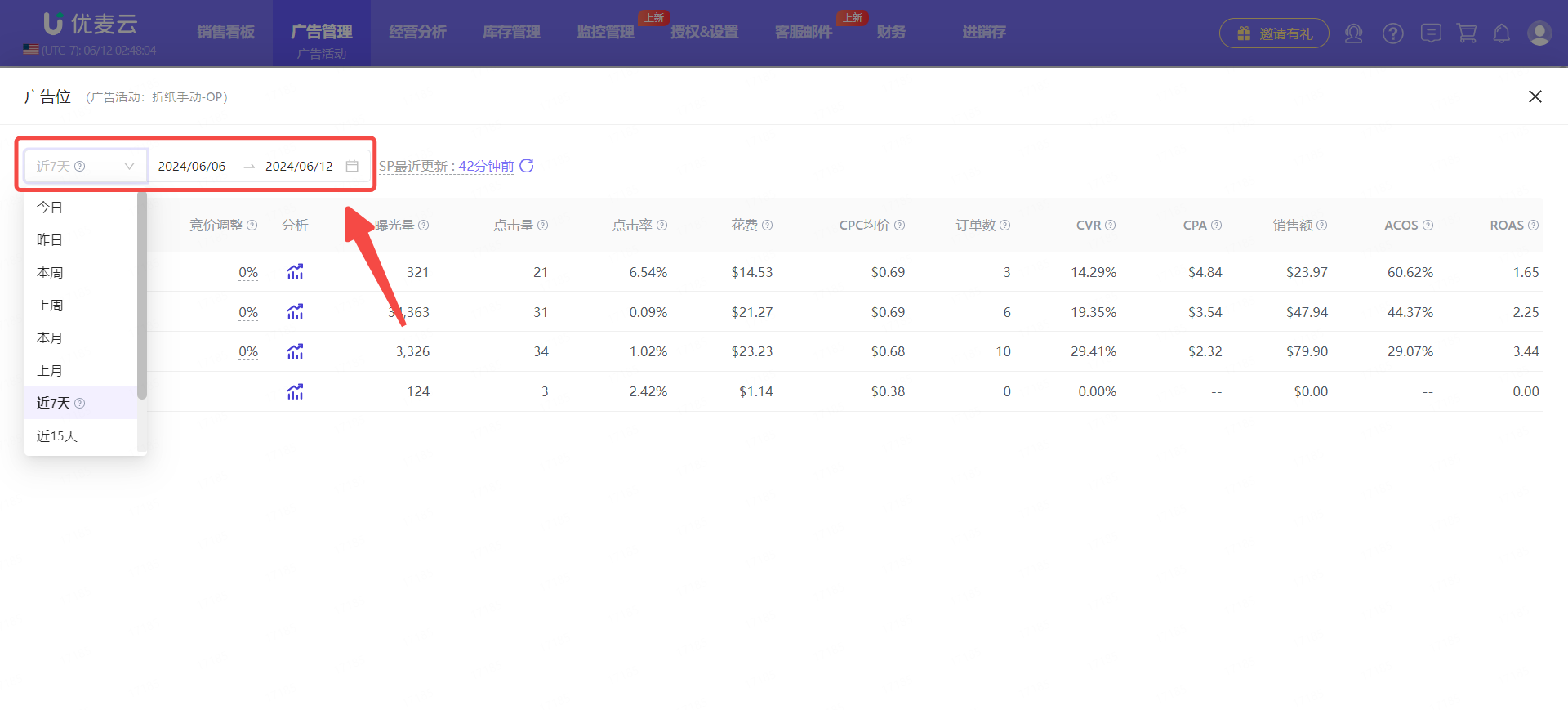 +
+
In addition to viewing the targeting details for the selected time period, we can also analyze the historical trend of placement targeting.
Click the analysis button on the right side of the corresponding placement to enter to analyze the historical trend. The analysis-related operations are consistent with the campaign 【Historical Performance】.
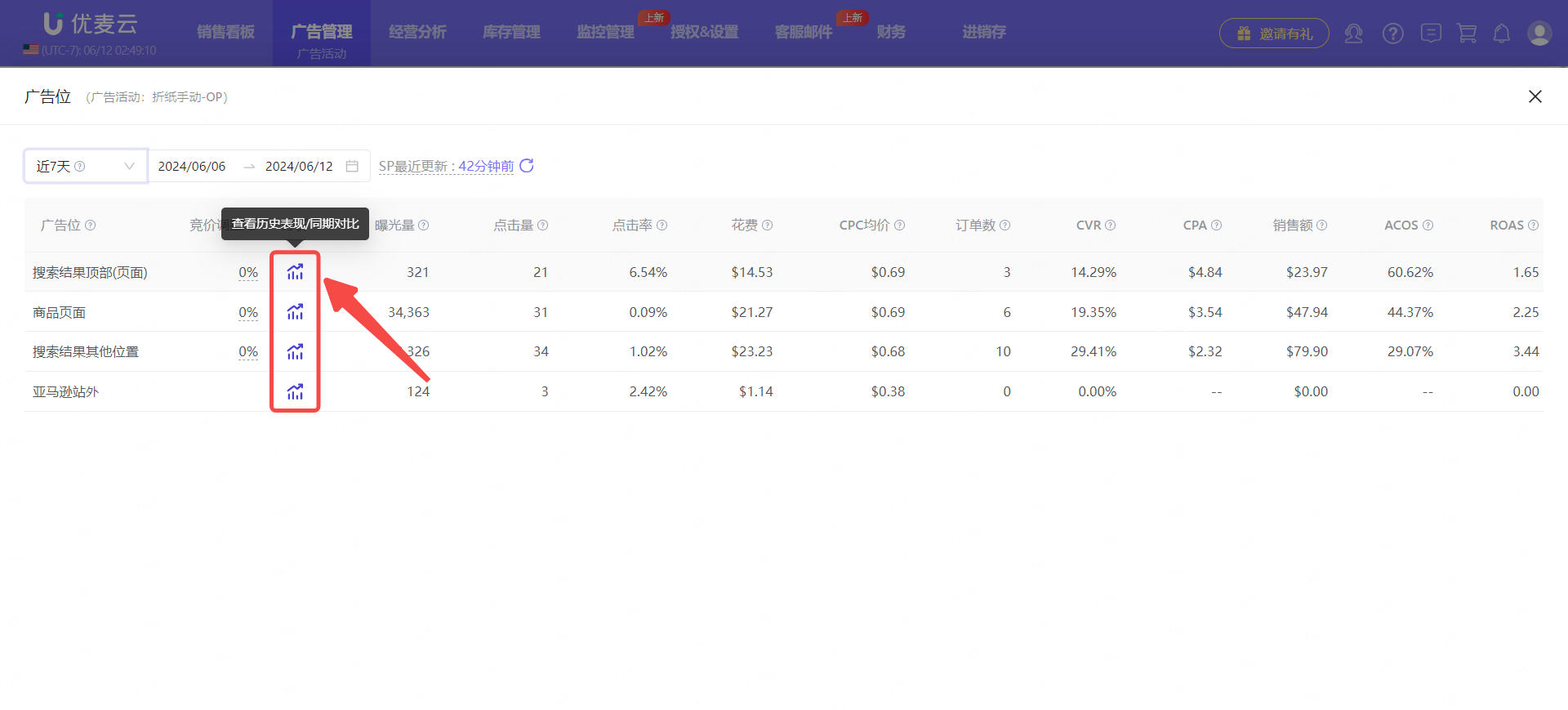 +
+
Placement historical trend data:
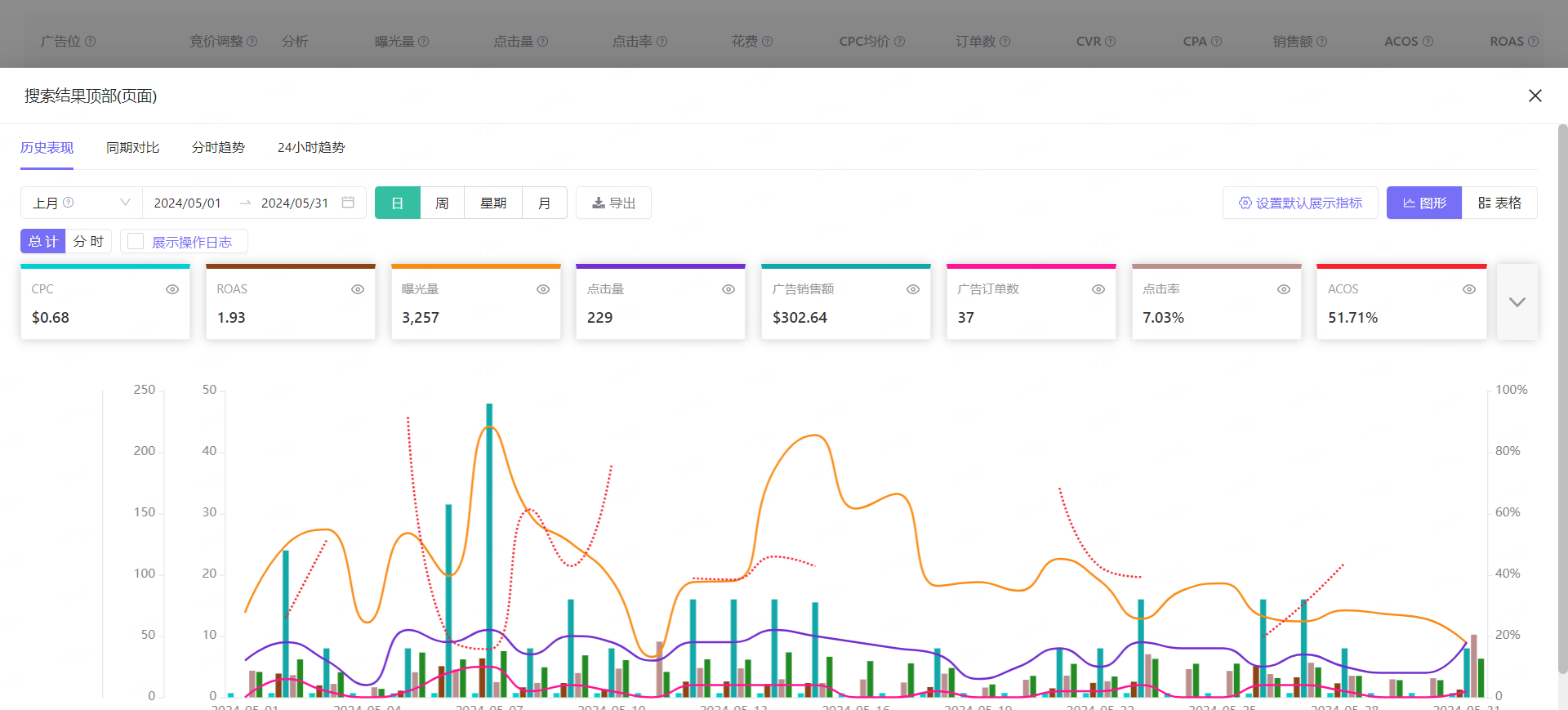 +
+
2.11 Data Comparison
When we usually target ads for a product, we may create multiple campaigns for the product, or even multiple campaigns of the same type. At this time, we need to "select the superior and eliminate the inferior" and analyze the data of the two to decide whether to keep or remove them.
At the same time, if you are a seller of similar products, you can also compare and analyze the advertising performance of similar products to help us identify problems and optimize ad targeting in a timely manner.
The 【Data Comparison】 function can help us compare the core performance data of different campaigns, find differences, and identify problems.
Data comparison supports comparing multiple campaigns.
Find the campaigns to be compared, check them, and click 【Data Comparison】 to enter the comparison data pop-up page.
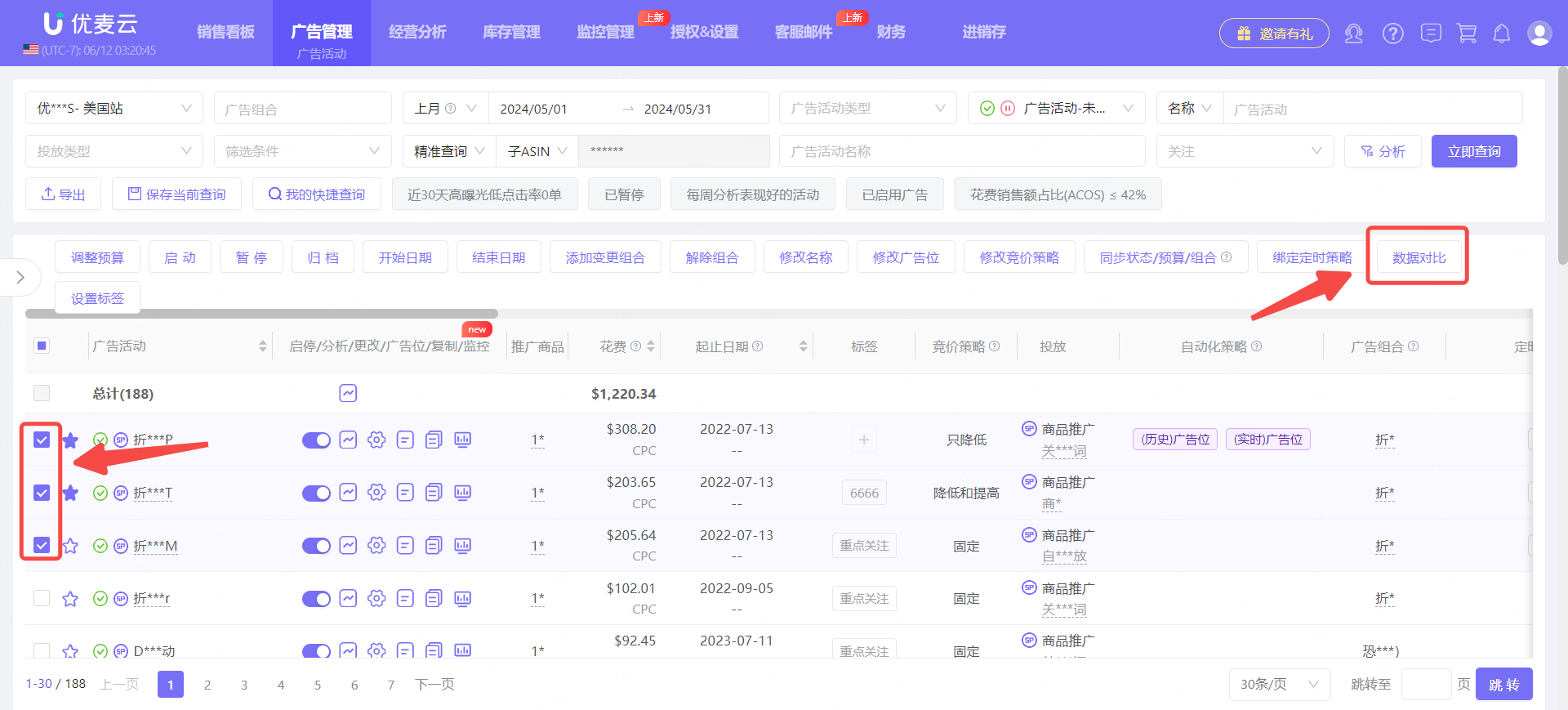 +
+
Enter the "Data Comparison" page.
Select the indicators to compare and view.
The indicators for data comparison are core advertising indicators: ACOS, Clicks, Ad Spend, CPA, CPC, Ad Orders, Advertising Sales, CTR, CVR, Impressions, and ROAS.
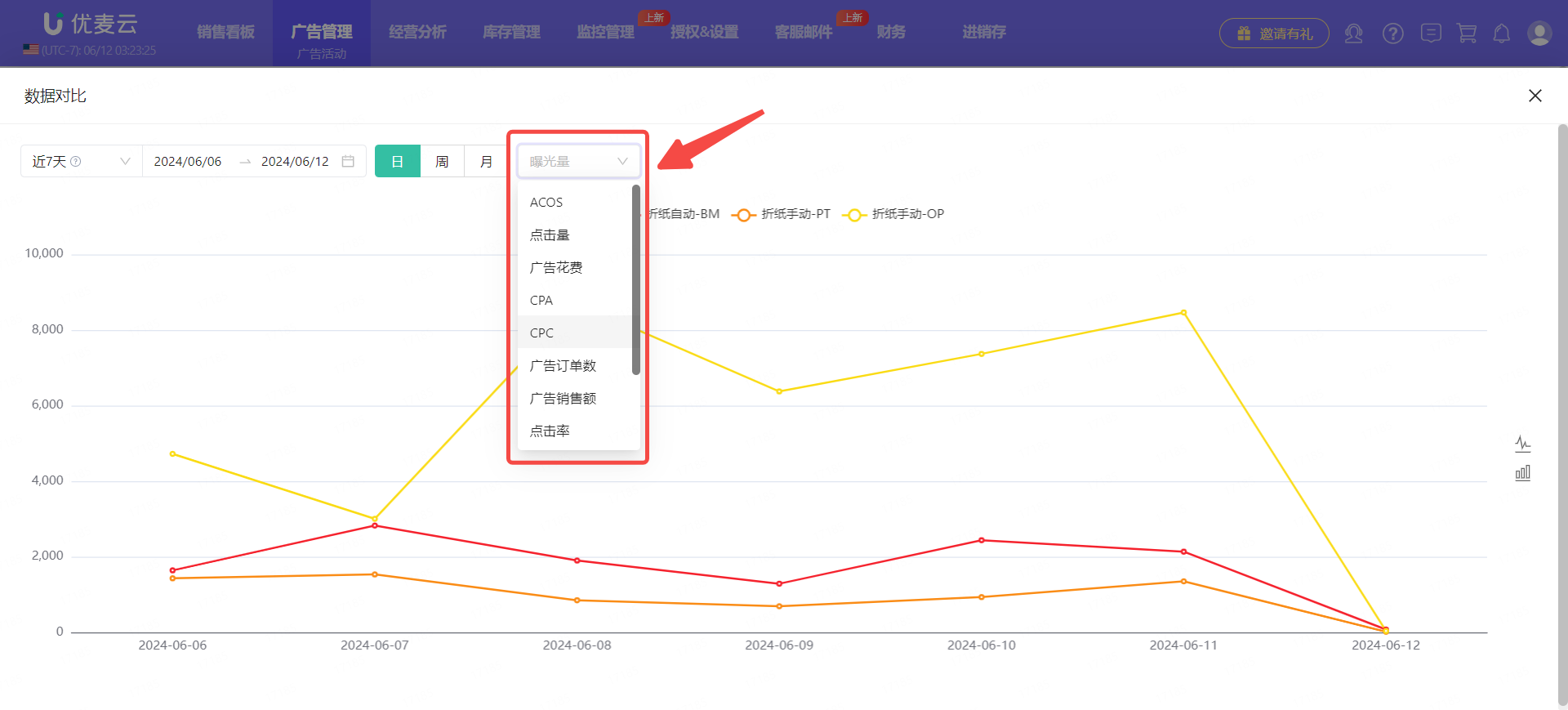 +
+
Then, select the data time.
We can compare and analyze the advertising data of all times synchronized after authorization.
Click the time bar to select the corresponding time range, supporting customization. At the same time, according to the length of the selected time range, you can further choose to display data by "Day, Week, Month".
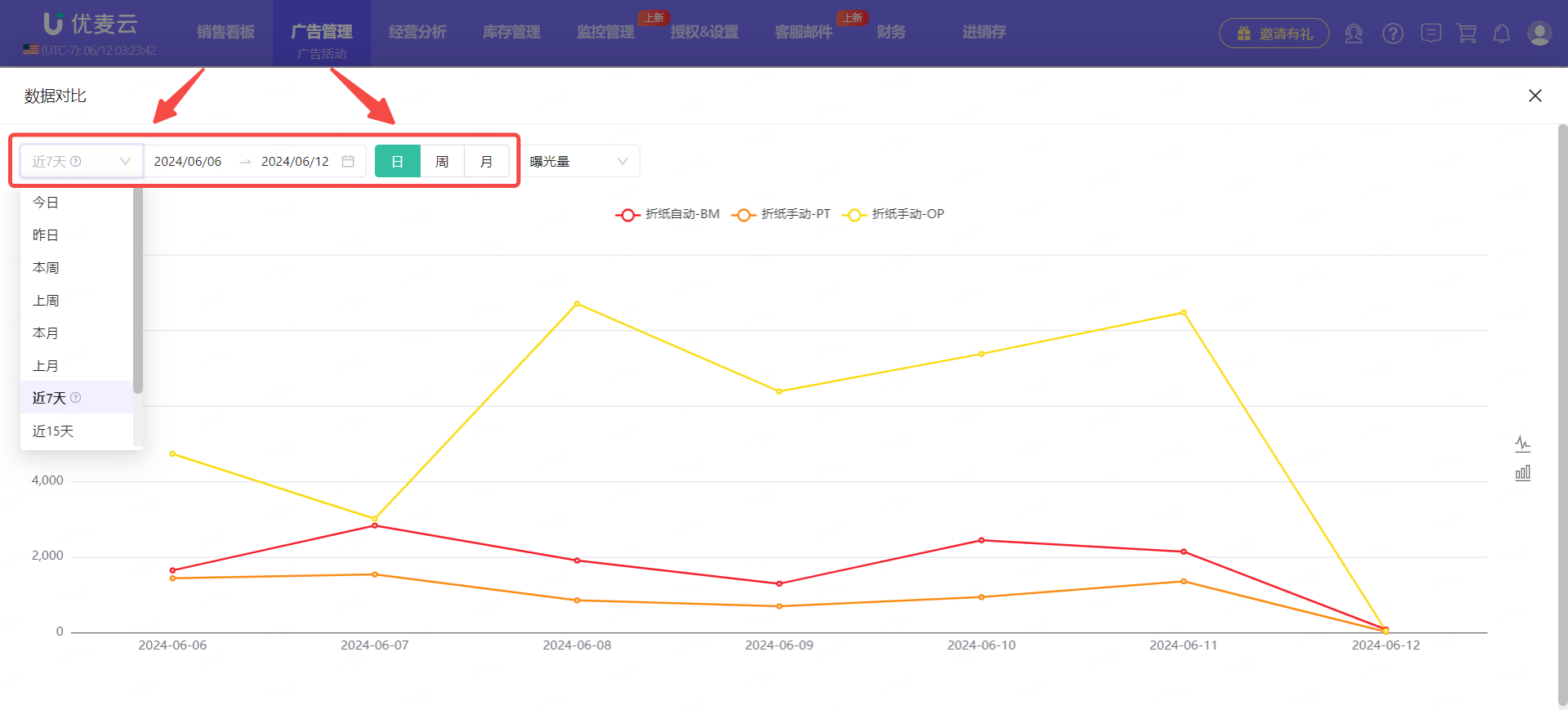 +
+
After selecting the data time range and indicators, you can directly view the corresponding data.
Hover the mouse over the curve chart to view the specific data of the nodes.
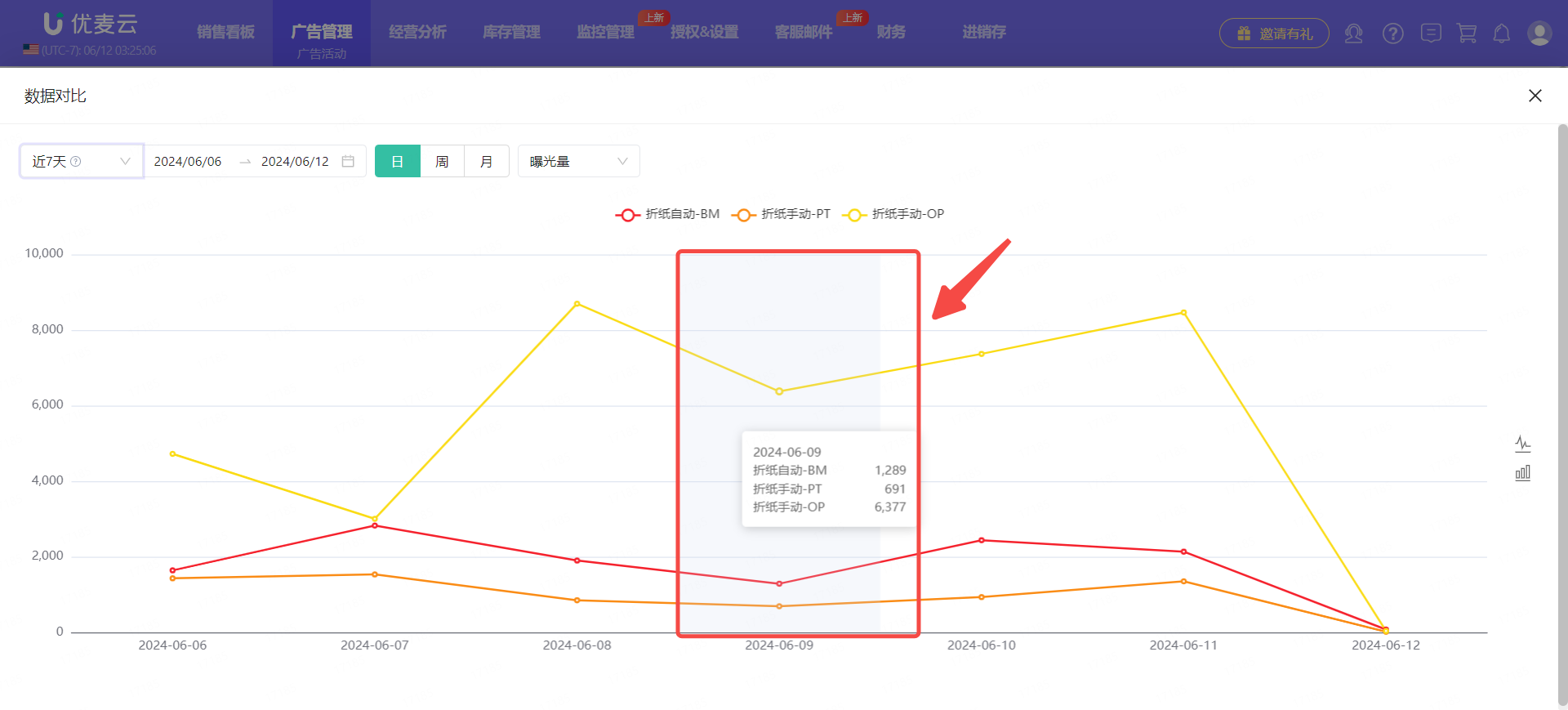 +
+
Hover the mouse over the campaign name above to view the indicator performance trend of the campaign separately.
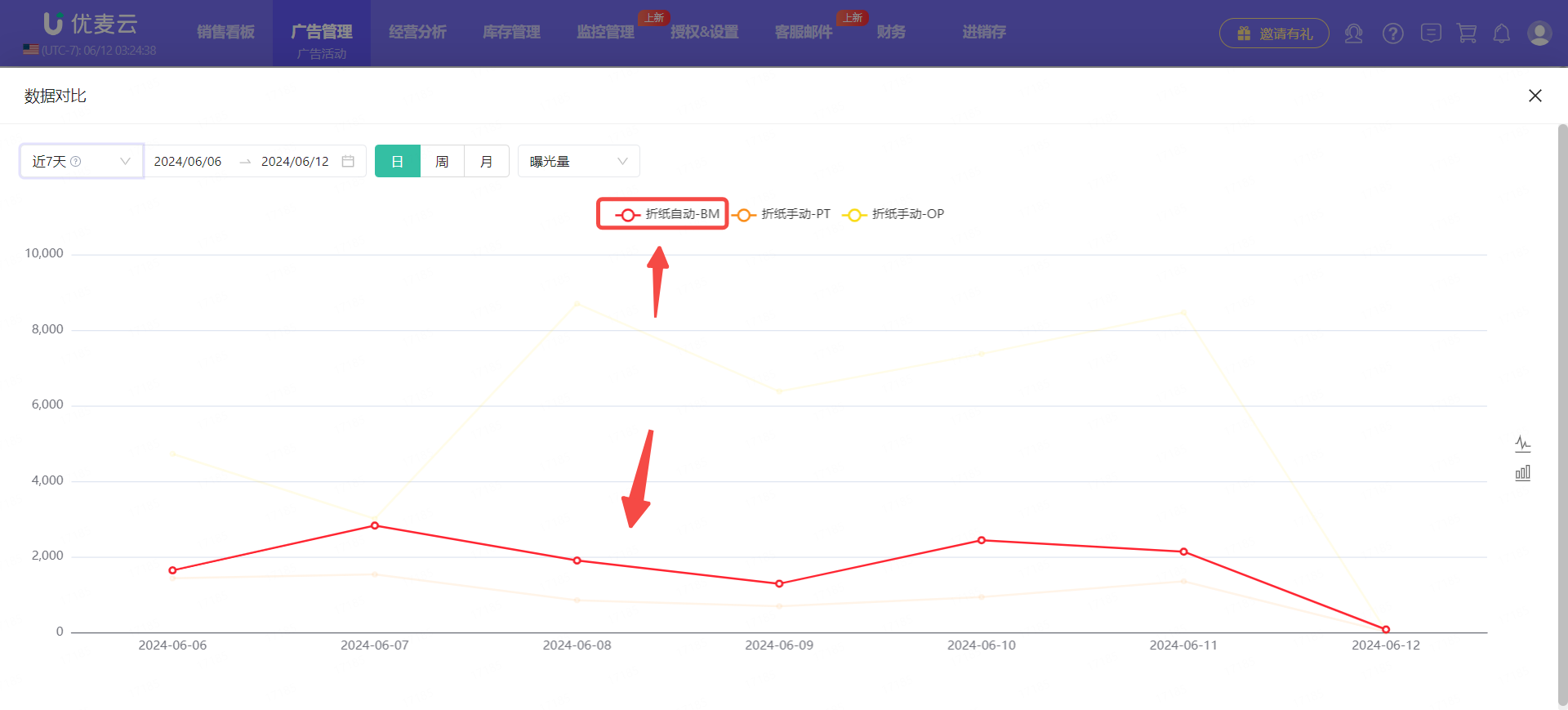 +
+
Click the campaign name to hide the data of the campaign, and click again to restore the display.
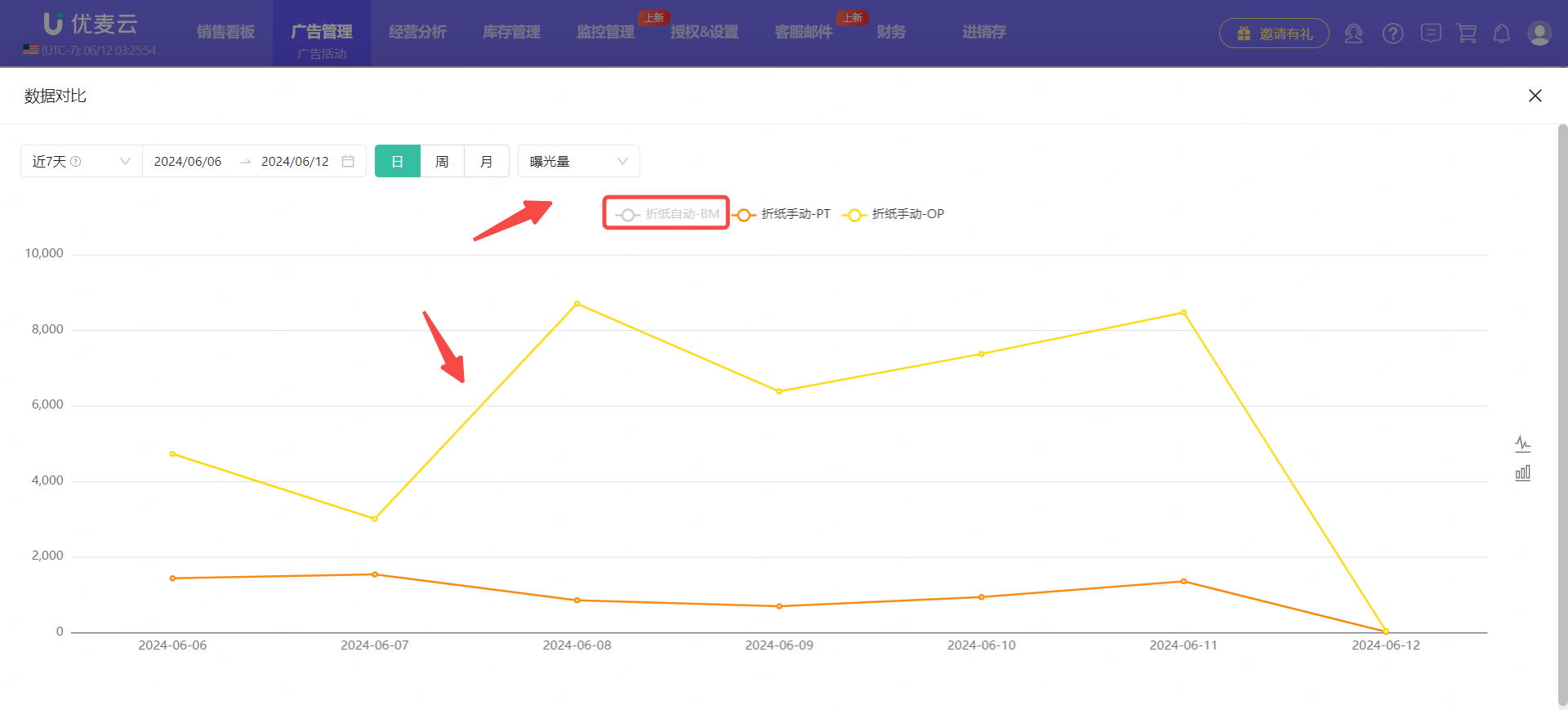 +
+
In addition to line charts, we can also view and analyze comparison data in the form of bar charts.
Click the chart mode on the right to switch with one click.
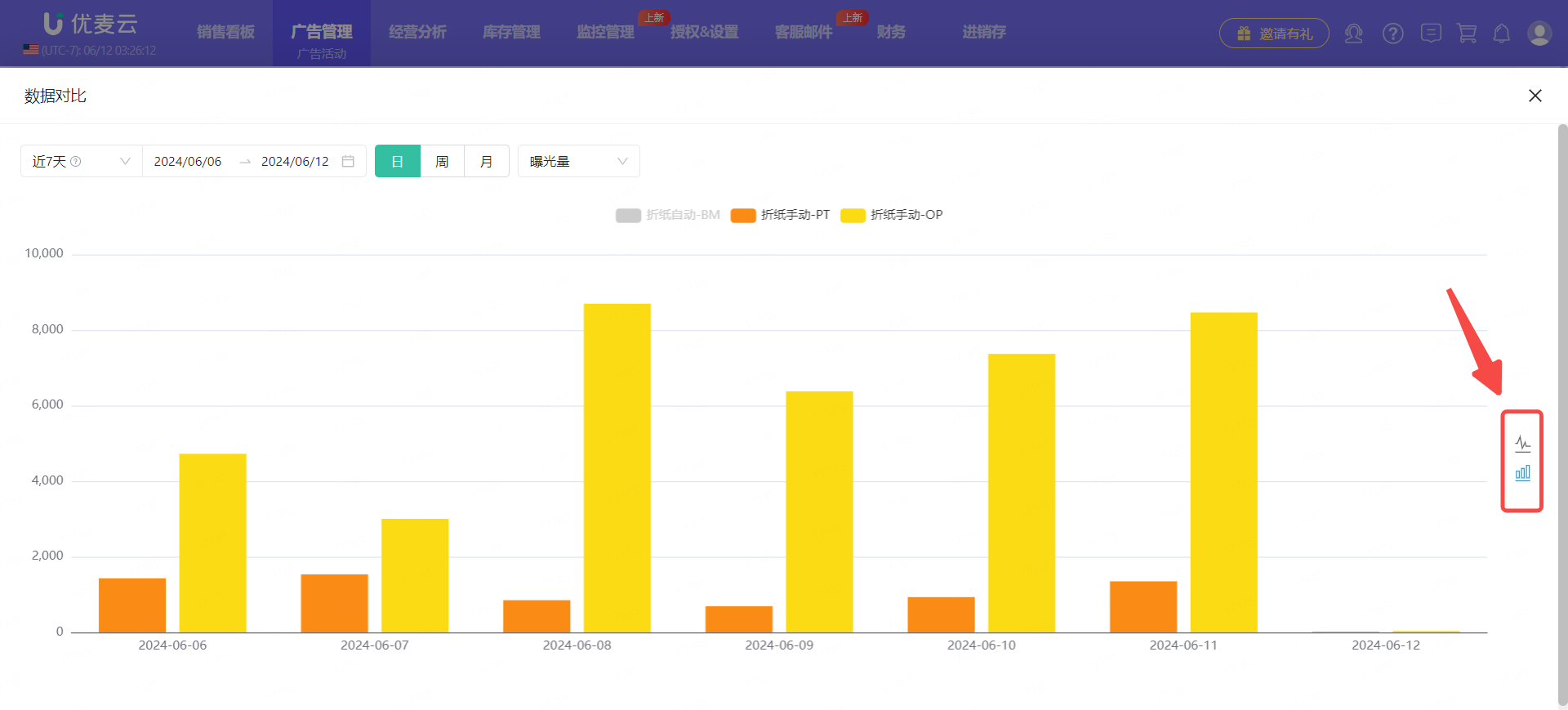 +
+
2.12 Quick Jump Query
Campaign data is not displayed in isolation. It is linked with other dimensions of advertising data. For example, after analyzing campaign data, if you want to further see the promoted products under the campaign, which keywords are being targeted, how many search terms are matched, etc., you can quickly jump to the corresponding function to directly view and analyze.
① Ad groups
Click "Campaign Name" to jump to view the data of all Ad group dimensions under the campaign.
 +
+
② Promoted Products
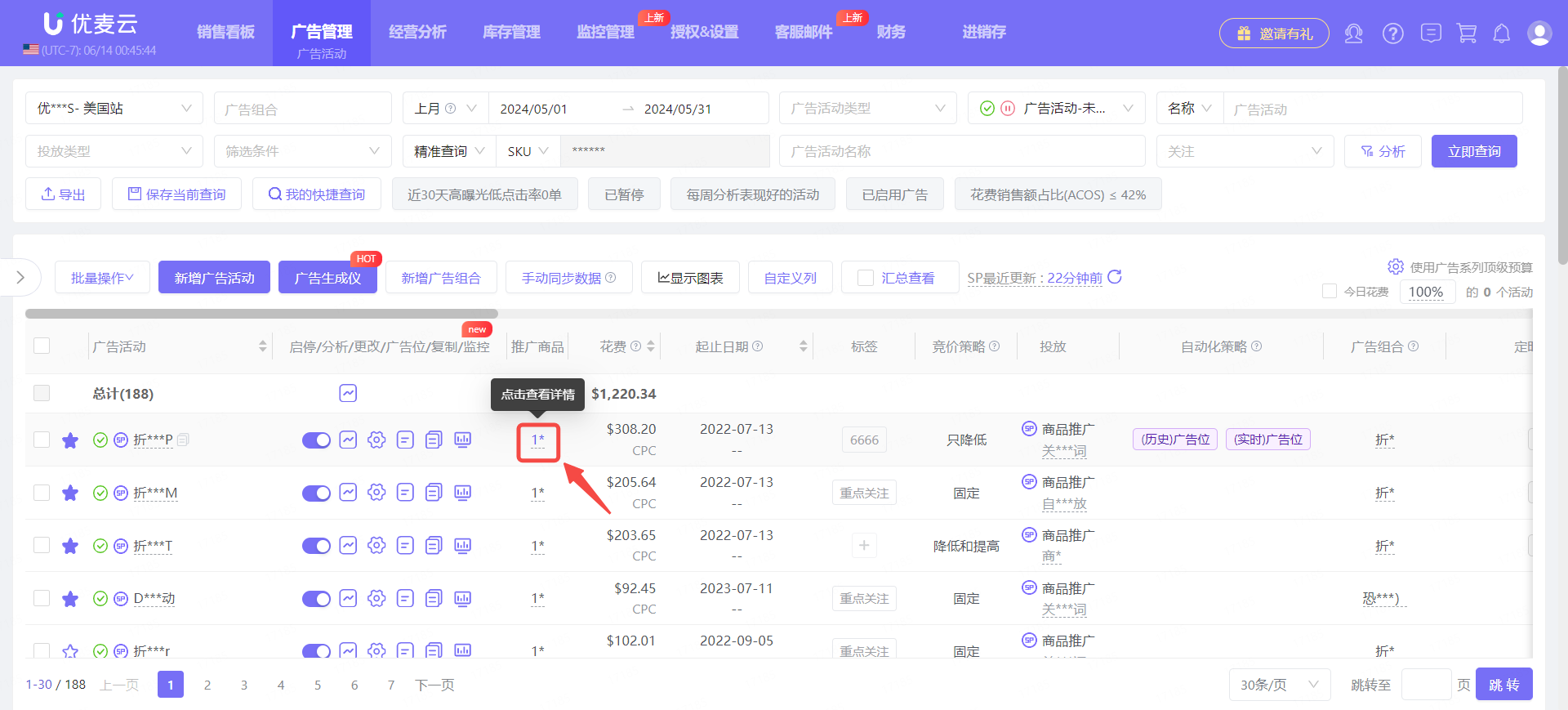 +
+
③ Targeting Details (Automatic/Keyword/Product Targeting/Audience Targeting, etc.)
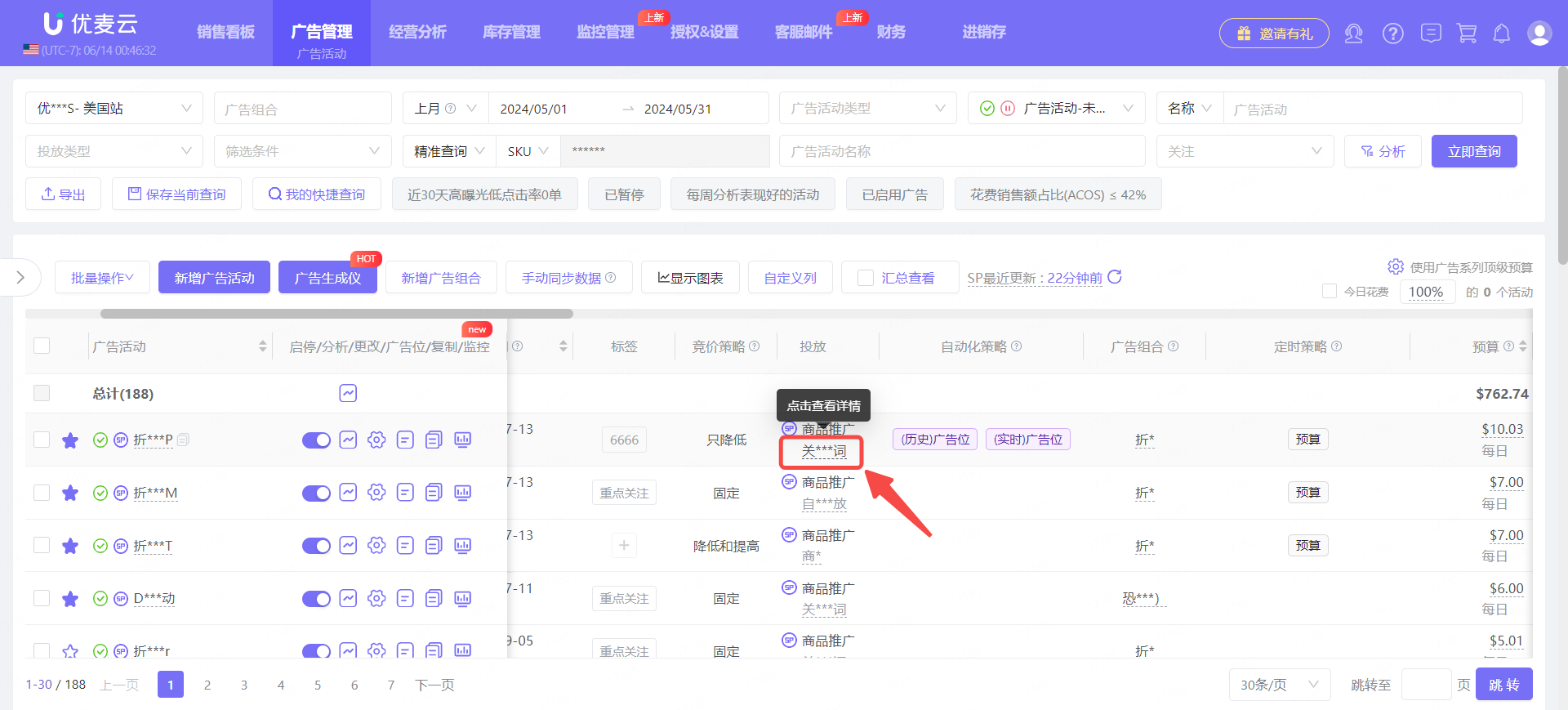 +
+
④ Search Terms
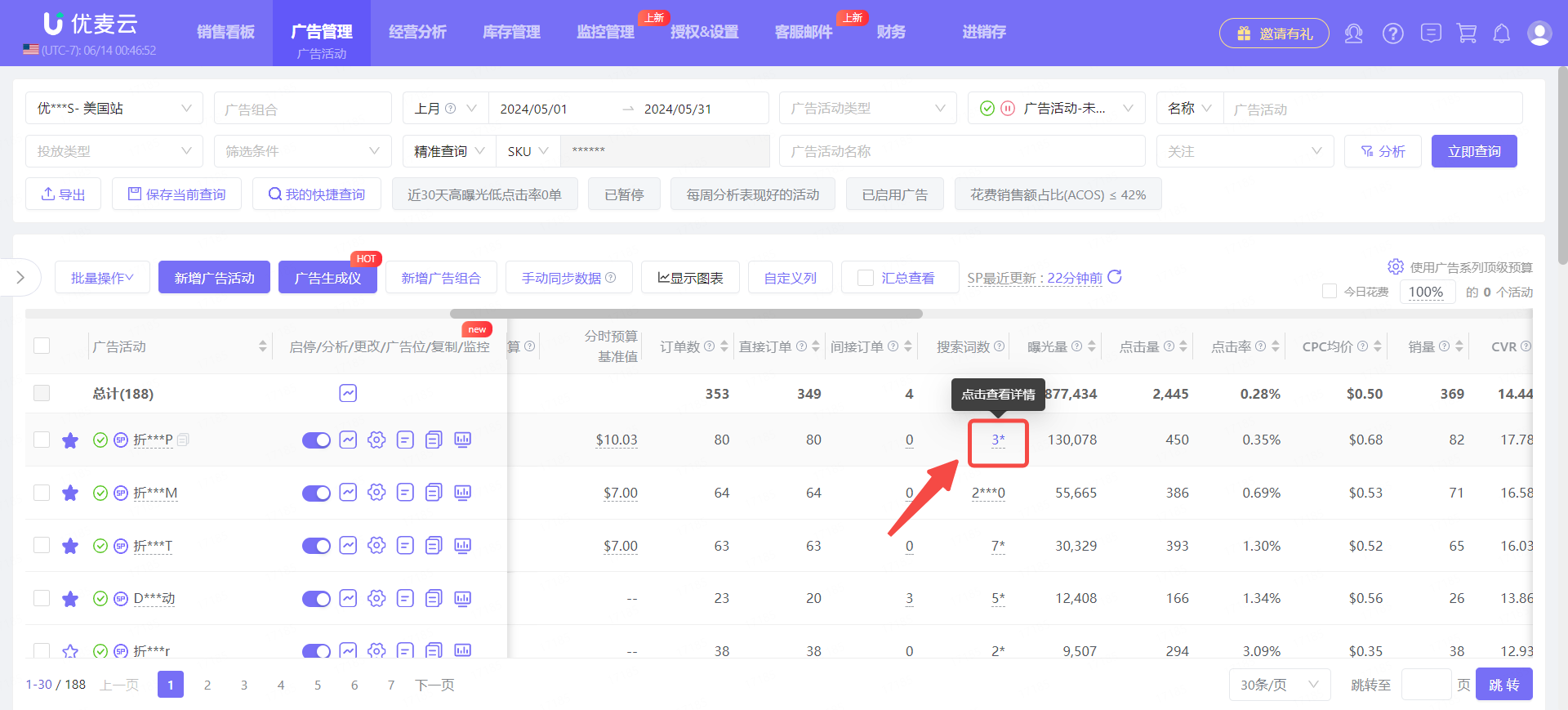 +
+
⑤ Indirect Orders
Amazon ad orders may have a situation: the ad has no spend, but there are orders and ACOS performance. What's going on?
This is because the buyer saw your ad product A, clicked in, and finally purchased ad product B. When Amazon attributes, it will calculate the ad spend to ad A, but the order is calculated to ad B.
In this case, in addition to directly purchasing ad product B, buyers may also purchase non-ad product C. At this time, the order of non-ad product C is an indirect order.
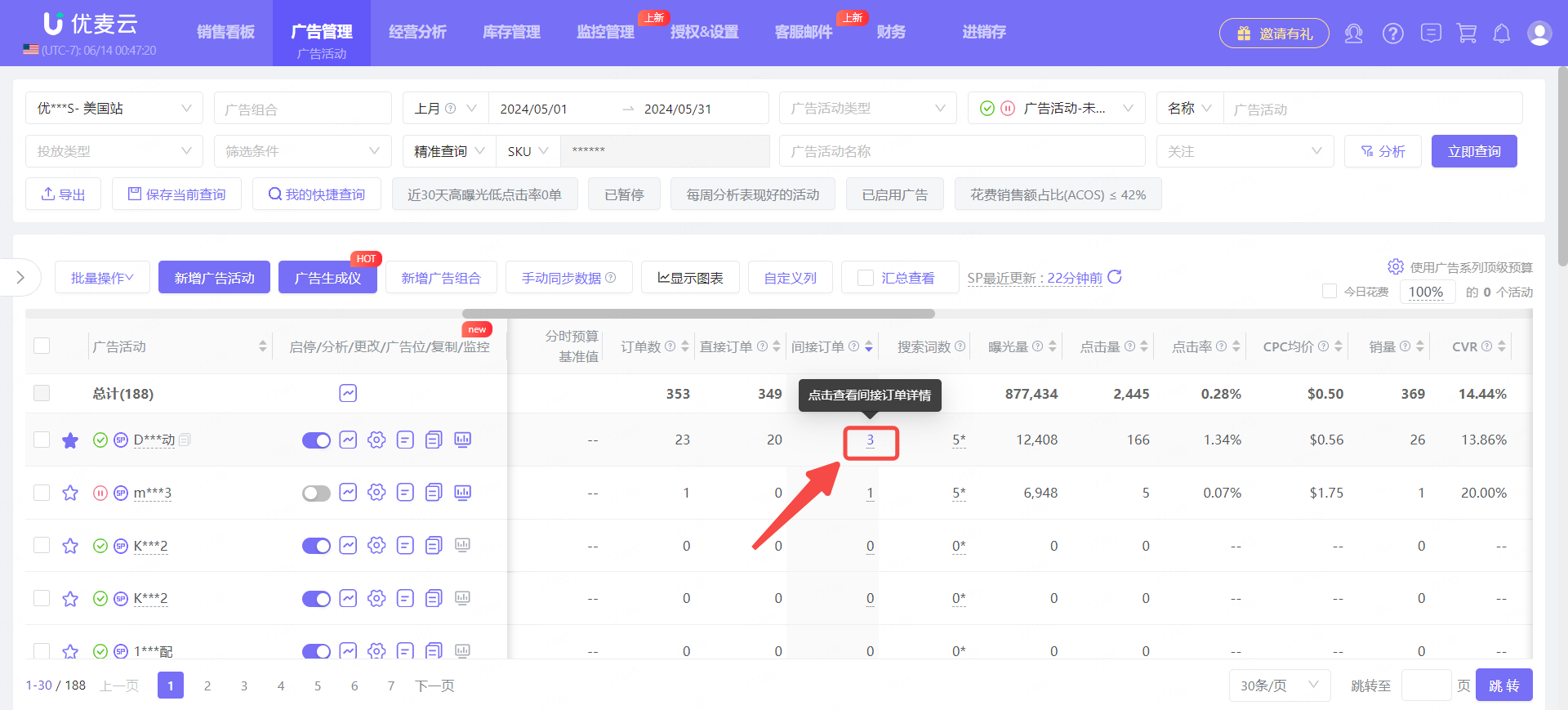 +
+
2.13 Tree Navigation List
This function is mainly for sellers who are familiar with Seller Central and have just started using SellerSpace. In order to make these users familiar with SellerSpace faster, SellerSpace has launched the 【Tree Navigation List】, which fits the display form of Amazon backend ads and makes the ad structure clear at a glance!
Click the button on the left to open or collapse the tree navigation function.
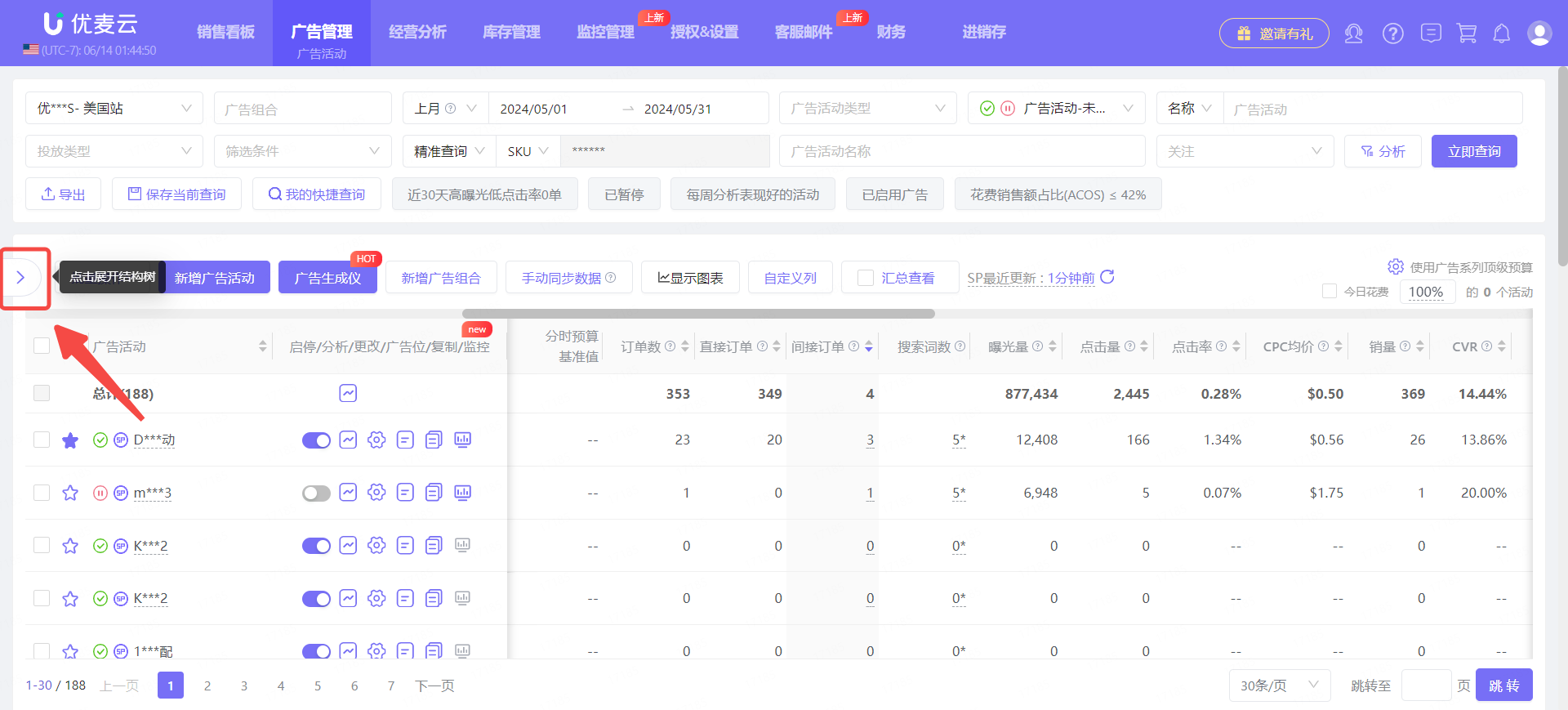 +
+
Click the small plus sign "+" to expand the next-level ad category and view the corresponding ad targeting data;
Click the small minus sign "-" to collapse the ad object.
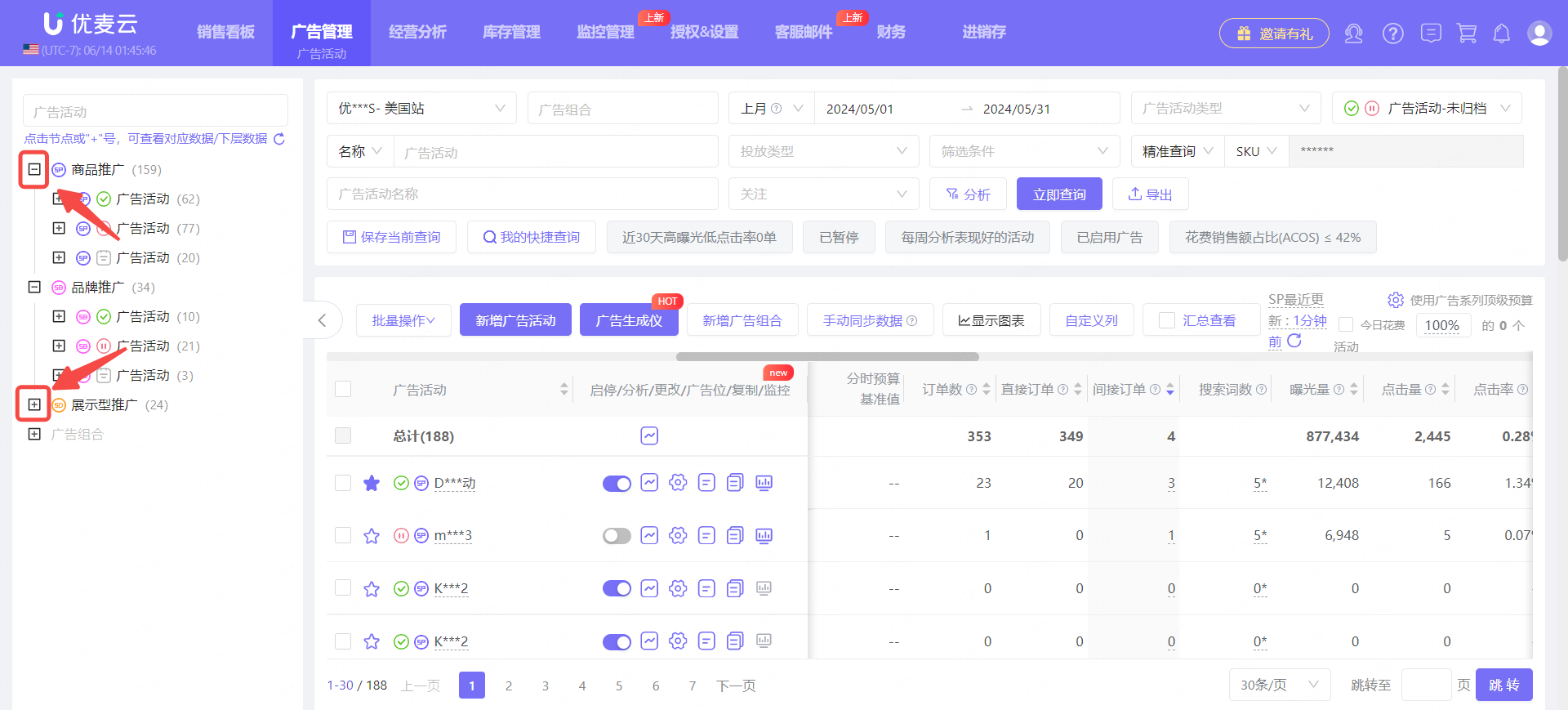 +
+
Click the node name to directly view the detailed data of the ad.
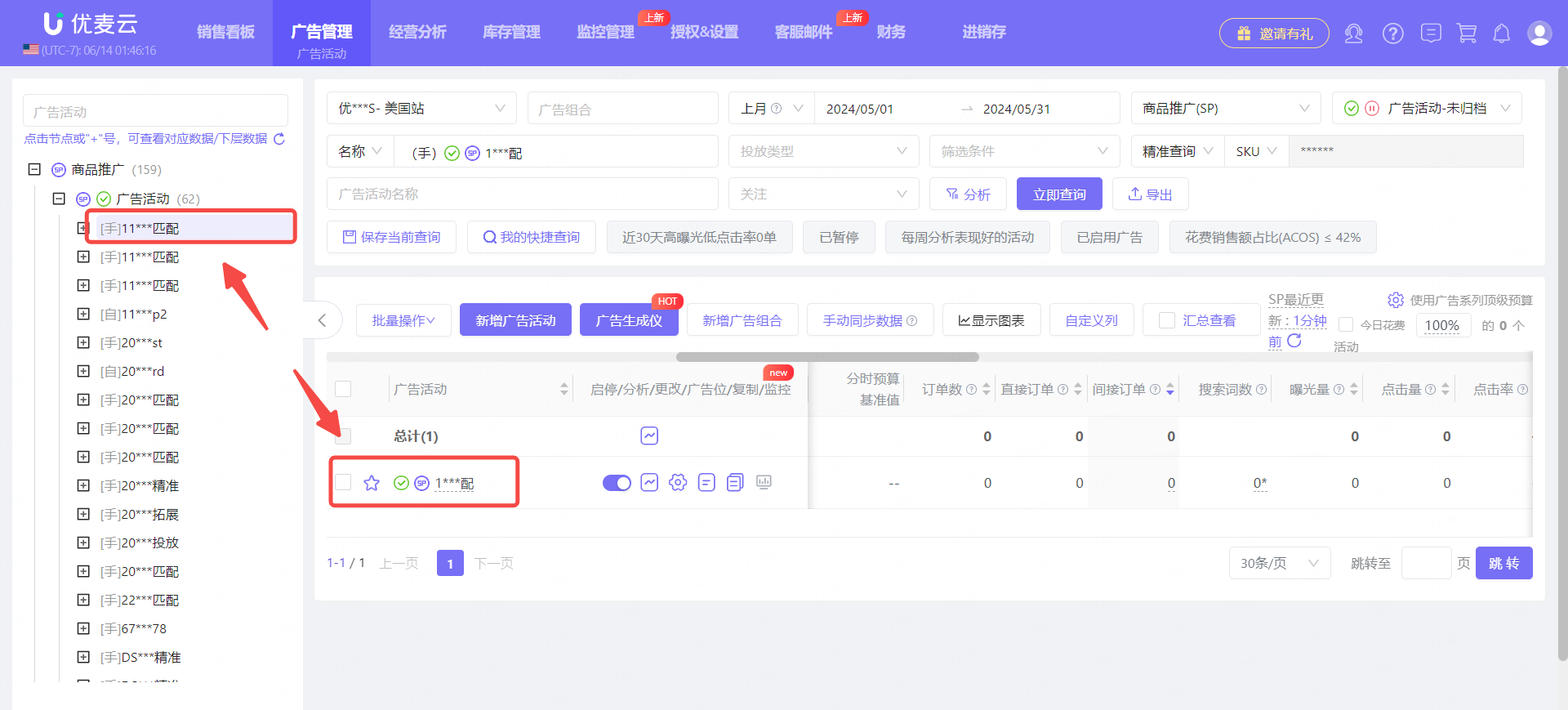 +
+
3. Adjust Ad Targeting
SellerSpace's advertising system, in addition to directly analyzing all campaign data, also supports directly adjusting campaign targeting. The adjusted data is synchronized to Amazon Seller Central in real-time, which is safe and reliable.
3.1 Adjust Budget
We can directly adjust the budget of the campaign.
There are 2 ways to adjust: individual adjustment + bulk adjustment
① Individual adjustment
Click the budget amount to directly adjust the budget.
If the campaign is bound to a Hourly Budget Strategy, you can choose to modify the benchmark value of the Hourly Budget at the same time when adjusting.
 +
+
② Bulk adjustment
Select the campaigns to be bulk budget adjusted and click 【Adjust Budget】 to enter the settings page.
 +
+
Enter the settings page.
Select the method of bulk budget adjustment, and then enter the corresponding amount or percentage and save.
 +
+
3.2 Set Budget Cap
Campaign budget cap refers to the total budget cap for all 【Sponsored Products】 campaigns in the entire store.
There are two types of budget caps: Daily Budget Cap and Campaign Top Budget.
Daily Budget Cap: Refers to the maximum daily spend for all Sponsored Products campaigns in the account;
Campaign Top Budget: Refers to the highest spend for all Sponsored Products campaigns in the account within a specified date range.
When the Sponsored Products budget cap is reached, all Sponsored Products campaigns will stop targeting.
Click the budget cap setting button to enter the settings;
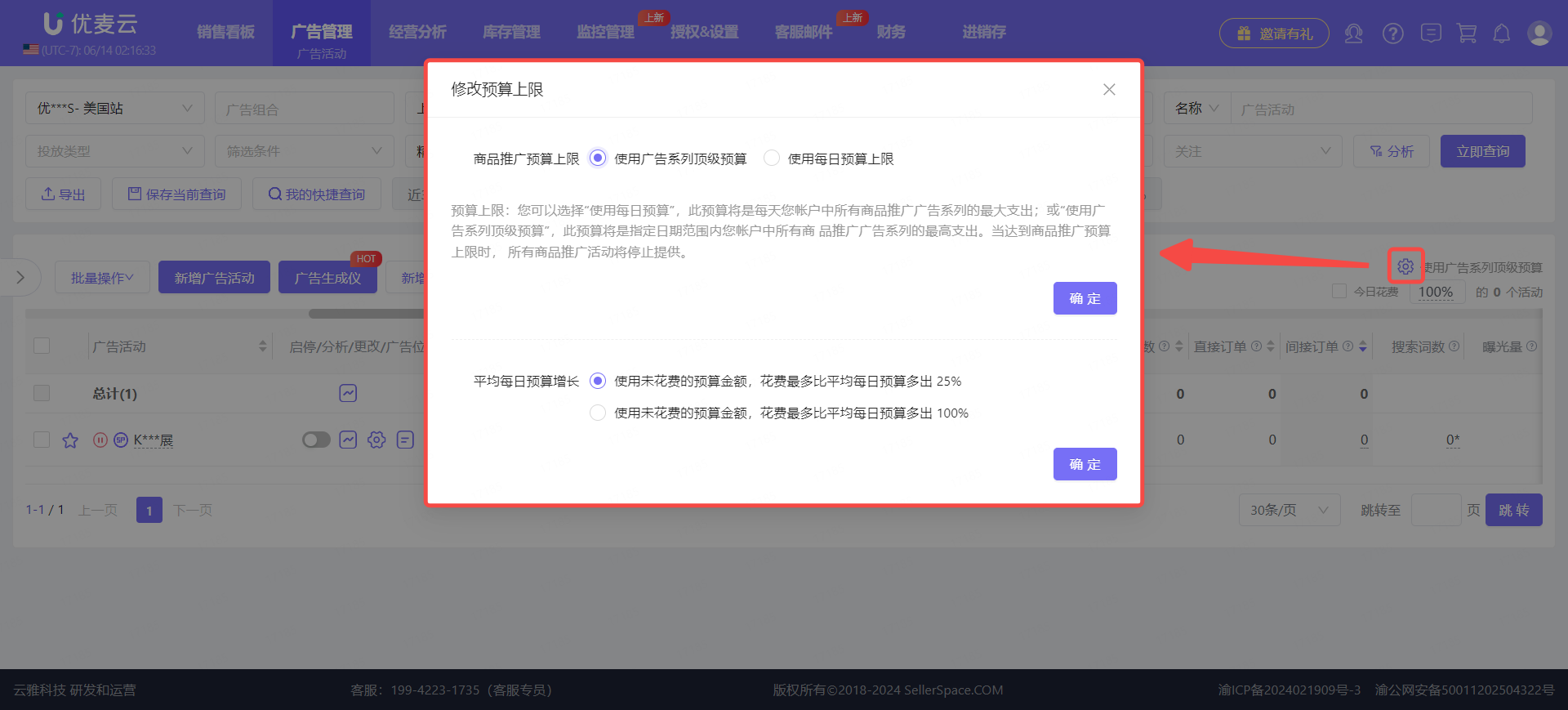 +
+
3.3 Modify Campaign Settings (including Negatives)
We can directly modify campaign information in the SellerSpace system, such as: campaign name, campaign end time, and add negative targeting, etc.
The content to be modified is different depending on the campaign type.
Sponsored Products: Change basic campaign settings information + Add negative targeting
Sponsored Brands: Change basic campaign settings information + Change ad creatives
Sponsored Display: Change basic campaign settings information
The basic setting information of all types of campaigns is consistent with the operations when creating new ones. You can modify them according to your needs.
Take Sponsored Products as an example:
Click the 【Change Campaign and Set Negative Targeting】 button to enter the settings page.
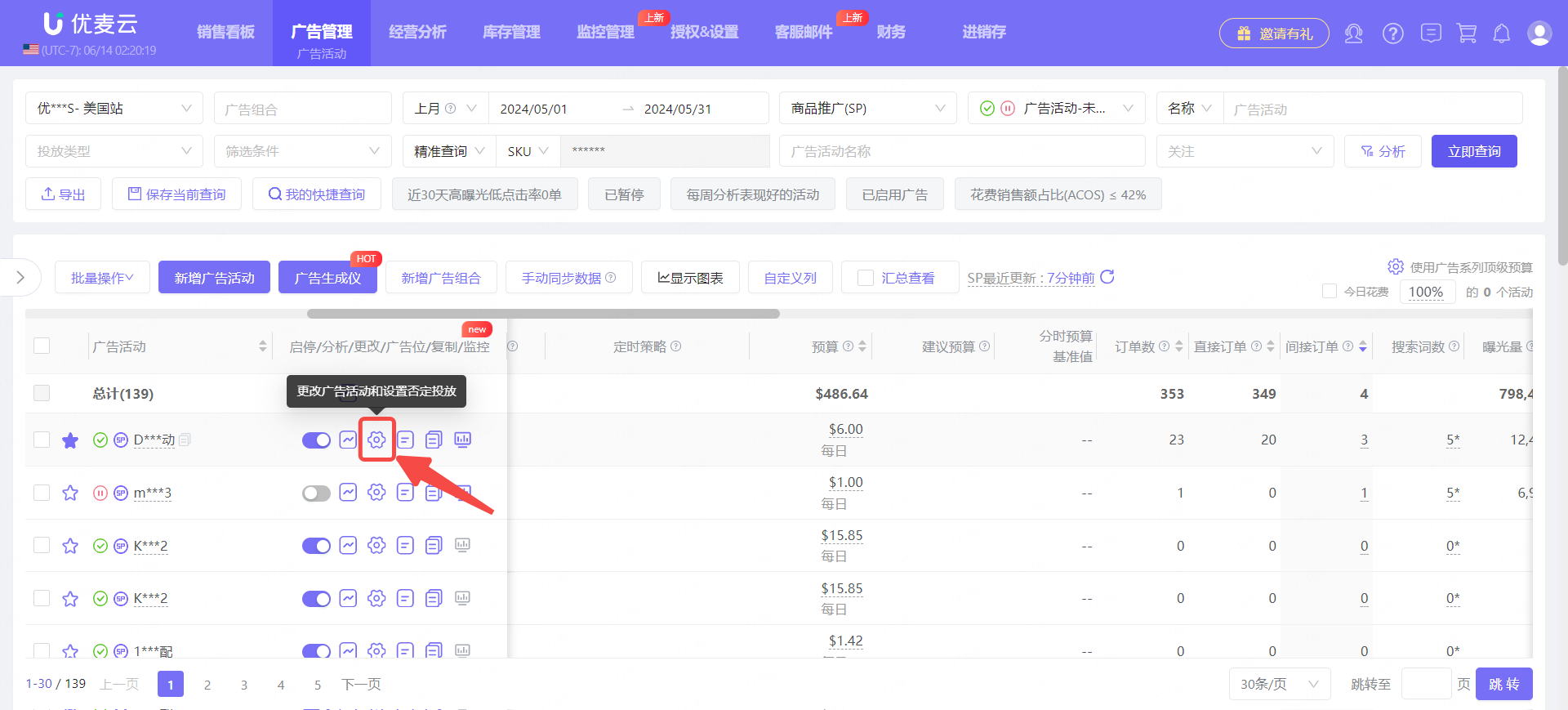 +
+
Enter the "Change Campaign" page.
We can modify all basic information of the campaign, such as campaign name, portfolio, start and end time, daily budget, etc.
The start and end time of targeting support bulk adjustment. After checking, select 【Start Date】 or 【End Date】 to set.
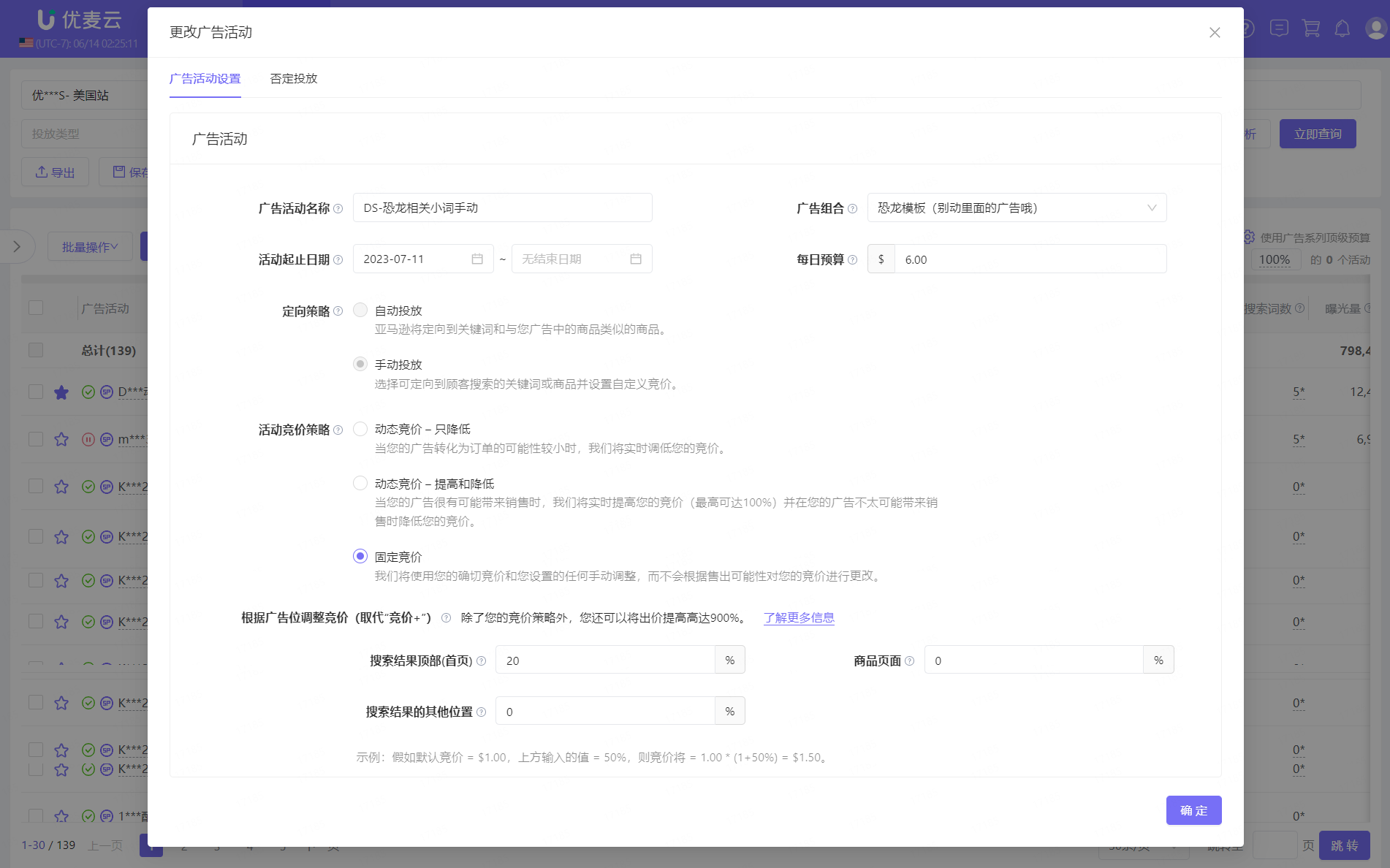 +
+
Click 【Negative Targeting】 to add negative targeting at the campaign dimension.
When adding, if we have bound a Seller Sprite account, we can directly use the keyword library and product library data created in Seller Sprite to add negatives with one click.
If you have added negative targeting in Seller Central and it has not been synchronized to the SellerSpace system, you can also click 【Synchronize Negative Keywords/Products】 to synchronize with one click.
The already negated targeting objects also support 【Export】. Click the 【Export】 button to export with one click.
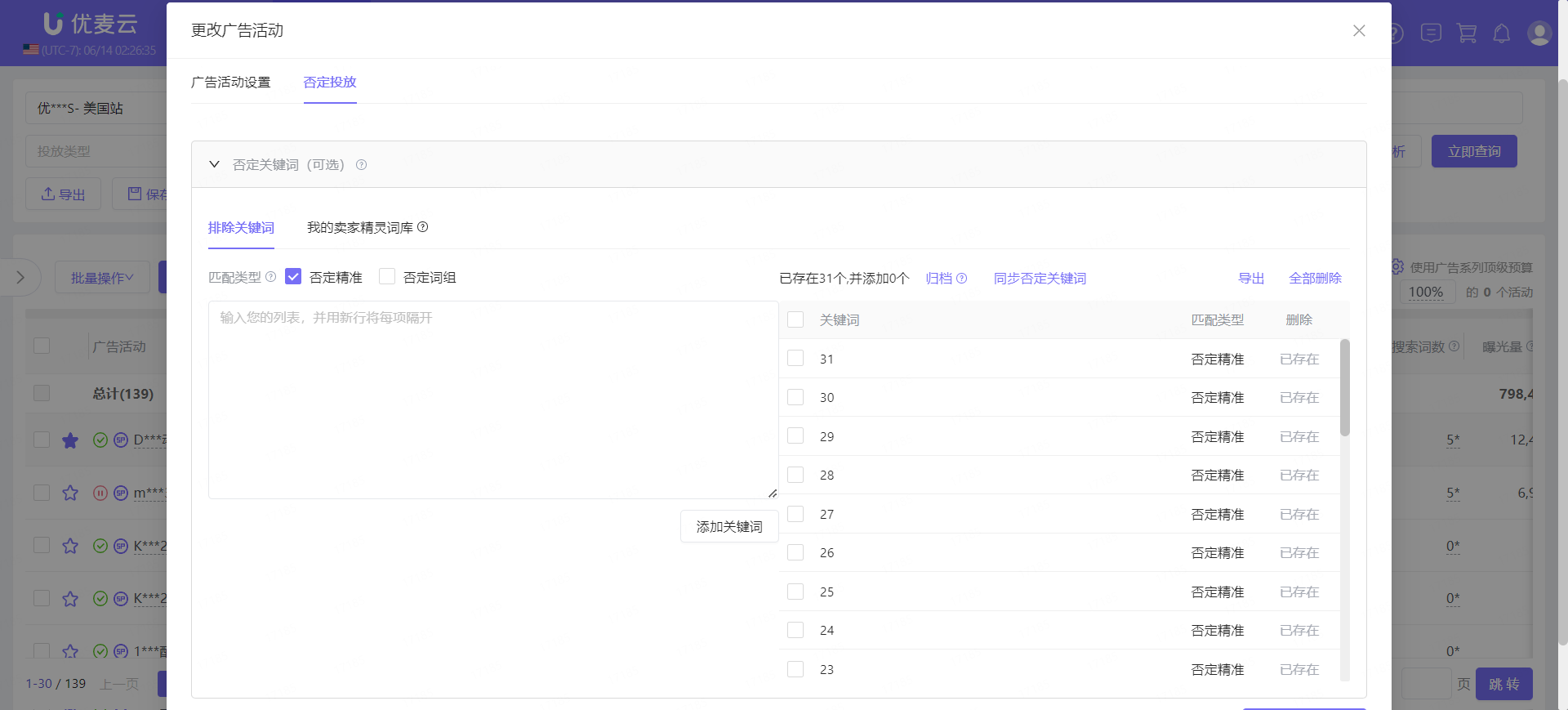 +
+
3.4 Bulk Modify Name
When we create campaigns for the same product or in the same naming method, such as bulk creating campaigns (creation method see: 1.5 Campaign Generator), if you want to modify the names of some created campaigns, bulk modification is supported.
Check the campaigns whose names you want to modify and click 【Modify Name】 to enter the bulk modification page.
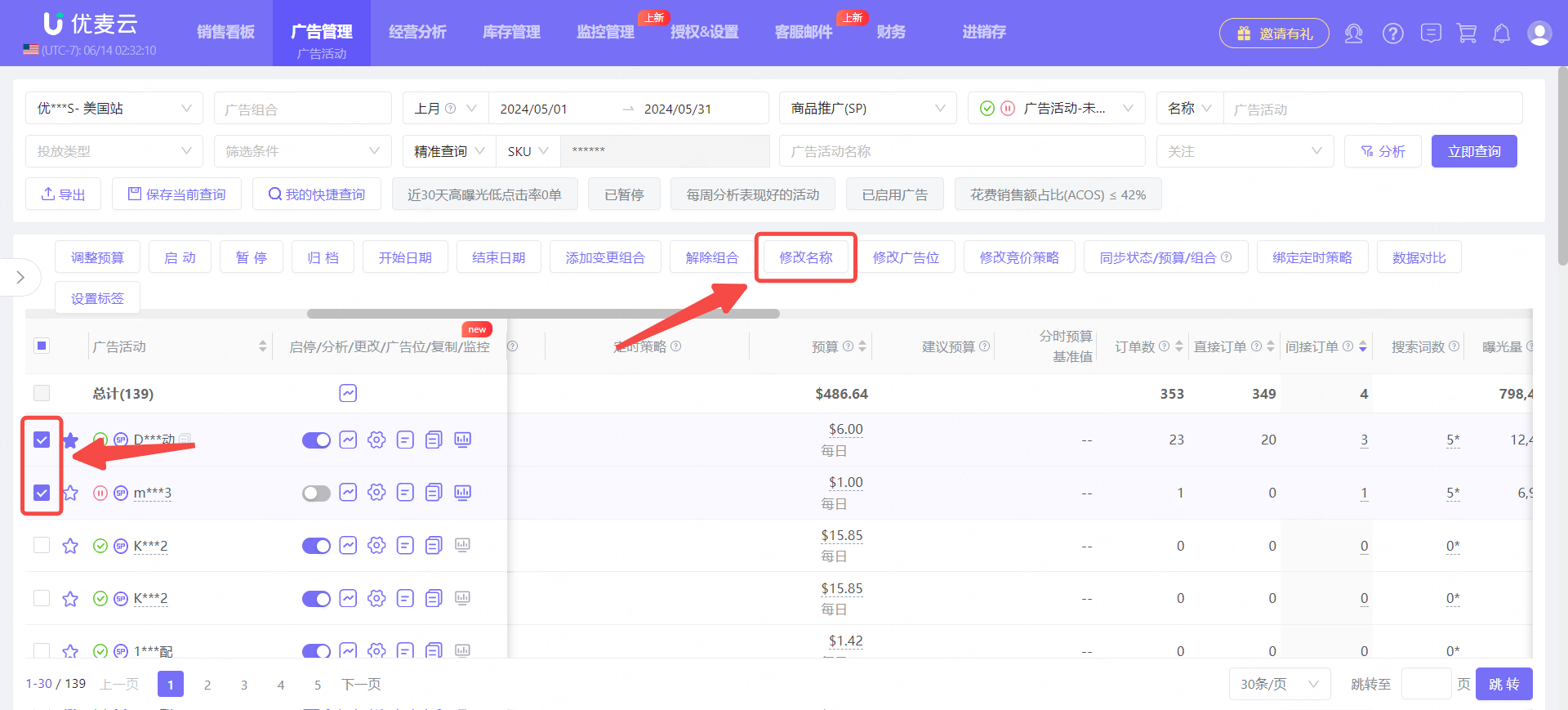 +
+
Enter the "Bulk Modify Campaign Name" page.
Directly replace certain words in the campaign name.
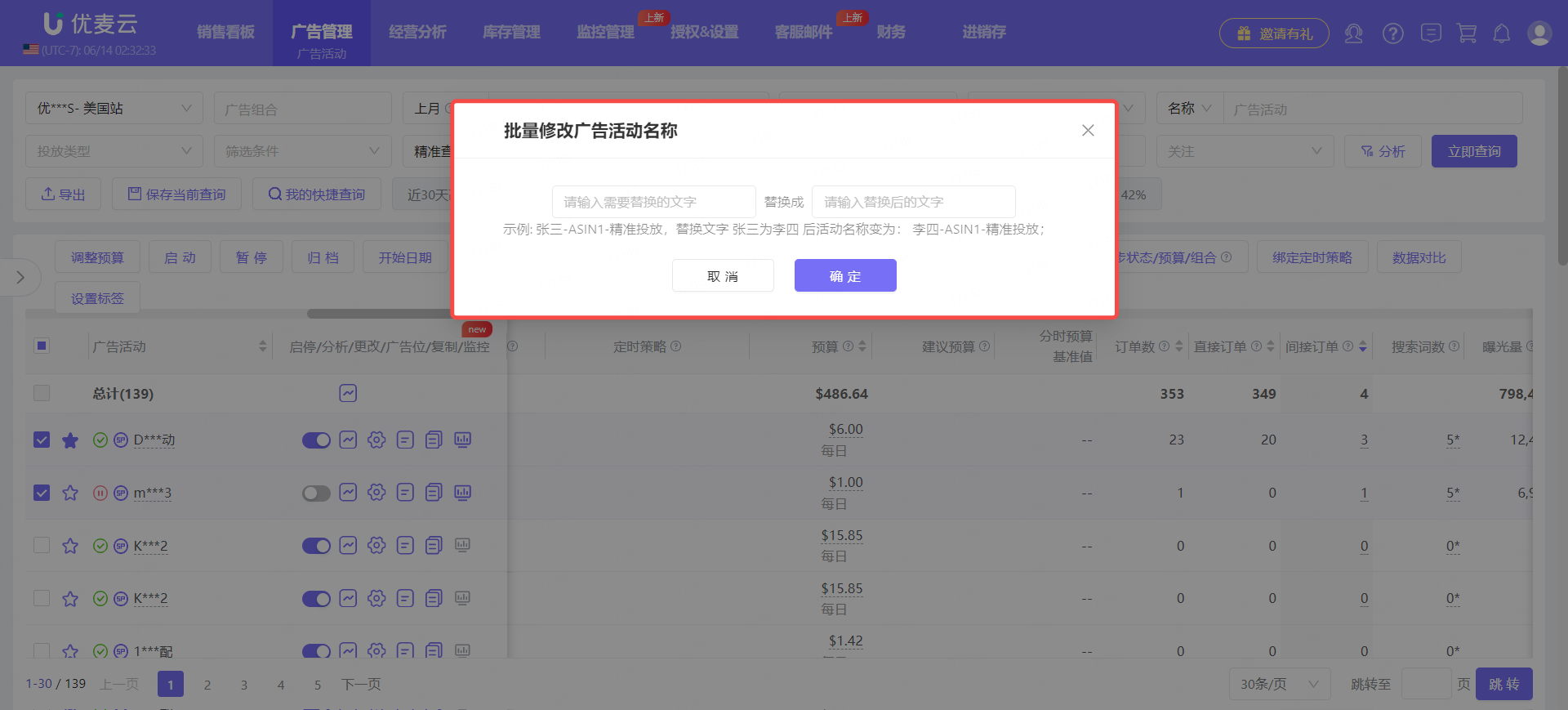 +
+
3.5 Bulk Modify Bidding Strategy
Consistent with the purpose of 【Modify Name】, we can also uniformly modify the bidding strategy for certain campaigns.
Bidding strategies: Dynamic bids - down only, Dynamic bids - up and down, Fixed bids.
Check the campaigns whose bidding strategy you want to modify and click 【Modify Bidding Strategy】 to enter the modification page.
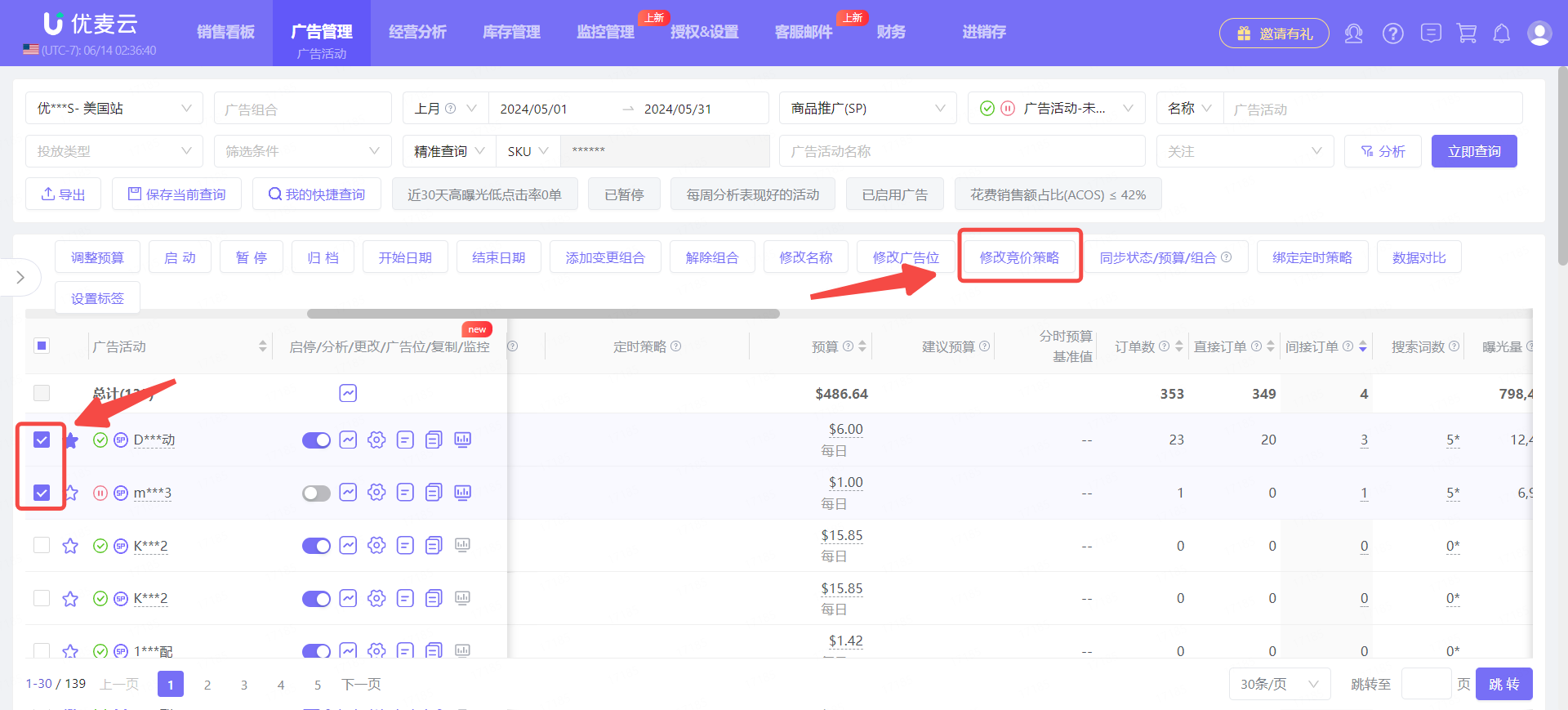 +
+
Enter the "Bulk Modify Bidding Strategy" page.
Select the bidding strategy to be targeted and click 【Confirm】 to save.
 +
+
3.6 Bulk Modify Placements
Consistent with names and bidding strategies, placement bid adjustments for campaigns also support bulk modification.
Placements: Top of search results (first page), Rest of search results, Product pages.
Check the campaigns to be bulk modified and click 【Modify Placements】 to enter the modification page.
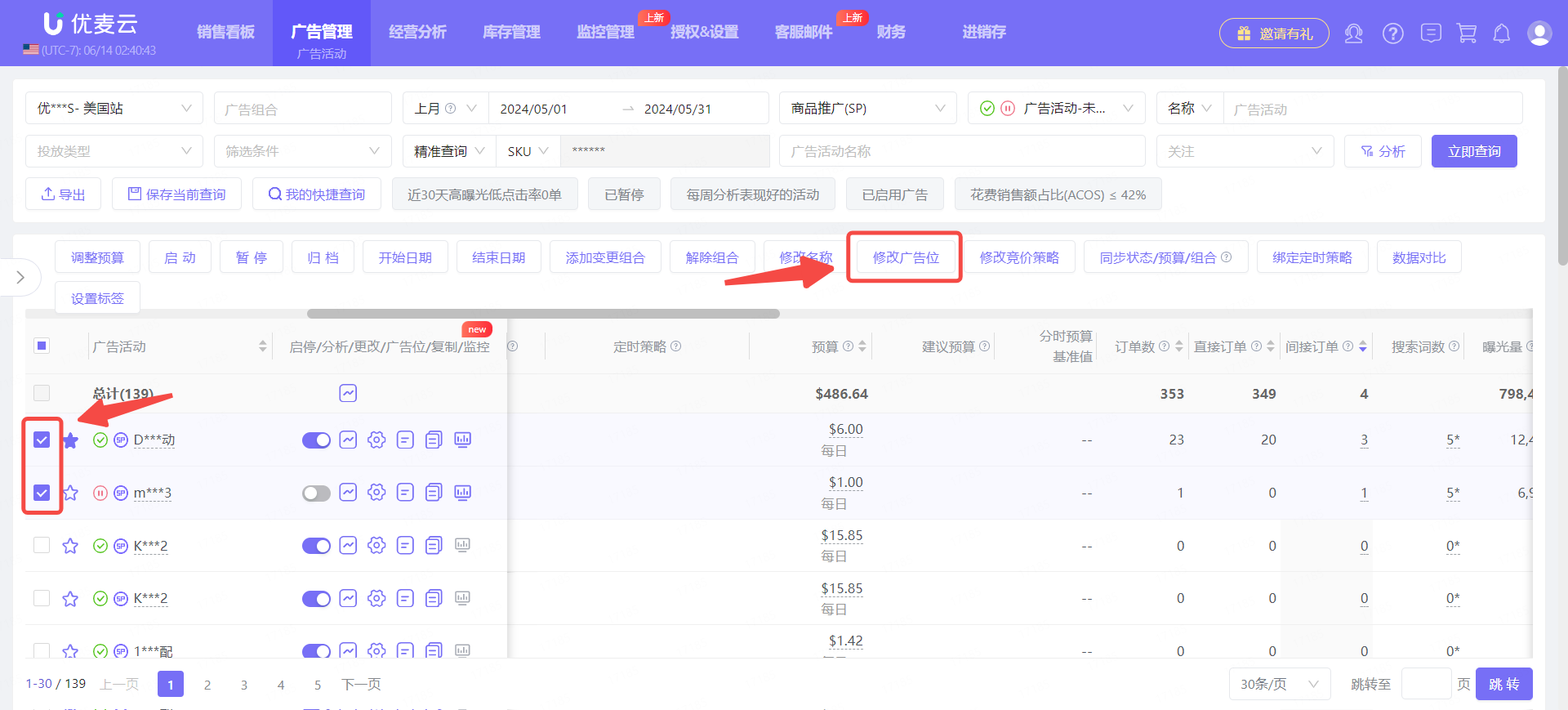 +
+
Enter the "Bulk Modify Placement Bid Adjustments" page.
Check the ad placements to be uniformly adjusted, select the uniform adjustment method, and then enter the corresponding adjustment value and save.
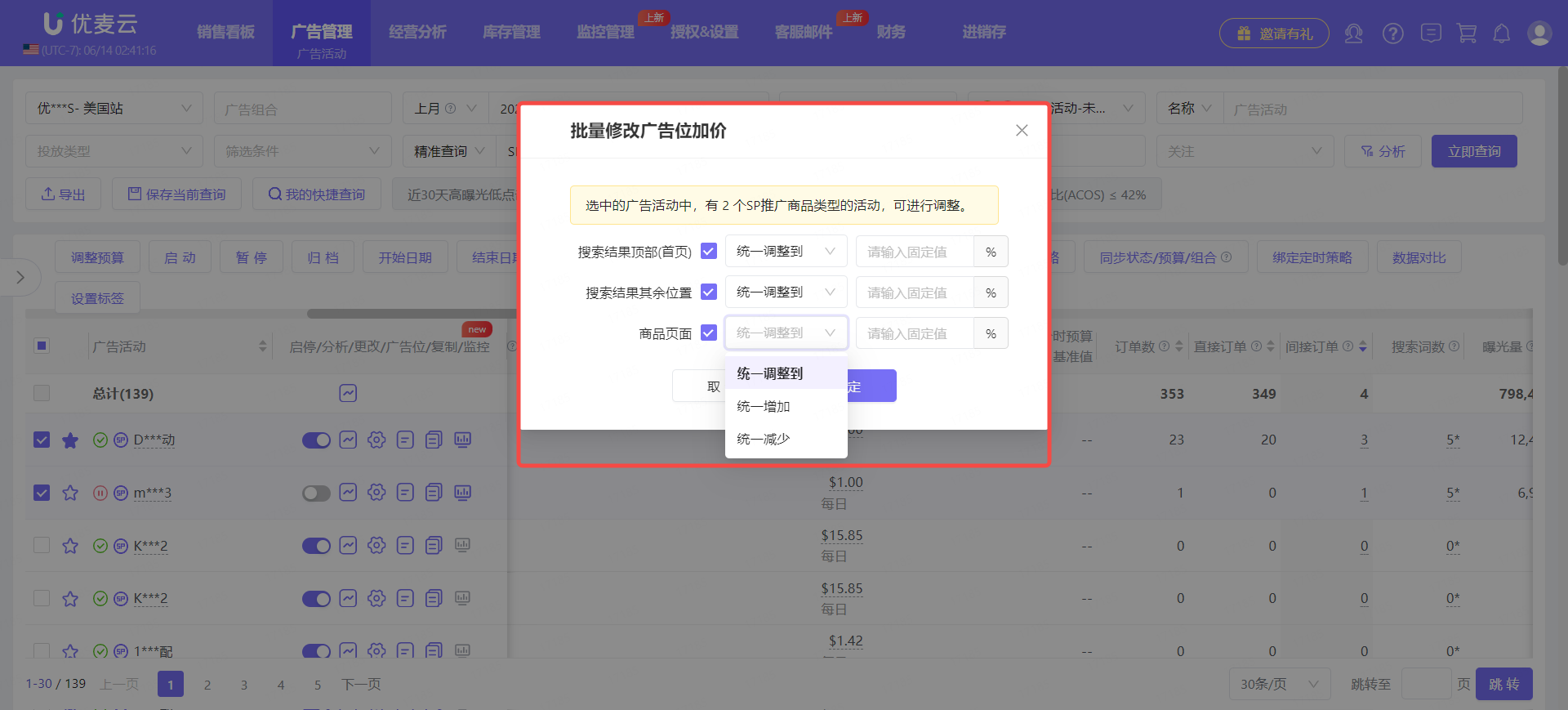 +
+
3.7 Enable/Pause and Archive
Same as Seller Central, we also support enabling, pausing, and archiving campaigns.
There are 2 operation methods for "Enable" and "Pause": individual operation + bulk operation, while "Archive" only supports bulk operation.
① Individual operation
Find the campaign to be enabled or paused and click the Enable/Pause button to enable or pause with one click.
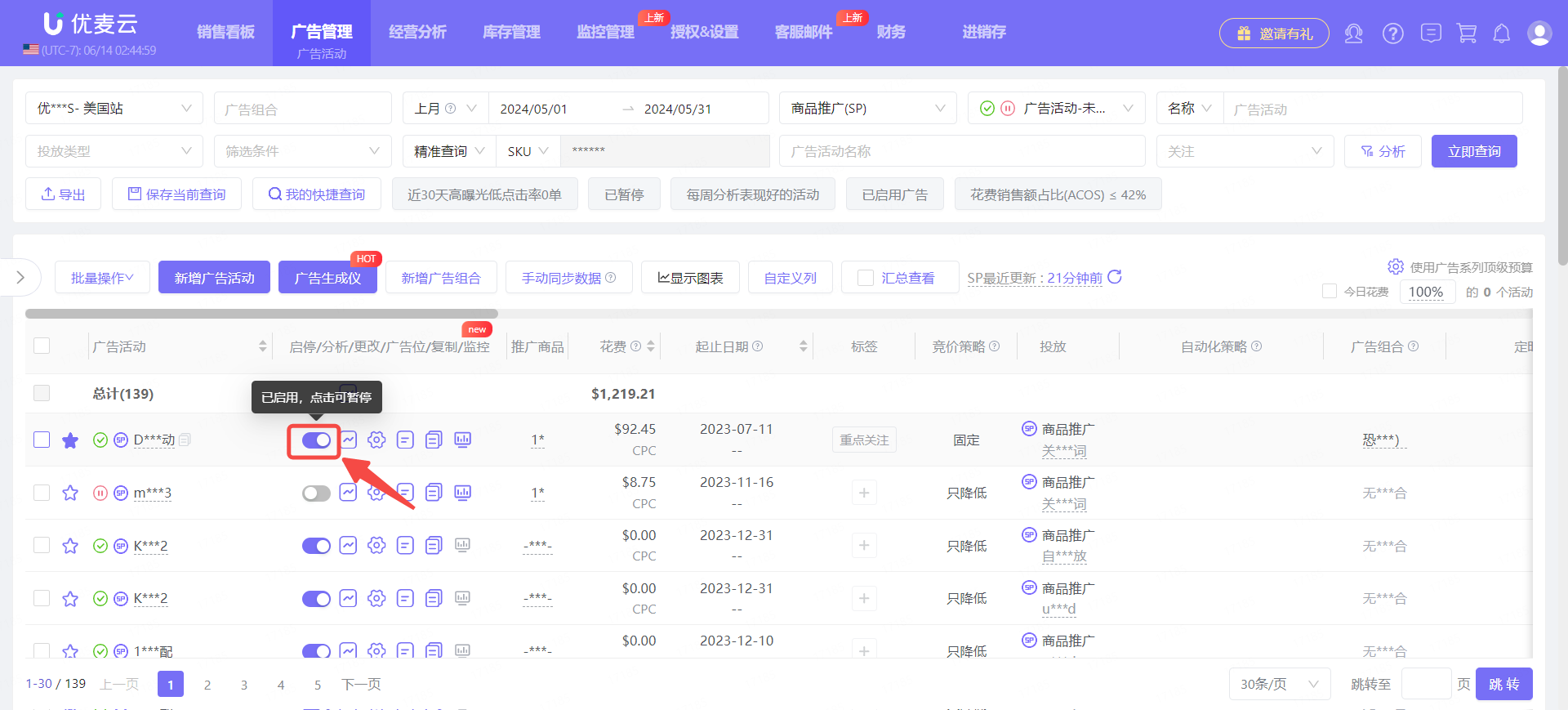 +
+
② Bulk operation
Check the campaigns to be bulk enabled/paused or archived, click the corresponding Enable/Pause or Archive button, and then confirm to save.
 +
+
4. Function Linkage
The campaign function is closely related to our other advertising enhancement tools and can be linked and combined with each other to further improve sellers' advertising benefits.
4.1 Keyword Monitoring
Keyword Rank Tracker is a core function in the SellerSpace plugin version, which can help us monitor the performance of our keywords in the top three pages of Amazon search results in real-time.
In the campaign function, we can also directly view the situation of a certain campaign entering the top three pages in (monitored/position targeted) keywords to help us understand the details of the number of times the corresponding campaign of the matched keywords enters the top three pages.
Click the view button to enter the data details page.
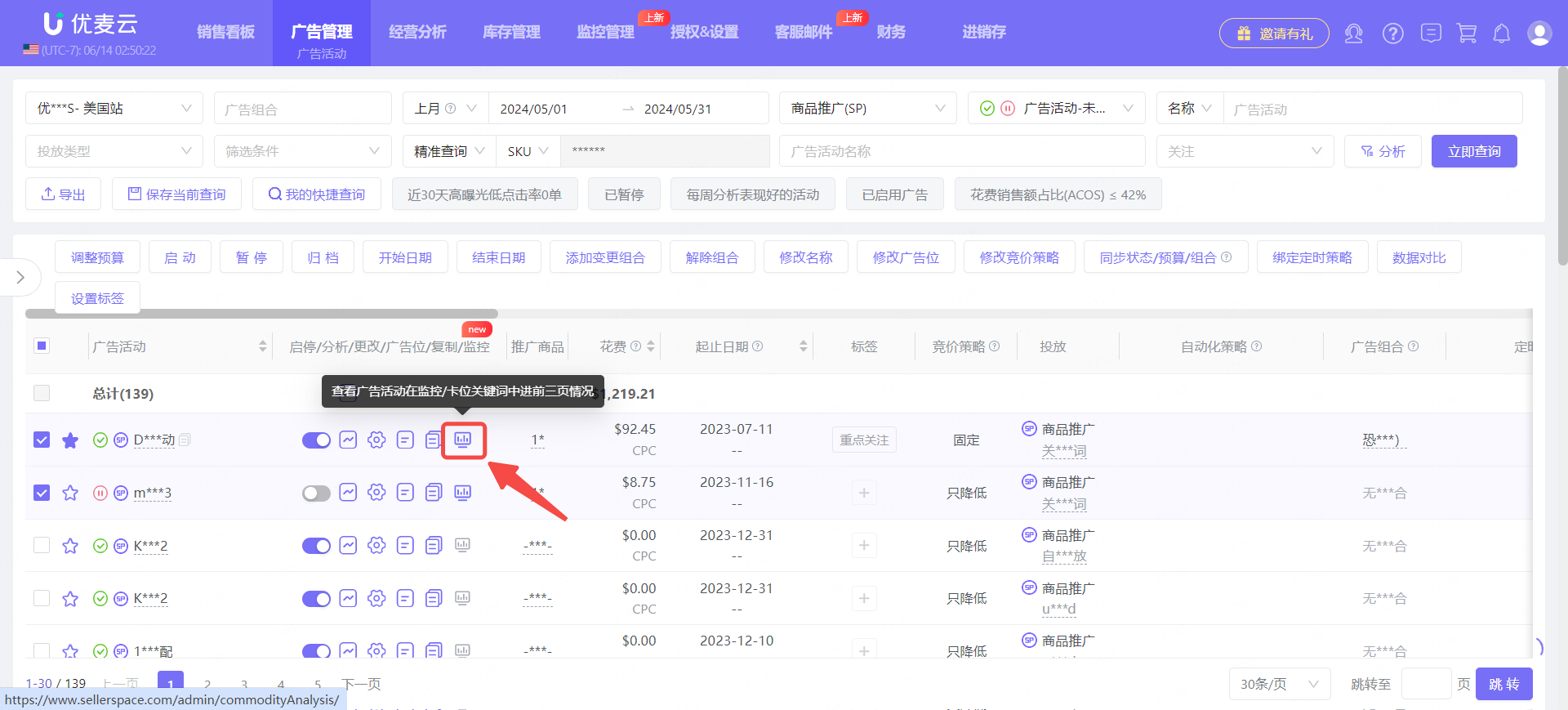 +
+
We can directly view the corresponding keywords, ad types, and the number of times they enter the top three pages.
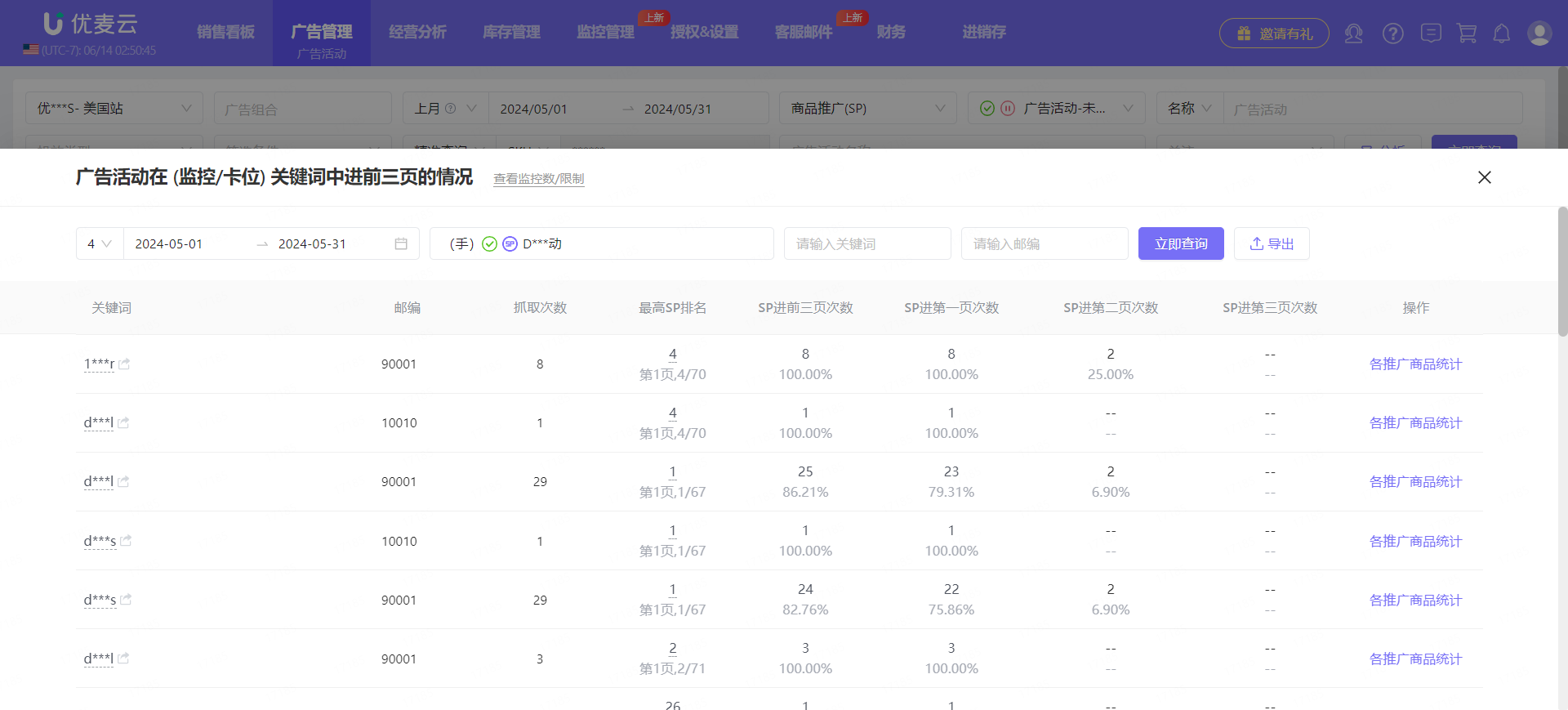 +
+
The currently queried data supports exporting.
Click the 【Export】 button to export with one click.
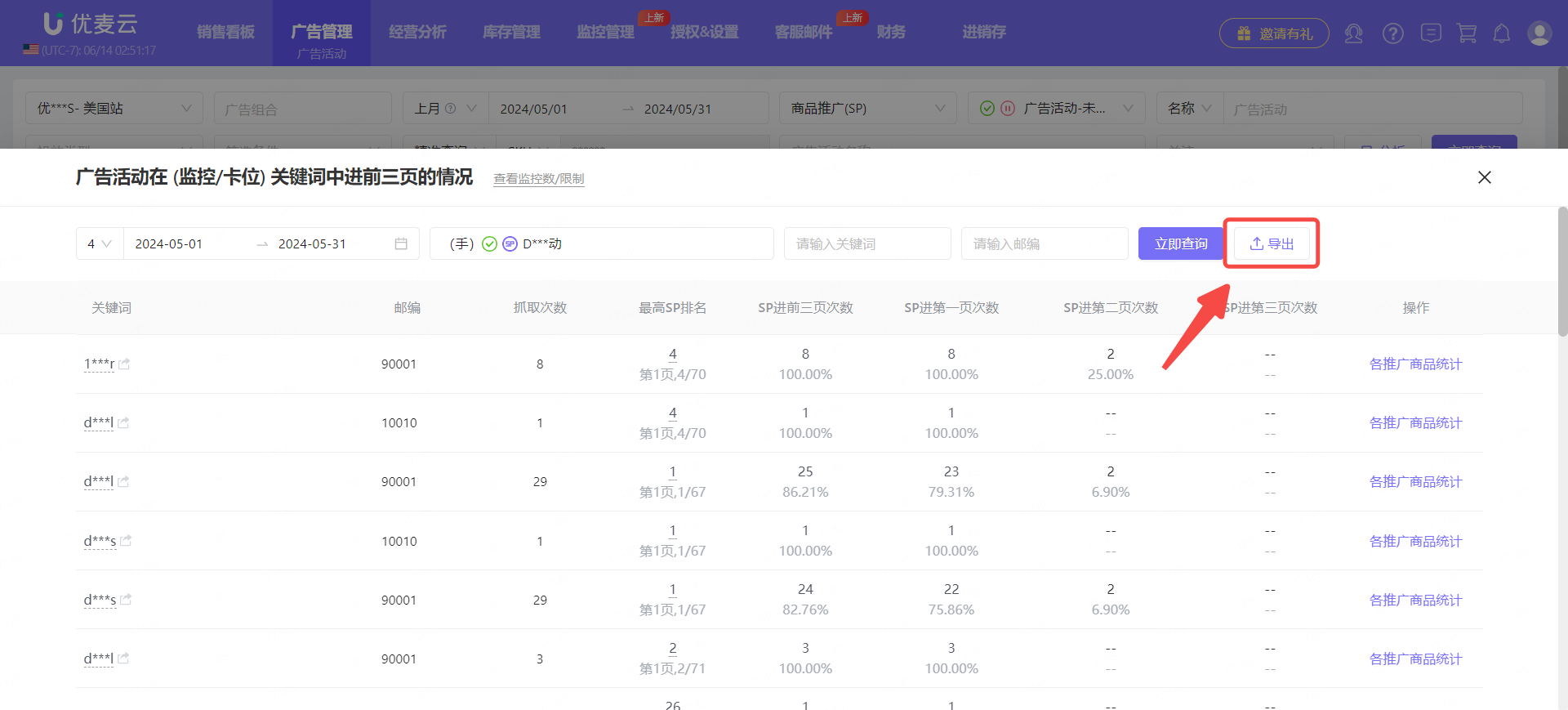 +
+
In addition to viewing keyword information, you can further view the detailed data of each promoted product under the keyword.
Click 【Statistics of Each Promoted Product】 to enter the data details page.
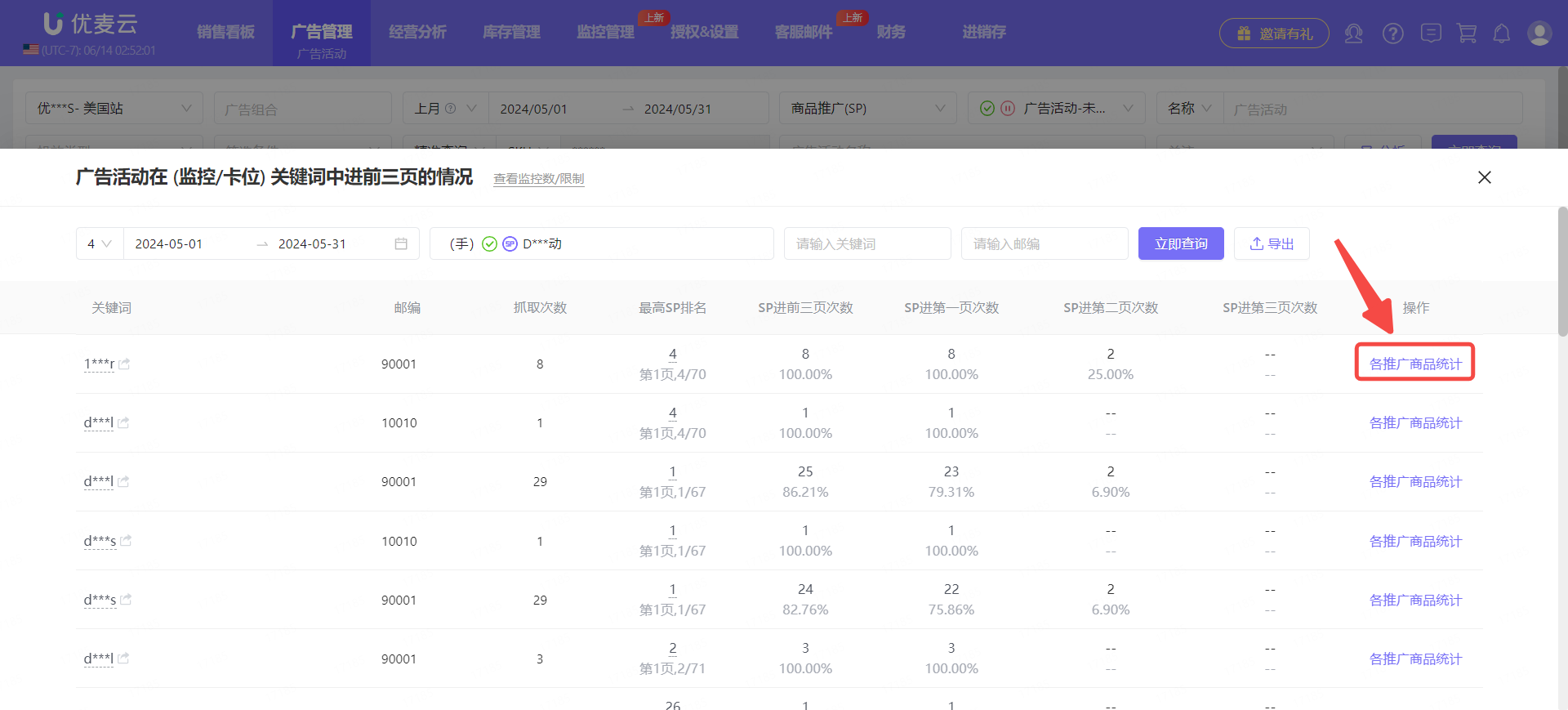 +
+
Enter the "Statistics of Each Promoted Product" page.
The viewing and analysis method of this page is consistent with 【Keyword Rank Tracker - Products Entering Top Three Pages】.
Keyword Rank Tracker - Tutorial with Images and Text: Click to view
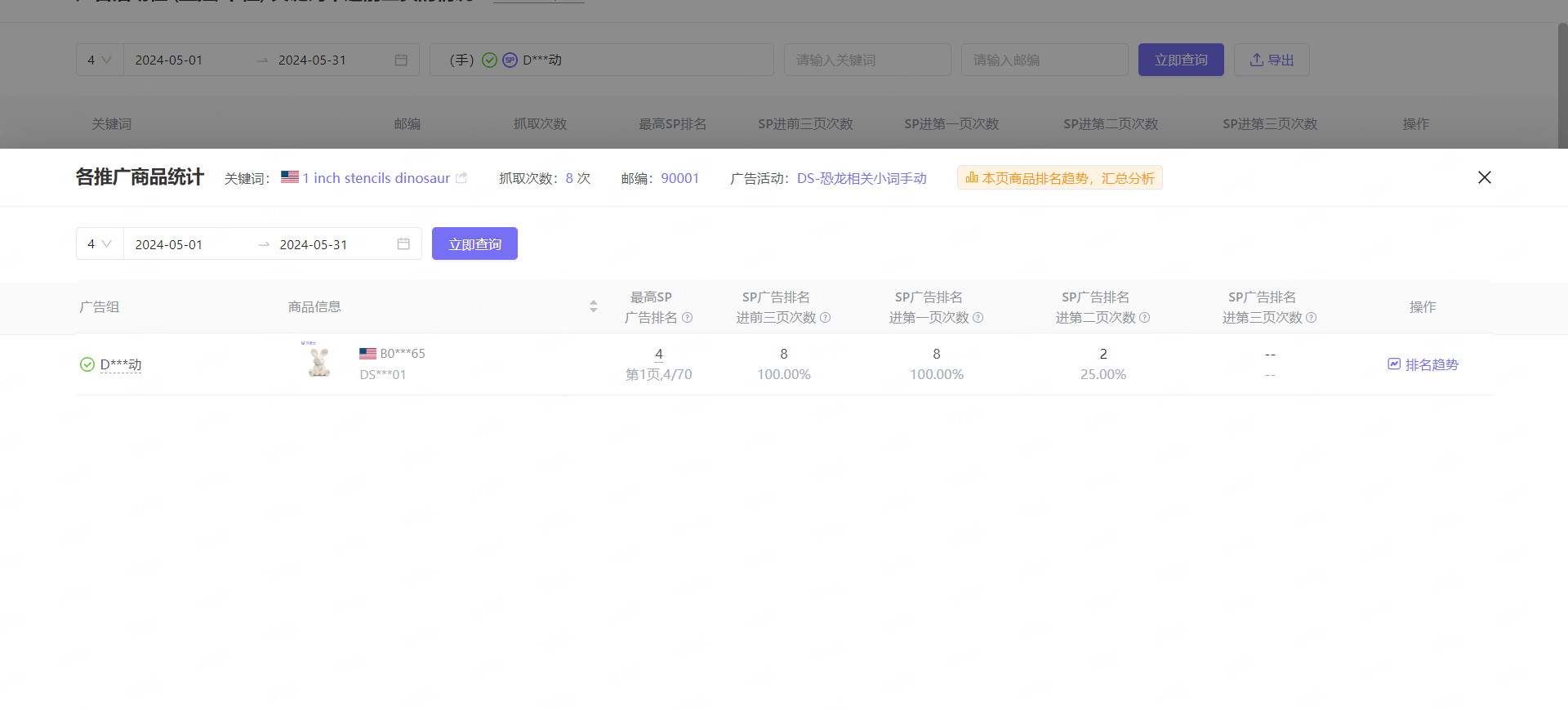 +
+
4.2 Automation Strategy
SellerSpace's 【Automation Strategy】 function automatically analyzes the historical data and real-time data performance of Amazon ads based on the strategies configured by sellers, and automatically adjusts ad bids, budgets, placements and other parameters based on ad performance. It also supports automatically expanding high-quality words in search terms, negating junk words, and pausing ads.
Analysis indicators include: Impressions, Clicks, CTR, Spend, CPC, Orders, CVR, CPA, Sales, ACOS, ROAS, Budget to Spend Ratio
Adjusted ad targeting values: Bid, Budget, Placement, Pause, Keyword Expansion, Negative Keywords
Through flexible rule configuration and automated parameter adjustment, it helps sellers save labor costs, improve ad targeting efficiency, and achieve higher ad ROI.
Whether it is optimizing overall ad operations or refining management for specific products or promotional activities, ad automation strategies can provide sellers with strong operational support.
The automatic adjustments and strategies related to "Campaigns" can be viewed and unbound on the campaign page.
Automation strategies related to campaigns: Automated Budget, Automated Placements, Automated Pause.
Find the campaign bound to the automation strategy, and hover the mouse over the strategy name to view the status details of the automation strategy.
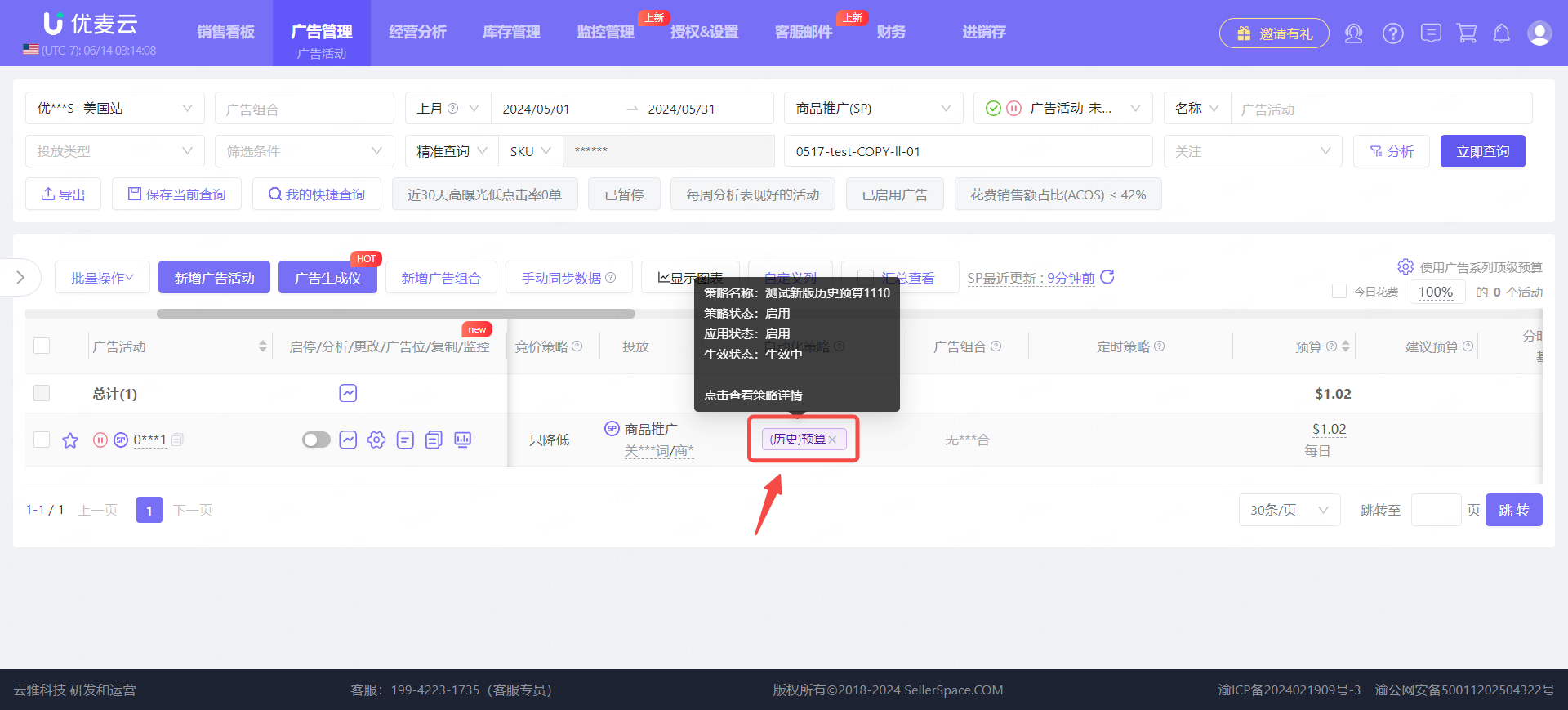 +
+
Click the strategy name to enter to view the setting details of the strategy. Such as: under what kind of performance will automatic adjustments be made, etc.
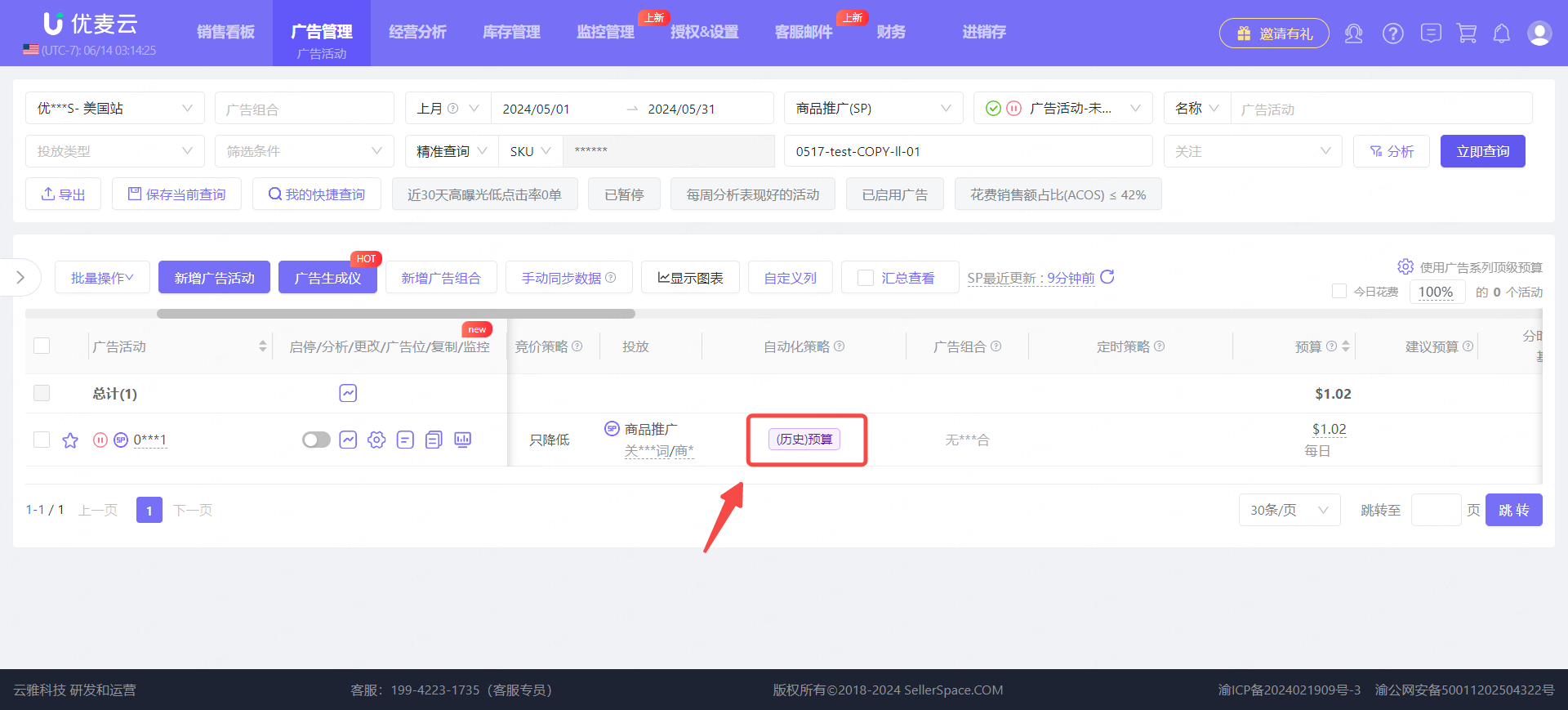 +
+
Automation strategy details page:
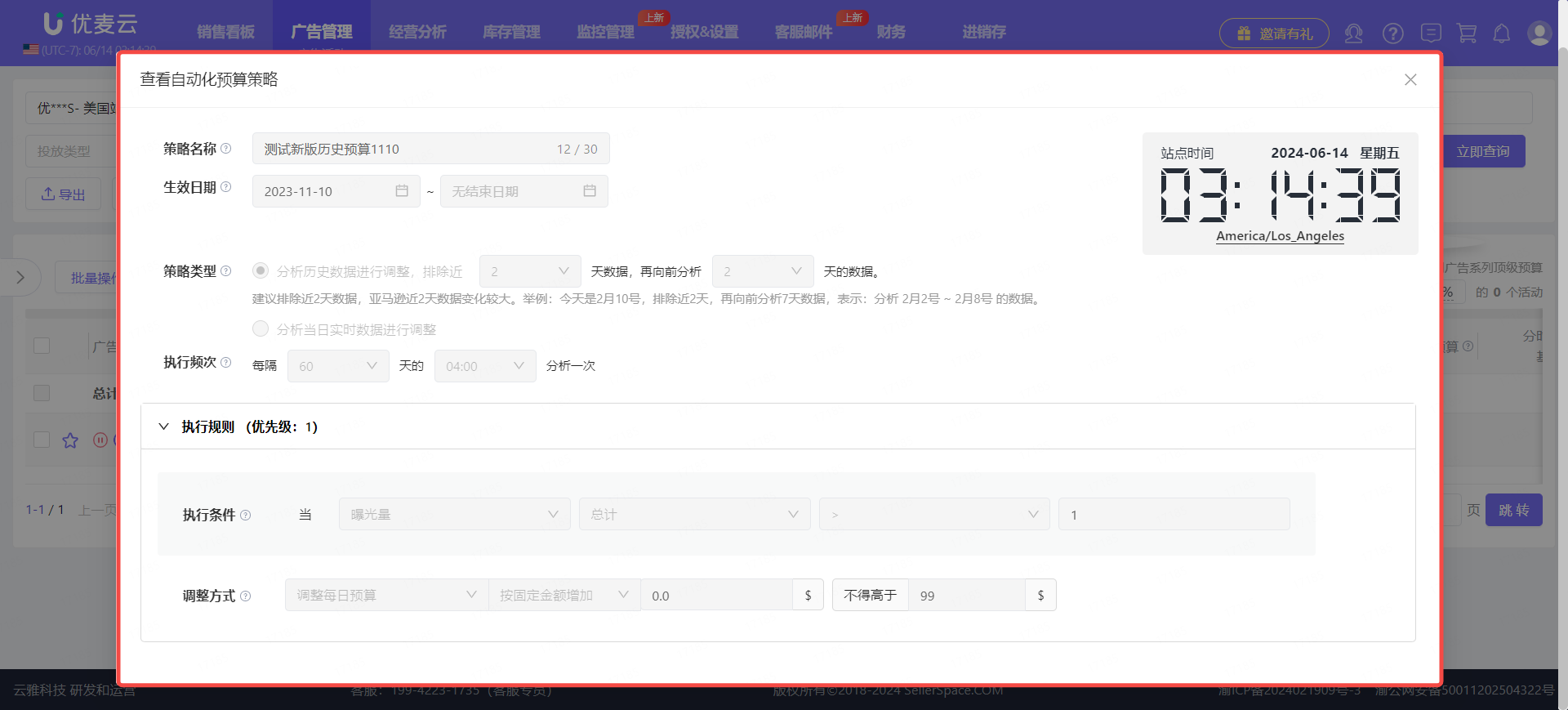 +
+
If we do not want a certain campaign to be applied to an automation strategy for adjustment, we can directly unbind it with one click.
Click 【×】 next to the strategy name to unbind.
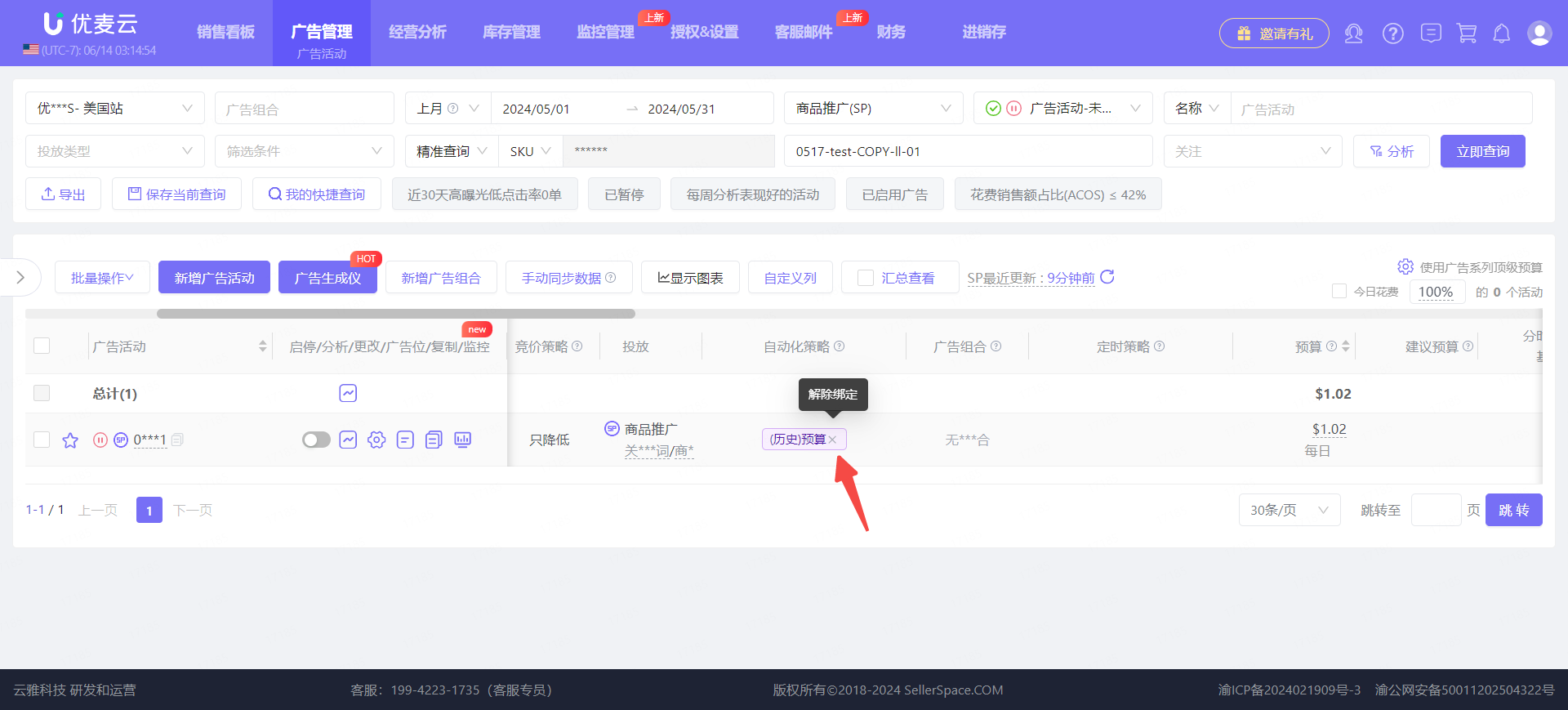 +
+
4.3 Scheduled Strategy
SellerSpace's 【Scheduled Strategy】 function can help us automatically adjust ad targeting by time to maximize ad investment efficiency.
Scheduled Strategy includes five major strategies: Bid Strategy, Budget Strategy, Budget Cap Strategy, Bid Adiustments Strateqy, and Scheduled Enable/Pause Strategy. Starting from five aspects: bid, budget, budget cap, Bid Adiustments, and Enable/Pause, refine ad targeting in all directions.
Among them, all scheduled adjustment strategies related to campaigns can be viewed and unbound on the campaign page (the operation method is consistent with the automation strategy).
Find the campaign bound to the scheduled strategy, and hover the mouse over the strategy name to view the status details of the automation strategy.
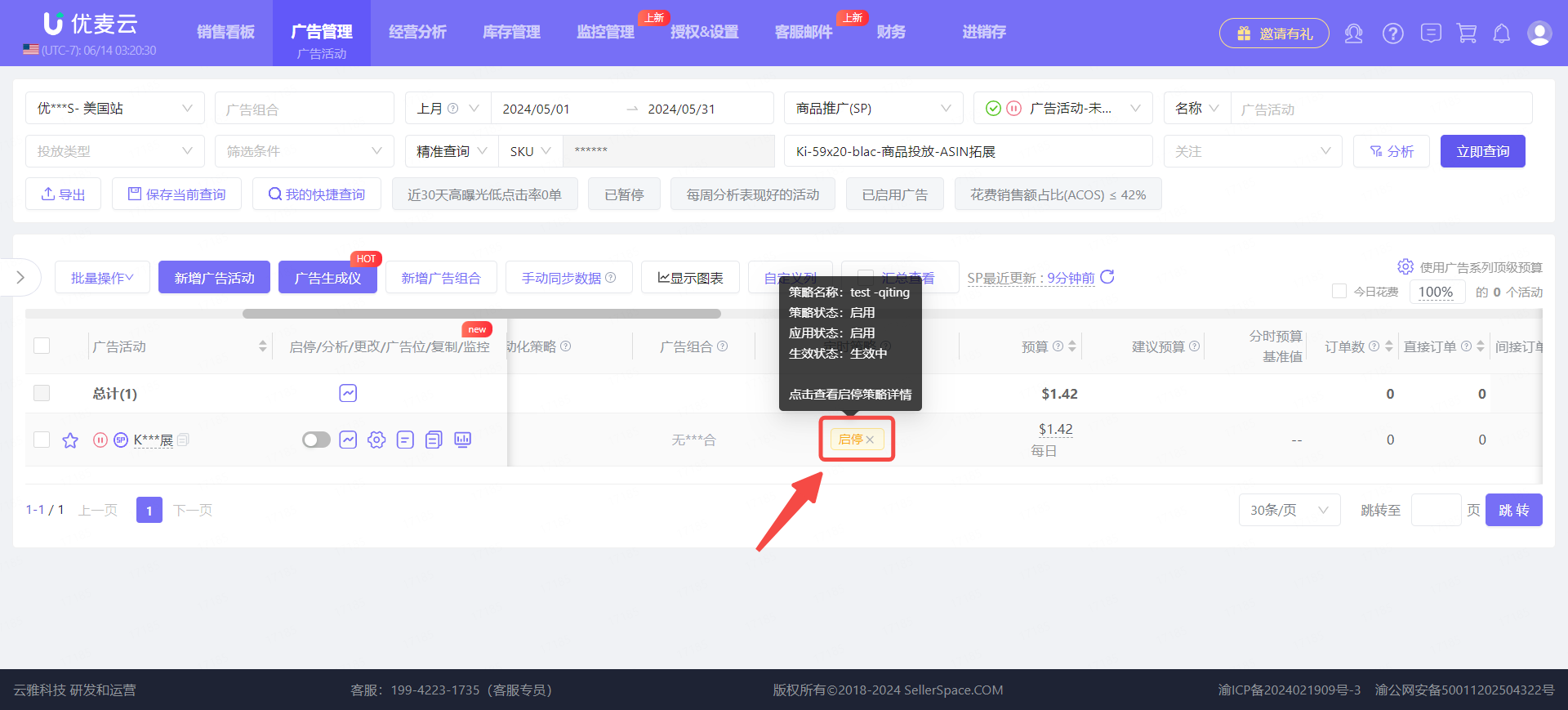 +
+
Click the strategy name to enter to view the setting details of the strategy. Such as: when will automatic adjustments be made, etc.
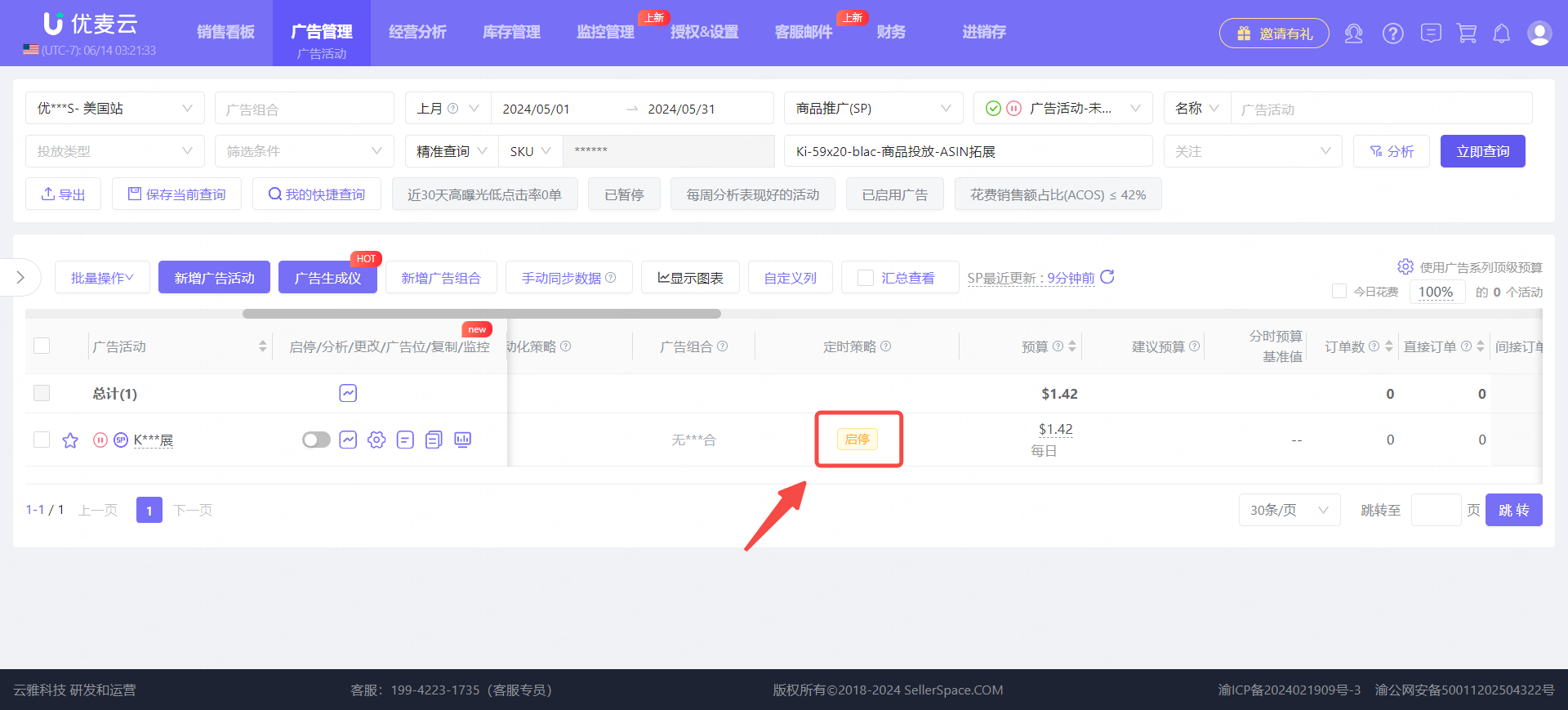 +
+
Scheduled strategy details:
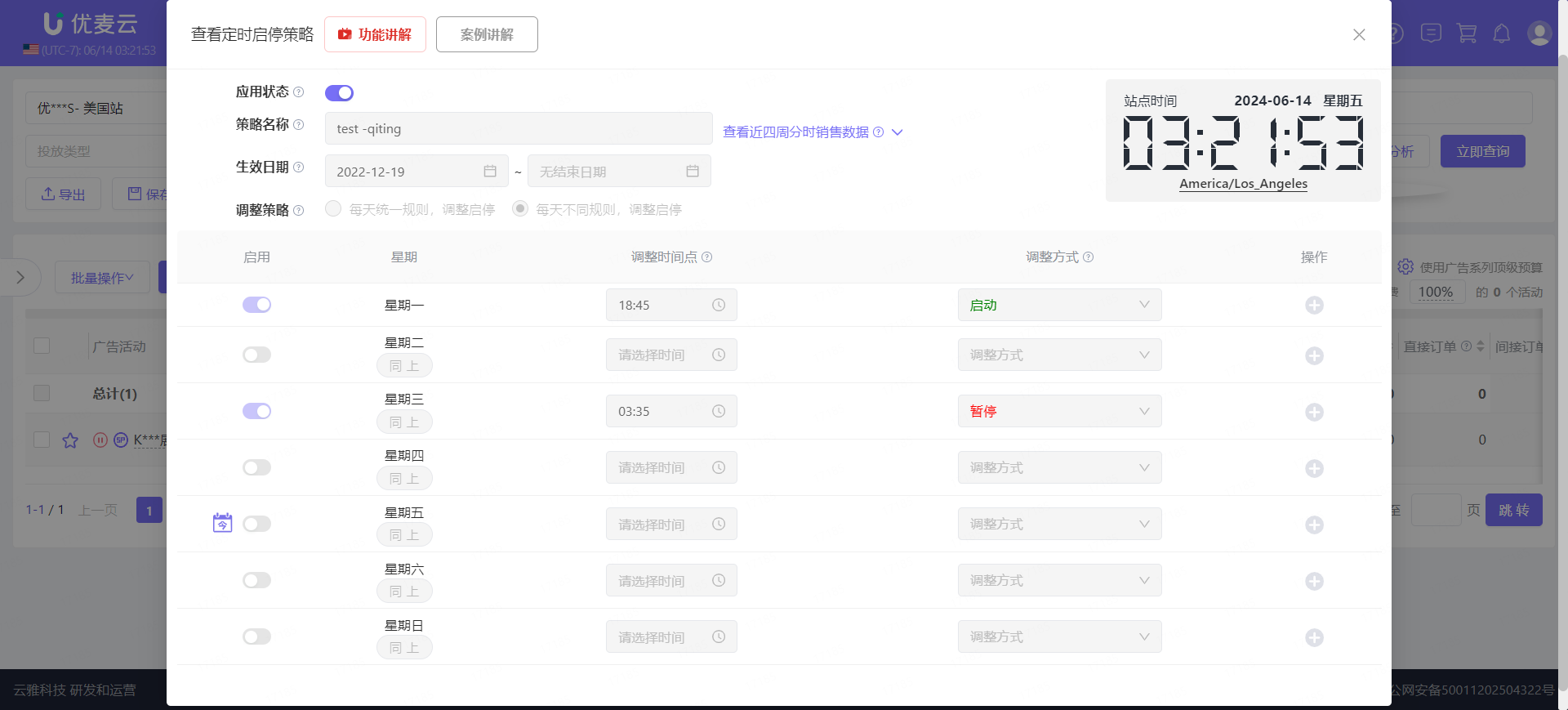 +
+
If we do not want a certain campaign to be bound to the current strategy for adjustment, we can directly unbind it with one click.
Click 【×】 next to the strategy name to unbind.
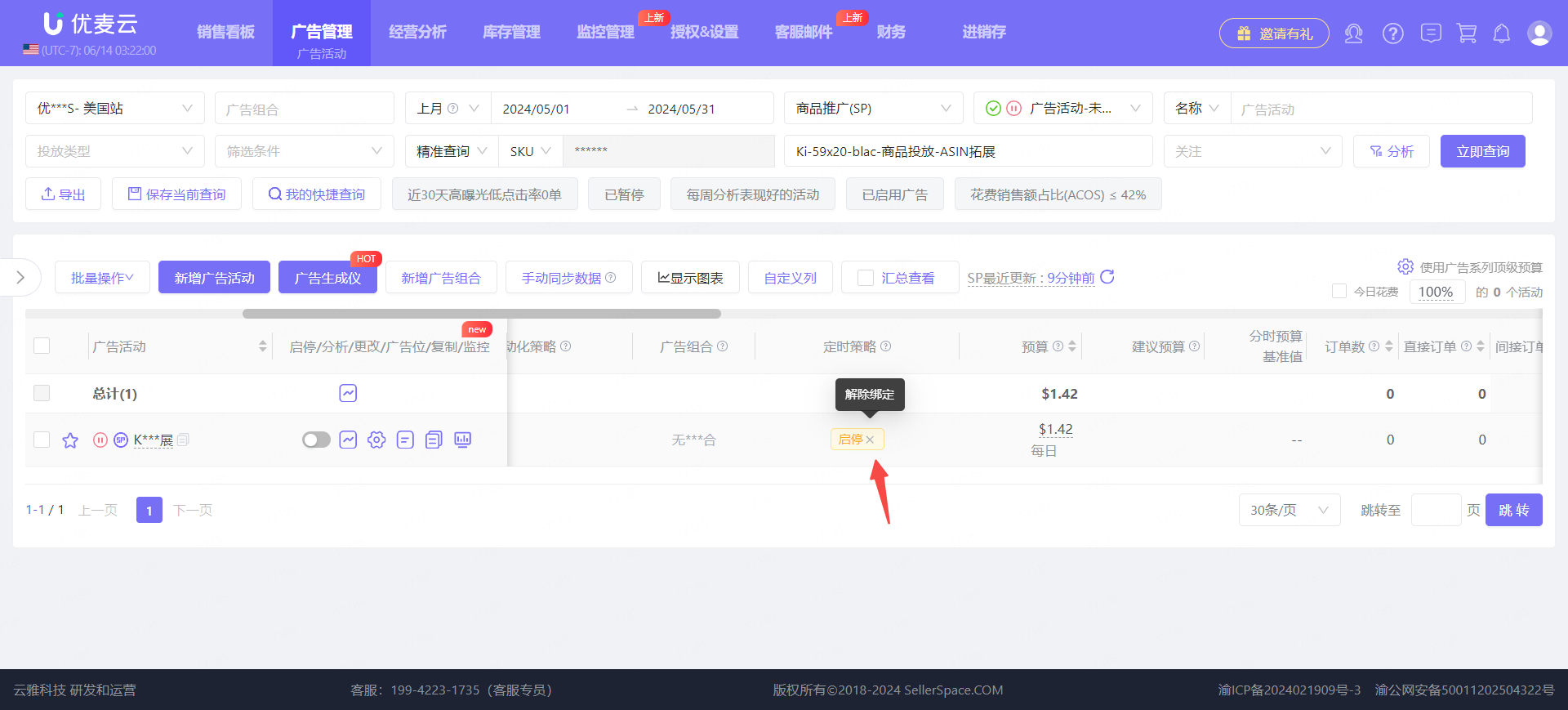 +
+





